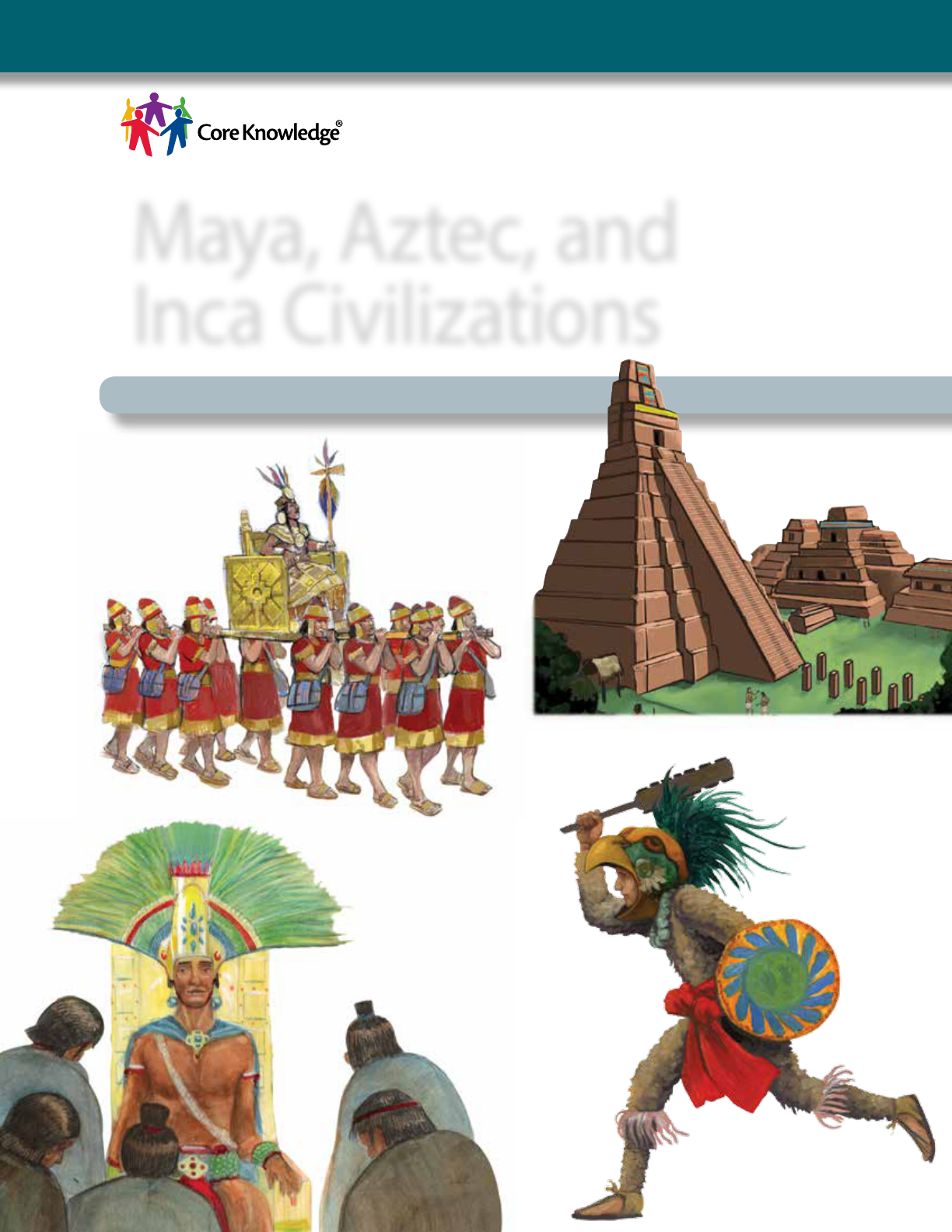
Maya, Aztec, and
Inca Civilizations
Grade 5 | Unit 2
Teacher Guide
History • GeoGrapHy • CiviCs • arts
Sapa Inca
Aztec Warrior
Moctezuma II
Maya Pyramids
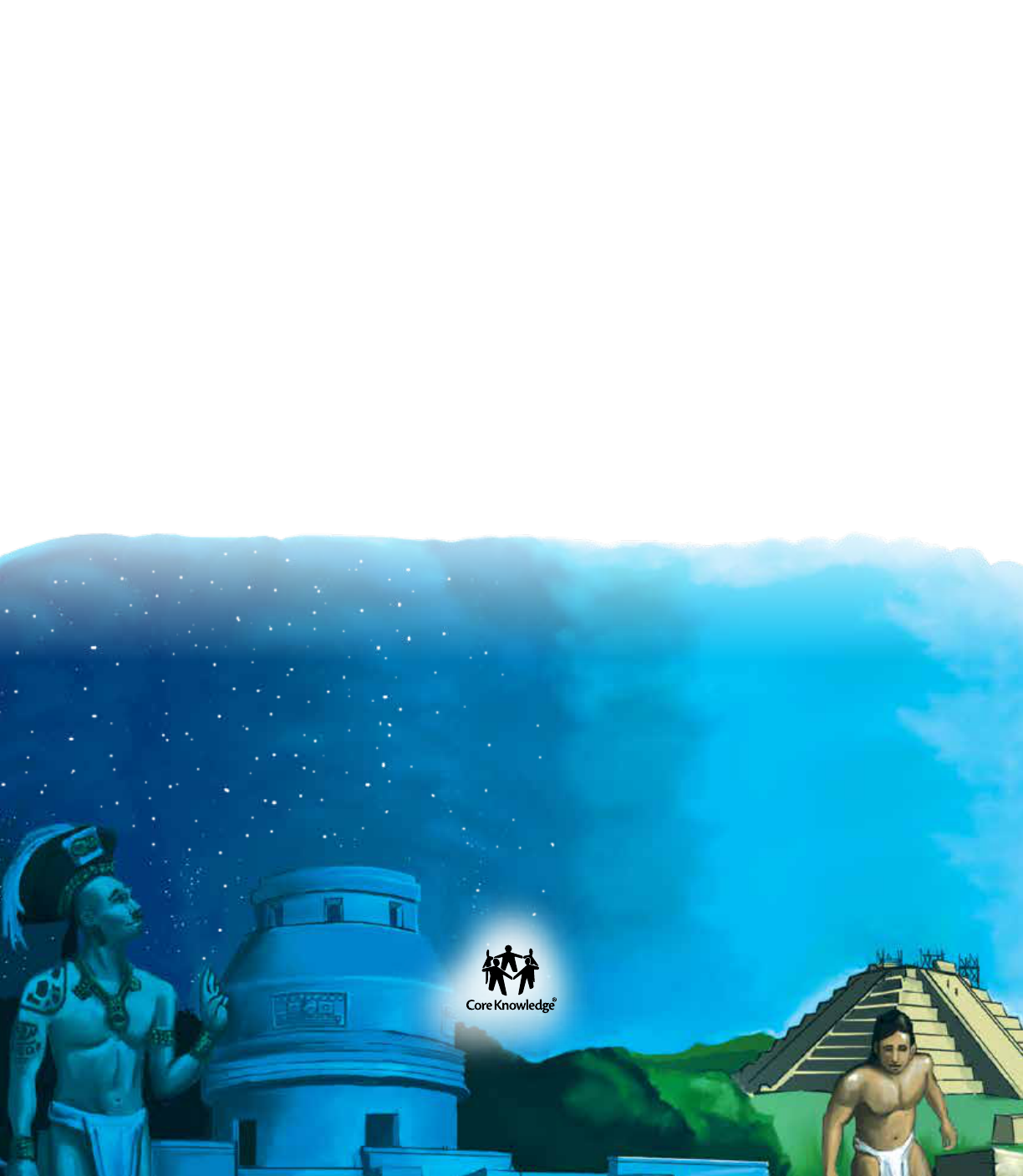
Maya, Aztec,
and Inca
Civilizations
Grade 5 | Unit 2
Teacher Guide

Creative Commons Licensing
This work is licensed under a
Creative Commons Attribution-NonCommercial-
ShareAlike 4.0 International License.
You are free:
to Share—to copy, distribute, and transmit the work
to Remix—to adapt the work
Under the following conditions:
Attribution—You must attribute the work in the
following manner:
This work is based on an original work of the Core
Knowledge® Foundation made available through
licensing under a Creative Commons Attribution-
NonCommercial-ShareAlike 4.0 International License.
This does not in any way imply that the Core
Knowledge Foundation endorses this work.
Noncommercial—You may not use this work for
commercial purposes.
Share Alike—If you alter, transform, or build upon this
work, you may distribute the resulting work only under
the same or similar license to this one.
With the understanding that:
For any reuse or distribution, you must make clear to
others the license terms of this work. The best way to
do this is with a link to this web page:
https://creativecommons.org/licenses/by-nc-sa/4.0/
Copyright © 2016 Core Knowledge Foundation
www.coreknowledge.org
All Rights Reserved.
Core Knowledge® and
Core Knowledge Curriculum Series™
are trademarks of the Core Knowledge Foundation.
Trademarks and trade names are shown in this book
strictly for illustrative and educational purposes and
are the property of their respective owners. References
herein should not be regarded as affecting the validity of
said trademarks and trade names.
ISBN: 978-1-68380-027-9

Maya, Aztec,
and Inca
Civilizations
Table of Contents
Introduction ...................................................... 1
Maya, Aztec, and Inca Civilizations Sample Pacing Guide .................. 14
Chapter 1 The Maya: Rainforest Civilization ............ 16
Chapter 2 Maya Science and Daily Life ....................30
Chapter 3 The Aztec: Empire Builders .................... 38
Chapter 4 Tenochtitlán: City of Wonder ................. 45
Chapter 5 The Inca: Lords of the Mountains ............ 52
Chapter 6 Inca Engineering ................................ 59
Chapter 7 The End of Two Empires ........................67
Teacher Resources ................................................. 77

1INTRODUCTION
UNIT 2
Introduction
About this unit
The Big Idea
The Maya, Aztec, and Inca had developed large, complex civilizations prior to the arrival of
theSpanish.
The civilizations of the Maya, Aztec, and Inca that once flourished in Central
and South America shared common elements. People practiced farming,
developed social structures, raised armies, and worshipped many gods.
The three civilizations were as diverse as the terrains in which they lived.
The Maya, known for developing a system of mathematics, thrived in the
rainforests of the Yucatán Peninsula, Belize, Honduras, and Guatemala from
about 200 to 900CE. From 1325 to 1521, the Aztec built a large and dense city
at Tenochtitlán, located on a swampy lake in the middle of a semi-arid basin
in central Mexico. The Inca were skilled engineers who built a vast system of
roads and bridges to unite their empire located high in the Andes Mountains,
reaching their peak in the 1400s and early 1500s.
It remains in question why and how the rainforest cities of the Classic Maya fell.
We know that Spanish explorers precipitated the destruction of both the Aztec
and Inca empires.

2 GRADE 5 | UNIT 2 | MAYA, AZTEC, AND INCA CIVILIZATIONS
What Students Should Already Know
Students in Core Knowledge schools should be familiar with:
Kindergarten
• The voyage of Columbus in 1492
- Queen Isabella and King Ferdinand of Spain
- The Niña, Pinta, and Santa Maria
- Columbus’s mistaken identification of “Indies” and “Indians”
- The idea of what was, for Europeans, a “New World”
Grade 1
• Maya, Aztec, and Inca Civilizations
- The development by the Maya of large population centers in the
rainforests of Mexico and Central America
- The establishment of a vast empire in central Mexico by the Aztec, its
capital of Tenochtitlán, and its emperor Moctezuma (Montezuma)
- The Inca’s establishment of a far-ranging empire in the Andes
Mountains of Peru and Chile, including Machu Picchu
• Columbus
• The conquistadors
- The search for gold and silver
• Hernán Cortés and the Aztec
• Francisco Pizarro and the Inca
• Diseases devastate Native American population
Grade 2
• The geography of South America
- Brazil: largest country in South America, Amazon River, rainforests
- Peru and Chile: Andes Mountains
- Locate: Venezuela, Colombia, Ecuador
- Bolivia: named after Simón Bolívar, “The Liberator”
- Argentina: the Pampa (also known as the Pampas)
- Main languages: Spanish and (in Brazil) Portuguese

3INTRODUCTION
Time Period Background
The items below refer to content in Grade 5.
Use a classroom timeline with students to
help them sequence and relate events from
different periods and groups.
c. 1500 BCE Earliest Mesoamerican villages
c. 200–900 CE Peak of Maya civilization
c. 1300s Beginning of Aztec Empire
c. 1300s Beginning of Inca Empire
1400s First cargo of enslaved people
from Africa brought by
Portuguese to their colonies
1492 Columbus’s first voyage to
the Americas
1496 Santo Domingo on
Hispaniola founded as
first permanent Spanish
settlement in Americas
1500s Spanish brought the first
cargo of enslaved Africans
to Hispaniola
1513 Balboa “discovers” the
Pacific Ocean
1517 Luther initiates Protestant
Reformation
1517 Ponce de León lands in Florida
1519–21 Magellan circumnavigates
the globe
1521 Conquest of the Aztec by
Cortés
1534 Conquest of the Inca by
Pizarro
1534 Cartier of France explores
the St. Lawrence River
1535 Most of central Mexico in
Spanish hands
1539–42 De Soto explores
NorthAmerica
1540 Most of Peru under Spanish
control
1545–65 Major silver discoveries in
Mexico and Peru
c. 1570 End of era of conquistadors
What Students Need to Learn
• Identify and locate Central America and South America on maps
andglobes
- Largest countries in South America: Brazil and Argentina
• Amazon River
• Andes Mountains
• The Maya
- Ancient Maya lived in what is now southern Mexico and parts of
Central America; their descendants still live there today
- Accomplishments as architects and artisans: pyramids and temples
- Development of a system of hieroglyphic writing
- Knowledge of astronomy and mathematics; use of a 365-day
calendar; early use of the concept of zero
• The Aztec
- At its height in the 1400s and early 1500s, the Aztec
empire covered much of what is now central Mexico
- The island city of Tenochtitlán: aqueducts, massive temples, etc.
- Moctezuma (also spelled Montezuma)
- Ruler-priests; practice of human sacrifice
• The Inca
- Ruled an empire stretching along the Pacific Coast of South America
- Built great cities (Machu Picchu, Cuzco) high in the Andes, connected
by a system of roads
• Conquistadors: Cortés and Pizarro
- Advantages of Spanish weaponry (guns and cannons)
- Devastation of native peoples by European diseases

4 GRADE 5 | UNIT 2 | MAYA, AZTEC, AND INCA CIVILIZATIONS
At A GlAnce
The most important ideas in Unit 2 are:
• Students should be able to locate Mexico, Central America, South America,
and the major countries, rivers, and mountain chain in South America on
maps and globes.
• Mesoamerica is a cultural area that covers central and southern Mexico as
well as northern Central America.
• The Maya people constructed large monumental buildings, created a
hieroglyphic writing system, employed a 365-day calendar, and developed
the concept of zero.
• The Aztec dominated central and southern Mexico through force and a
tribute system.
• The Inca developed a widespread empire in the Andes Mountains linked by
a network of roads.
• Both the Aztec and the Inca empires were conquered by Spanish
conquistadors; the Aztec Empire was conquered by Cortés, and the Inca
Empire was defeated by Pizarro.
• The Spanish had an advantage over native peoples because the former had
guns, cannons, and horses.
• European diseases killed thousands of native peoples, who had no natural
immunity against them.
WhAt teAchers need to KnoW
Geography Related to Central and South America
Central America is part of North America and contains the countries of Belize,
Costa Rica, El Salvador, Guatemala, Honduras, Nicaragua, and Panama. It is
bordered by the Caribbean Sea to the east and by the Pacific Ocean to the
west. To the south is the continent of South America. Central America is an
isthmus, or land bridge, that connects the two larger bodies of land.
South America is the fourth largest continent. To the east is the Atlantic
Ocean, and to the west, the Pacific Ocean. The Caribbean Sea borders South
America to the north. The Andes Mountains range from north to south on
the far western side of South America. The northern portion of the continent,
including much of Brazil, is covered by tropical rainforest.
Brazil
Brazil covers almost half of the South American continent and is the fifth
largest country in the world. Brazil is so large that it borders all but two (Chile
5INTRODUCTION
and Ecuador) of the other twelve countries in South America. The word Brazil
comes from the name of a tree found in the Amazon rainforest. Brazil lies
mostly within the tropical zone, so its climate is mainly warm and wet.
Most of the people live in urban areas, and about thirty percent of the
population lives on the coastal plain, a narrow strip along the Atlantic Ocean.
About seven hundred thousand native people live within the rainforest, but
many others live in cities and urban areas. The overall population is a mix of
descendants of Portuguese, native peoples, and Africans. Brazil was conquered
by Portugal, unlike most of South America, which was conquered by the
Spanish. Its official language is Portuguese.
Argentina
Argentina is the second largest country in South America. A long, narrow
country, Argentina extends east and south of the Andes and south of Paraguay
and Uruguay. The Andes form the boundary between Argentina and Chile.
The Gran Chaco, a region of low forests and grasslands, dominates Argentina’s
northern region. The south is a collection of barren plateaus, known as
Patagonia. The major economic area of Argentina is the Pampa (also known
as the Pampas) in the center of the country. This region of tall grasslands and
temperate climate is famous for its cattle ranches. About seventy percent of
the population lives in this area.
Most Argentines are descendants of Spanish colonists, and Spanish is the
official language.
Amazon River
The Amazon River forms at the junction of the Ucayali (/ooh*cah*yah*lee/) and
Marañón (/marn*yeown/) Rivers in northern Peru and empties into the Atlantic
Ocean through a delta in northern Brazil. The Amazon is the second longest
river in the world after the Nile but has the largest volume of water of any
river in the world. Hundreds of tributaries feed into it. The Amazon River basin
drains more than forty percent of South America. With no waterfalls, the river is
navigable for almost its entire length.
The Amazon flows through the world’s largest rainforest. This rainforest is
home to more than 2.5 million species of insects, tens of thousands of plants,
and over one thousand species of birds. In fact, almost half of all of the
world’s known species can be found in the Amazon. Mammals in the Amazon
rainforests include the tapir (a hoofed mammal), the nutria (an otter-like
creature), the great anteater, and various kinds of monkeys. Insects include
large, colorful butterflies. Birds include hummingbirds, toucans, and parrots. A
famous reptile dweller is the anaconda, a huge snake that squeezes its victims
to death; alligators are also common. Fish include flesh-eating piranhas and
the electric eel, capable of discharging a shock up to 650 volts. In recent years,
environmentalists have grown concerned about threats to the ecosystem
posed by logging and deforestation in this rainforest.

6 GRADE 5 | UNIT 2 | MAYA, AZTEC, AND INCA CIVILIZATIONS
The Amazon was named by a Spanish explorer, Francisco de Orellana, who
explored the river in 1541 and named it after women warriors he encountered
who reminded him of descriptions of the Amazons in ancient Greek mythology.
Andes Mountains
The Andes Mountains are over five thousand miles (8,047 km) in length, the
longest mountain system in the Western Hemisphere. The mountains begin as
four ranges in the Caribbean area on the northeastern coast of South America.
In Peru and Bolivia, the mountains form two parallel ranges that create a wide
plateau known as the Altiplano. The Andes then form a single range that
separates Chile from Argentina.
With an average height of 12,500 feet (3,810 m), the Andes are the second
highest mountain range in the world. (The Himalayas are the highest.) The
tallest peak in the Western Hemisphere is the Andes’s Mount Aconcagua,
which rises 22,835 feet (6,960 m) above sea level. Many of the mountains are
volcanoes, either active or dormant.
Approximately fifty to sixty percent of Peru’s people live in the Altiplano. About
a third of the country’s population lives in the narrow lowlands between the
Andes and the Pacific Ocean. Because the Andes run north to south along the
entire length of Chile, most Chileans live in the Central Valley region between
the Andes and low coastal mountains. The Central Valley, a fertile area, is home
to large cities, manufacturing centers, and agriculture.
The Andes Mountains were the home of the Inca people, whom students
in Core Knowledge schools studied in Grade 1 and will study again as part
of this unit. Core Knowledge students should also have learned about
Mount Aconcagua and the Andes during the Grade 4 geography subsection
“Mountains and Mountain Ranges.”
Historical Background
Students who studied the Core Knowledge curriculum in Grade 1 learned
about how civilizations in the Americas grew. The Maya civilization was located
in the Yucatán Peninsula and covered parts of Mexico, Belize, Honduras,
and Guatemala. Maya cities were built with large centers that included
large temples and often ball courts. Houses did not exist in the city centers,
indicating that they were meant for religious purposes. It’s important to note
that first-grade students were not exposed to the concept of human sacrifice
as a part of both Maya and Aztec religions that will be discussed in this unit.
Most Maya earned a living as farmers. Priests acted as the ruling class. The
Maya civilization disappeared around the year 900 CE; some of their cities
were in ruins by the time Spanish arrived in the 1600s.
The Aztec, also referred to as the Mexica, began as a group of nomadic
peoples who settled on Lake Texcoco in central Mexico around the year 1325.
Tenochtitlán, the Aztec capital, was the home to as many as three hundred
thousand people at the time of Spanish arrival. Students learned that the Aztec

7INTRODUCTION
built a vast empire through conquest. They did not directly rule but relied
on a tribute system to expand their wealth. Aztec rulers were seen as divine,
part man and part god. Moctezuma II was ruler of the Aztec when Cortés first
explored Mexico.
The Inca, like the Aztec, built an empire through conquest. From about 1438
to 1525, the Inca ruled an empire that stretched from Ecuador through parts
of Peru, Chile, Bolivia, and Argentina. Students learned that the Inca built an
advanced system of roads to maintain their empire. Roads, bridges, and other
infrastructure made it easier to travel and communicate to administer a vast
empire. Runners called chasquis carried messages throughout the Inca world.
To learn more background information about specific topics taught in Maya,
Aztec, and Inca Civilizations, go to www.coreknowledge.org/about-maya-
aztec-inca.
unit resources
Student Component
The Maya, Aztec, and Inca Civilizations Student Reader—seven chapters
Teacher Components
The Maya, Aztec, and Inca Civilizations Teacher Guide—seven chapters.
This includes lessons aligned to each chapter of the Maya, Aztec, and Inca
Civilizations Student Reader with a daily Check For Understanding and
Additional Activities, such as virtual field trips and cross-curricular art activities,
designed to reinforce the chapter content. A Unit Assessment, Performance
Task Assessment, Activity Pages, and Nonfiction Excerpts of primary source
documents are included at the end of this Teacher Guide in Teacher Resources,
beginning on page 77.
» The Unit Assessment tests knowledge of the entire unit, using
standard testing formats.
» The Performance Task Assessment requires students to apply and
share the knowledge learned during the unit through either an oral or
written presentation.
» The Activity Pages are designed to reinforce and extend content
taught in specific chapters throughout the unit. These optional
activities are intended to provide choices for teachers.
Maya, Aztec, and Inca Civilizations Timeline Image Cards include nine individual
images depicting significant events and individuals from the time when the
Maya, Aztec, and Inca civilizations flourished. In addition to an image, each

8 GRADE 5 | UNIT 2 | MAYA, AZTEC, AND INCA CIVILIZATIONS
card contains a caption, a chapter number, and the Big Question, which
outlines the focus of the chapter. You will construct a classroom Timeline with
students over the course of the entire unit. The Teacher Guide will prompt you,
lesson by lesson, as to which image card(s) to add to the Timeline. The Timeline
will be a powerful learning tool enabling you and your students to track
important themes and events as they occurred within this time period.
Timeline
Some advance preparation will be necessary prior to starting Unit2.
You will need to identify available wall space in your classroom of
approximately 10 feet on which you can post the Timeline Image
Cards over the course of the unit. The Timeline may be oriented either
vertically or horizontally, even wrapping around corners and multiple
walls, whatever works best in your classroom setting. Be creative—some
teachers hang a clothesline so that the image cards can be attached with
clothespins!
Create five time indicators or reference points for the Timeline. Write each
of the following dates on sentence strips or large index cards:
• 1500 BCE
• 200 CE
• 1300s
• 1400s
• 1500s
Affix these time indicators to your wall space, allowing sufficient space
between them to accommodate the actual number of image cards you will be
adding to each time period, as per the following diagram.
1500 BCE 200 CE 1300s 1400s 1500s
• • • • • • • • •
Chapter 1 2 3, 5 7 7
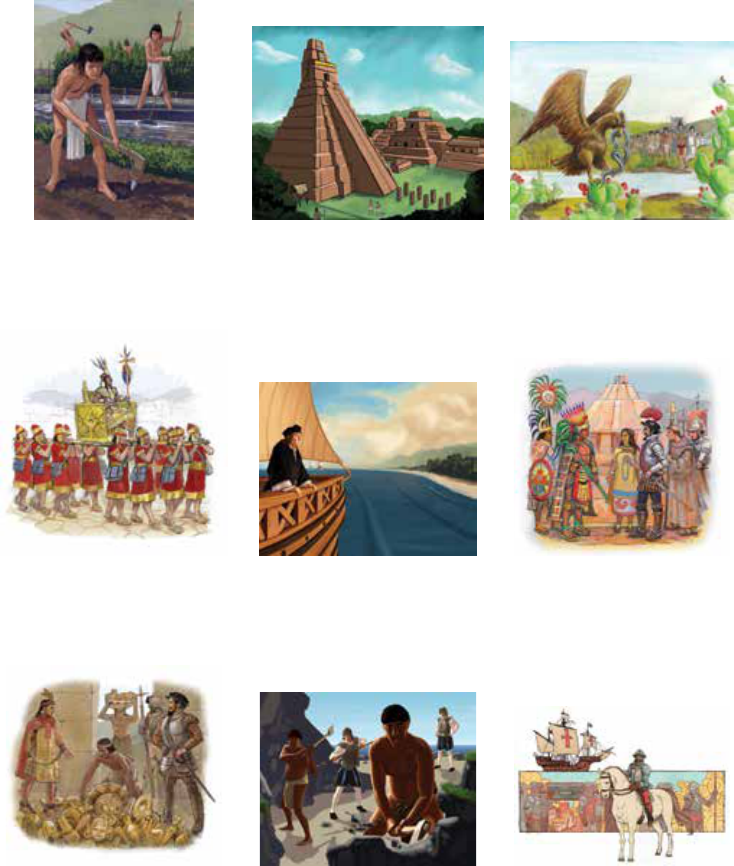
9INTRODUCTION
You will want to post all the time indicators on the wall at the outset before
you place any image cards on the timeline.
1500 BCE
200 CE
1300s
Chapter 1 Chapter 2 Chapter 3
1300s
1400s
1500s
Chapter 5 Chapter 7 Chapter 7
1500s
1500s
1500s
Chapter 7 Chapter 7 Chapter 7
The Timeline in Relation to the Content in the Student Reader Chapters
You will see that the events highlighted in the Unit 2 Timeline are in
chronological (date) order. The unit as a whole deals with large, thematic
concepts that are reflected in the Timeline.
Understanding References to Time in the Maya, Aztec, and Inca Civilizations Unit
As you read the text, you will become aware that in some instances general
time periods are referenced and that in other instances specific dates are cited.
For example, Chapter 1 states that the Maya civilization thrived over a period
of many centuries—200 CE to 900 CE. In addition, certain events are only

10 GRADE 5 | UNIT 2 | MAYA, AZTEC, AND INCA CIVILIZATIONS
generally fixed in time—for example, that the Inca Empire gained strength in
the 1400s. In contrast, there are many references to specific dates in history.
Here are just a few:
The Aztec founded their capital city by 1325.
Hernán Cortés launched his final attack on Tenochtitlán in 1521.
Pizarro began his quest to find the Inca Empire in 1527.
Because of this, it is important to explain to students that some chapters deal
with themes that were important throughout the entire era of civilization
building in the Americas. It is also important to note that our knowledge of
these times is inhibited by our limited understanding of or access to the record
keeping of these great civilizations. It is sometimes difficult to know precisely
when certain events took place. In some cases, however, the chapters deal with
important people and particular events that occur in specific moments in time.
In these instances, we do have specific knowledge and records. Therefore,
these chapters tend to contain specific dates for key events in history. In
addition, when citing specific dates, the abbreviation CE is used. It’s important
that students understand that the abbreviation CE is used to denote “Common
Era.” (BCE—before the Common Era—is also used here and in other units in
this program.) Students may have encountered CE before, or they may be more
familiar with the traditional abbreviations AD and BC. Both CE and AD refer
to the time period from the time of Jesus Christ. BCE and BC refer to the time
period before Christ.
Time to Talk About Time
Before you use the Timeline, discuss with students the concept of time and how
it is recorded. Here are several discussion points that you might use to promote
discussion. This discussion will allow students to explore the concept of time.
1. What is time?
2. How do we measure time?
3. How do we record time?
4. How does nature show the passing of time? (Encourage students to think
about days, months, and seasons.)
5. What is a specific date?
6. What is a time period?
7. What is the difference between a specific date and a time period?
8. What does CE mean?
9. What is a timeline?

11INTRODUCTION
usinG the teAcher Guide
Pacing Guide
The Maya, Aztec, and Inca Civilizations unit is one of thirteen history and
geography units in the Grade 5 Core Knowledge Curriculum Series™. A total of
ten days have been allocated to the Maya, Aztec, Inca unit. We recommend that
you do not exceed this number of instructional days to ensure that you have
sufficient instructional time to complete all Grade 5 units.
At the end of this Introduction, you will find a Sample Pacing Guide that provides
guidance as to how you might select and use the various resources in this unit
during the allotted time. However, there are many options and ways that you may
choose to individualize this unit for your students, based on their interests and
needs. So we have also provided you with a blank Pacing Guide that you may
use to reflect the activity choices and pacing for your class. If you plan to create a
customized pacing guide for your class, we strongly recommend that you preview
this entire unit and create your pacing guide before teaching the first chapter.
Reading Aloud
In each chapter, the teacher or a student volunteer will read various sections of
the text aloud. When you or a student reads aloud, always prompt students to
follow along. By following along in this way, students become more focused on
the text and may acquire a greater understanding of the content.
Turn and Talk
In the Guided Reading Supports section of each chapter, provide students
with opportunities to discuss the questions in pairs or in groups. Discussion
opportunities will allow students to more fully engage with the content and
will bring “to life” the themes or topics being discussed.
Big Questions
At the beginning of each Teacher Guide chapter, you will find a Big Question,
also found at the beginning of each Student Reader chapter. The Big Questions
are provided to help establish the bigger concepts and to provide a general
overview of the chapter. The Big Questions, by chapter, are:
Chapter Big Question
1
What do the ruins of the Maya tell you about the importance of
religion to their civilization?
2
Why is the 365-day solar calendar developed by the Maya
particularly impressive?

12 GRADE 5 | UNIT 2 | MAYA, AZTEC, AND INCA CIVILIZATIONS
3
Why did the Aztec make human sacrices?
4
What does the description of Tenochtitlán reveal about the Aztec
civilization?
5
Why were llamas so important to the Inca?
6
How did the Inca use their engineering skills to manage and grow
their empire?
7
What were the factors that contributed to the end of the Aztec
and Inca empires?
Core Vocabulary
Domain-specific vocabulary, phrases, and idioms highlighted in each chapter of
the Student Reader are listed at the beginning of each Teacher Guide chapter,
in the order in which they appear in the Student Reader. Student Reader page
numbers are also provided. The vocabulary, by chapter, are:
Chapter Vocabulary
1
Mesoamerica, Maya, civilization, architecture, archaeologist,
city-state, temple, hieroglyph, sacrice
2
astronomy, leap year, equinox, “initiation ceremony,” priest
3
Aztec, nomadic, empire, emperor
4
causeway, canal, scribe, codex, pictogram, litter, reign
5
Inca, conquistador, “geographical diversity,” plateau, clan, alpaca,
llama, census
6
ocial, engineer, mortar, suspension bridge, terrace
7
expedition, “religious ceremony,” smallpox, immunity, epidemic
Activity Pages
The following activity pages can be found in Teacher Resources, pages 88 to 100.
They are to be used with the chapter specified either for additional class work
or for homework. Be sure to make sufficient copies for your students prior to
conducting activities.
• Chapter 1—World Map (AP 1.1)
• Chapter 1—World Geography (AP 1.2)
• Chapter 1— Modern Map of North America, Central America, and South
America (AP 1.3)
• Chapter 1—Geography of the Americas (AP 1.4)
• Chapter 1—Map of the Maya, Aztec, and Inca Civilizations (AP 1.5)
• Chapter 1—Geography of the Maya, Aztec, and Inca Civilizations (AP 1.6)

13INTRODUCTION
• Chapters 2, 4, 6—Summary of the Maya, Aztec, and Inca Civilizations (AP 2.1)
• Chapter 4—Domain Vocabulary: Chapters 1–4 (AP 4.1)
• Chapter 4—Create a Codex (AP 4.2)
• Chapter 7—Domain Vocabulary: Chapters 5–7 (AP 7.1)
Nonction Excerpts
Two nonfiction excerpts can be found in Teacher Resources, pages 101 to 105.
They may be used with the chapter specified either for additional class work or
at the end of the unit as review and/or a culminating activity. Be sure to make
sufficient copies for your students prior to conducting the activities.
Nonfiction Excerpts
Chapter 7—Primary Source Document: Cortés’s Second Letter to Charles V (NFE 1)
Chapter 7—History of the Conquest of Peru (excerpts from the book by William
Hickling Prescott) (NFE 2)
Additional Activities
An Additional Activities section, related to material in the Student Reader, may
be found at the end of each chapter. You may choose from among the varied
activities when conducting lessons. Many of the activities include website links,
and you should check the links prior to using them in class.
booKs
Haberstroh, Marilyn & Panik, Sharon. A Quetzalcoatl Tale of Chocolate.
CO: University Press of Colorado, 2014.
DK Publishing. Aztec, Inca, & Maya. New York: DK Children, 2011.
Newman, Sandra. The Inca Empire (True Books: Ancient Civilizations). New York:
Scholastic, 2010.
Mathews, Sally Schofer. The Sad Night: The Story of an Aztec Victory and a Spanish
Loss. Boston: HMH Books for Young Readers, 2001
Maloy, Jackie. The Ancient Maya (True Books). Danbury, CT: Children’s Press, 2010

14 GRADE 5 | UNIT 2 | MAYA, AZTEC, AND INCA CIVILIZATIONS
Maya, aztec, and Inca cIvIlIzatIons sAmple pAcinG Guide
For schools using the Core Knowledge Sequence and/or CKLA
TG – Teacher Guide; SR – Student Reader; AP – Activity Page;
NFE – Nonfiction Excerpt
Week 1
Day 1 Day 2 Day 3 Day 4 Day 5
Maya, Aztec, and Inca Civilizations
“World Map,” “Modern
Map of North America,
Central America, and
South America,” and “Map
and Geography of the
Maya, Aztec, and Inca
Civilizations”
(TG, Chapter 1, Additional
Activities, AP 1.1, 1.3, 1.5,
and 1.6)
Homework: “World
Geography,” AP 1.2 and
“Geography of North
America, Central America,
and South America,” AP1.4
“The Maya:
Rainforest
Civilization”
(TG & SR, Chapter 1)
“Maya Science and Daily
Life”
Core Lesson
(TG & SR, Chapter 2)
“Summary of the
Maya, Aztec, and Inca
Civilizations”
(TG, Chapter 2, Additional
Activities, AP 2.1)
“The Aztec: Empire
Builders”
Core Lesson
(TG & SR, Chapter 3)
CKLA
“Personal Narratives” “Personal Narratives” “Personal Narratives” “Personal Narratives” “Personal Narratives”
Week 2
Day 6 Day 7 Day 8 Day 9 Day 10
Maya, Aztec, and Inca Civilizations
“Tenochtitlán: City of
Wonder”
Core Lesson
(TG & SR, Chapter 4)
Homework: “Summary
of the Maya, Aztec,
and Inca Civilizations”
(TG, Chapter4, Additional
Activities, AP 2.1)
“The Inca: Lords of the
Mountains”
Core Lesson
(TG & SR, Chapter 5)
Homework: “Domain
Vocabulary: Chapters 1–4,”
AP 4.1)
“Inca Engineering”
Core Lesson
(TG & SR, Chapter 6)
Homework: “Summary
of the Maya, Aztec,
and Inca Civilizations”
(TG, Chapter 6, Additional
Activities, AP 2.1)
“The End of Two Empires”
Core Lesson
(TG & SR, Chapter 7)
Homework: “Domain
Vocabulary: Chapters 5–7,”
AP 7.1)
Unit Assessment
(TG)
CKLA
“Personal Narratives” “Personal Narratives” “Personal Narratives” “Personal Narratives” “Personal Narratives”

15INTRODUCTION
Maya, aztec, and Inca cIvIlIzatIons pAcinG Guide
‘s Class
(A total of ten days have been allocated to the Maya, Aztec, and Inca Civilizations unit in order to
complete all Grade 5 history and geography units in the Core Knowledge Curriculum Series™.)
Week 1
Day 1 Day 2 Day 3 Day 4 Day 5
Maya, Aztec, and Inca Civilizations
CKLA
Week 2
Day 6 Day 7 Day 8 Day 9 Day 10
Maya, Aztec, and Inca Civilizations
CKLA

16 GRADE 5 | UNIT 2 | MAYA, AZTEC, AND INCA CIVILIZATIONS
CHAPTER 1
The Maya:
Rainforest Civilization
The Big Question: What do the ruins of the Maya tell you about the importance of
religion to their civilization?
Primary Focus Objectives
✓ Identify the Maya as one of the earliest civilizations in the Americas, located in parts of Mexico and
Central America. (RI.5.2)
✓ Describe how archaeologists have been able to learn more about the Maya civilization by studying
ancient ruins. (RI.5.2)
✓ Explain how religion was linked to Maya society. (RI.5.2)
✓ Understand the meaning of the following domain-specific vocabulary: Mesoamerica, Maya,
civilization, architecture, archaeologist, city-state, temple, hieroglyph, and sacrifice. (RI.3.4)
What Teachers Need to Know
For more background information about the content taught in this lesson, see:
www.coreknowledge.org/about-maya
Note: Prior to conducting the Core Lesson, in which students read Chapter 1 of the Maya, Aztec,
and Inca Civilizations Student Reader, we strongly recommend that you first conduct the activities
titled World Map (AP 1.1); World Geography (AP 1.2); Modern Map of North America, Central America,
and South America (AP 1.3); Geography of the Americas (AP 1.4); Map of the Maya, Aztec, and
Inca Civilizations (AP 1.5); and Geography of the Maya, Aztec, and Inca Civilizations (AP 1.6) found
in the Teacher Resources section beginning on page 88 and described at the end of this chapter
under Additional Activities. By first providing students with an understanding of the geographical
features of the Western Hemisphere and the relative and absolute locations of the Maya, Aztec,
and Inca civilizations, you will help students more fully understand the world in which these great
civilizationsdeveloped.

17CHAPTER 1 | THE MAYA: RAINFOREST CIVILIZATION
Materials Needed
• World Map (AP 1.1); World Geography (AP 1.2); Modern Map of North
America, Central America, and South America (AP 1.3); Geography of the
Americas (AP 1.4); Map of the Maya, Aztec, and Inca Civilizations (AP 1.5);
and Geography of the Maya, Aztec, and Inca Civilizations (AP 1.6) (Teacher
Resources, pages 88 to 93) (Note: Maps 1.3 and 1.5 will be used again in
Chapters 3, 5, 6, and 7.)
• enlarged versions of the maps on AP 1.1, AP 1.3, and AP 1.5
• red and green pencils
Core Vocabulary (Student Reader page numbers listed below)
Mesoamerica, n. a historical region that includes what are today the central
and southern parts of Mexico and the northern parts of Central America (2)
Example: The Maya were an early civilization of Mesoamerica.
Variation(s): Mesoamerican
Maya, n. a group of peoples who have inhabited a region that includes parts
of present-day Mexico and Central America from thousands of years ago to
the present. Before the arrival of Europeans, Maya cities thrived in rainforest
locations between about 200 to 900 CE. (4)
Example: The Maya were skilled builders who constructed great stone
structures.
Variation(s): Mayan, Mayas
civilization, n. a society, or group of people, with similar religious beliefs,
customs, language, and form of government (4)
Example: The Maya civilization thrived for hundreds of years.
Variation(s): civilizations
architecture, n. the style and construction of a building (4)
Example: By studying the architecture, we have learned a great deal about
the Maya.
Variation(s): architect
archaeologist, n. an expert in the study of ancient people and the objects from
their time period that remain, generally including stones, bones, and pottery (5)
Example: In studying the ruins, the archaeologist made many key findings
about the Maya.
Variation(s): archaeologists, archaeology
city-state, n. a city that is an independent political state with its own ruling
government (5)
Example: Thousands of people lived in the city-state of Copán.
Variation(s): city-states
Activity Pages
AP 1.1
AP 1.2
AP 1.3
AP 1.4
AP 1.5
AP 1.6

18 GRADE 5 | UNIT 2 | MAYA, AZTEC, AND INCA CIVILIZATIONS
temple, n. a building with a religious use or meaning (5)
Example: The priest performed important rituals at the temple.
Variation(s): temples
hieroglyph, n. a picture or symbol representing an idea, an object, a syllable,
or a sound (6)
Example: The scientist figured out what the hieroglyph meant.
Variation(s): hieroglyphs, hieroglyphic
sacrifice, v. to give or to kill something for a religious purpose (9)
Example: The loser of the ball game was doomed to be a human sacrifice.
Variation(s): sacrifices, sacrificed, sacrificial
the core lesson 35 min
Introduce the Maya, Aztec, and Inca Civilizations Student Reader 5 min
Distribute copies of the Maya, Aztec, and Inca Civilizations Student Reader.
Give students a few minutes to examine the reader and flip through its pages,
reading the Table of Contents and headings and looking at the illustrations.
Invite students to call out words or phrases that identify what they see and
what they should expect to be learning about in the unit. Record student
observations on the board or chart paper. Students are likely to mention things
such as buildings, carvings and writing, games, warfare, and cities—all of which
are indicators of the development of civilization.
Introduce the vocabulary word civilization to students: “a society, or group
of people, with similar religious beliefs, customs, language, and form of
government.” Students who studied the Grade 1 Core Knowledge curriculum
have seen this definition before. Review the meaning of the word with
students. Explain that civilizations often include larger populations of people
living in cities, as well as individuals who farm. Characteristics include some
form of government directed by leaders and a common language with some
form of writing, as well as religious beliefs that impact daily life. Ask students
who have studied the Core Knowledge curriculum in earlier grades to think
about civilizations they have studied. Students in Grade 1 studied the Inca,
Aztec, and Maya. Students in Grade 2 studied ancient Greece. Students in
Grade 3 studied ancient Rome.
It’s important for students to recognize that while the Maya civilization reached
its peak from 200 to 900 CE and that this is the time period they will be
learning about in more detail, the Maya culture began to emerge long before
that time. There is evidence that Mesoamerican civilization began to emerge as
early as 1500 BCE.
Tell students that they will be reading about events and developments that
took place in the Americas before the Age of Exploration, a period that began

19CHAPTER 1 | THE MAYA: RAINFOREST CIVILIZATION
in the late 1400s with Christopher Columbus’s encounter with the New World.
We know about this time mainly through the study of objects and buildings
the people left behind. Students will also be writing about the first contacts
between Europeans and these great civilizations. These events are known
mainly based on the writings of the Europeans.
Introduce “The Maya: Rainforest Civilization” 5 min
Students who used this history program in earlier grades have already studied
the rise and fall of the Maya, Aztec, and Inca civilizations. They have also studied
the geography of South America. Remind them how the arrival of Europeans
was a key turning point in the history of the great civilizations of the Americas.
This began with the journey of Christopher Columbus in 1492. After Columbus’s
encounter with what the people of Europe called a “new world,” European
powers raced to send explorers and conquerors to exploit the land, extract
wealth, and expand their empires.
Refer students to the map on page 3. If students have already completed the
Map of the Maya, Aztec, and Inca Civilizations (AP 1.5) and the Modern Map of
North America, Central America, and South America (AP 1.3), you may want to
ask students to take out these activity pages for reference. You may also want to
display enlarged versions of these activity pages for all students to look at while
they refer to the map on page 3.
Orient students by explaining that the Maya civilization was largely located in
the present-day country of Mexico and also in parts of Guatemala, Honduras,
and Belize. Have students locate these places on the Modern Map of North
America, Central America, and South America (AP 1.3) and circle them in green
pencil. Explain that this is a tropical region, largely covered in rainforest. Ask:
How do you think this environment may have influenced the rise and fall of
these civilizations?
Ask students to first identify characteristics of a rainforest and tropical
environment. Students may respond that rainforests have tall trees and dense
greenery. Tropical environments are generally humid and can experience heavy
rainfall. Students may also note that rainforests are the home to many different
types of animals.
Select five different items (for example a glasses case, car keys, or a piece of fruit)
and place them at the front of the room. Ask students to take a moment to look
at the items. What can they tell about the person who owns these things? Have
students share their responses out loud. Explain to students that much of what
we know about past civilizations comes from the things they’ve left behind.
We have learned many clues about what was important to the Maya from their
buildings. Call attention to the Big Question. Encourage students to look for ways
Maya ruins inform people today about the role of religion in Maya civilization.
Note: it is important to understand the distinction between the words Maya
and Mayan. Explain to students that the word Maya is used as both a noun
Activity Pages
AP 1.3
AP 1.5

20 GRADE 5 | UNIT 2 | MAYA, AZTEC, AND INCA CIVILIZATIONS
and an adjective that describes the people and the various aspects of their
civilization and culture. An example of the correct use of the word as a noun
is, “The ancient Maya lived in parts of present-day Mexico until about the year
900 CE.” An example of the word as an adjective is, “Archaeologists study Maya
writing to better understand the civilization’s history and culture.” The word
Mayan describes the language spoken by the Maya people. An example of
this word used correctly is, “People living in parts of Mexico continue to speak
Mayan today.”
Guided Reading Supports for “The Maya: Rainforest Civilization” 25 min
When you or a student reads aloud, always prompt students to follow along.
By following along, students may acquire a greater understanding of the
content. Remember also to provide classroom discussion opportunities.
“The Vanishing Civilization,” Pages 2–4
Scaffold understanding as follows:
Invite a volunteer to read the title of this section and the opening paragraph.
CORE VOCABULARY—Note the term Mesoamerica when it is encountered
in the text. Explain to the class that this term refers to a historical region, the
place where certain civilizations emerged, and it is not used to describe or
locate any modern-day place.
SUPPORT—Help students recognize that this illustration is a map showing
the land that is today Mexico, Central America, and the northern part of
South America.
Ask students to read quietly to themselves the remainder of this section
up to the next section entitled “Ruins in the Rainforest.”
After students read the text, ask the following questions:
LITERAL—The text refers to a key question about the Maya civilization.
What is the mystery?
» The mystery is the disappearance of the Maya cities that were part of
the thriving Maya culture from 200 to 900 CE.
SUPPORT—The title of this section is “The Vanishing Civilization.” What is
a synonym for vanishing?
» Disappearing is a synonym for vanishing.
INFERENTIAL—Why do you think the disappearance of the Maya cities is
considered a mystery?
» The cities were thriving and strong, but then they ceased to exist.
Nobody is sure why this happened.
NORTH AMERICA
Atlantic Ocean
The Maya
The Aztec
CENTRAL
AMERICA
SOUTH AMERICA
The Inca
N
S
E
W
Pacic Ocean
3
In the centuries before Europeans came to the Americas, great civilizations thrived in present-day
Mexico, Central-America, and South America. These included the Maya, Az tec, and Inca.
G5_U2_Chap01_SE.indd 3 7/1/16 2:02 PM
Page 3
NORTH AMERICA
Atlantic Ocean
The Maya
The Aztec
CENTRAL
AMERICA
SOUTH AMERICA
The Inca
N
S
E
W
Pacic Ocean
Chapter 1
The Maya: Rainforest
Civilization
The Vanishing Civilization Do you
like mysteries? Try this one: More
than a thousand years ago, a great
civilization of American Indian peoples
built cities across Mesoamerica—an
area today that is made up of parts
of Mexico and Central America. They
built stone temples and pyramids that rose far above the
forest treetops.
The Maya, one group of native peoples,
discovered important mathematical ideas.
They also studied the movements of the
stars. Using this knowledge, the Maya
made a calendar almost as accurate as the
one we use today. Then, after hundreds
of yearsof growth, many key elements of
Mayacivilization disappeared. The people abandoned their
once-thriving cities. This great urban society and many of
2
The Big Question
What do the ruins
of the Maya tell you
about the importance
of religion to their
civilization?
Vocabulary
Mesoamerica, n. a
historical region that
includes what are today
the central and southern
parts of Mexico and
the northern parts of
Central America
G5_U2_Chap01_SE.indd 2 7/1/16 2:02 PM
Page 2

21CHAPTER 1 | THE MAYA: RAINFOREST CIVILIZATION
LITERAL—What happened to the people and culture that built the great
Maya cities?
» Archaeologists and historians are unsure as to what happened to the
Maya people. Their historical records stop around the year 900 CE, and
their temples and buildings fell into ruin.
INFERENTIAL—The text says that the brief history of the disappearance
of the Maya’s cities reads like a movie plot. What do you think this means?
» The disappearance of the cities was abrupt and in some sense
surprising, but it opens up key research questions for archaeologists.
SUPPORT—Movie plots are often fiction and have unexpected events
and endings. How might the disappearance of the Maya cities be similar?
» Answers may vary, but students’ responses should show they understand
that the disappearance of Maya cities may have a cause or causes that no
one has yet thought of.
“Ruins in the Rainforest” and “Mysterious Writing,” Pages 4–7
Scaffold understanding as follows
CORE VOCABULARY—Choose a volunteer to read the first two
paragraphs under the heading “Ruins in the Rainforest,” on pages 4
and 5. Discuss the meanings of the words architecture and archaeologist
when they are encountered.
Ask students to refer to AP 1.5 and point to the city of Copán. Ask if Copán
is located in North America (Mexico), Central America, or South America.
CORE VOCABULARY—Choose a volunteer to read the second full
paragraph on page 5. Note the term city-state. Point out that this term is
a compound word made up of two words—city and state. Ask students to
examine the definition of the word included in their reader to explain the
relationship between the two words that make it up.
CORE VOCABULARY—Have the students read the last paragraph
beginning on the bottom of page 5 and continuing on page 6 to
themselves. Point out the term temple. Use the illustration on the page to
help define the term temple. Point out to students that the temple featured
in the image is a pyramid. It has sloped sides, and the building on top is
the temple.
CORE VOCABULARY—Call attention to the term hieroglyphs in the next
section, “Mysterious Writing,” and clearly pronounce the word for students.
Explain that Maya writing was often carved into stone structures, like the
stairway shown in the picture. Have the students read the entire section
of “Mysterious Writing” on pages 6–7 to themselves.
5
about their findings. Their tales and drawings
inspired worldwide interest in the history of
the Maya.
Since the mid-1800s, archaeologists
and other experts have continued to
study these remarkable people. Recent
breakthroughs in research have revealed
just how much the Maya accomplished.
Let’s take a closer look at what we know
about them and what still remains
amystery.
At its peak, the Maya civilization included
a large group of city-states that were
allied with, fought, and conquered each
other. These cities were located on the Yucatán Peninsula
in what is today southeastern Mexico and the countries
of Guatemala,
Honduras, and Belize.
Archaeologists believe
that Maya civilization
reached its greatest
extent between about
200 and 900 CE.
The largest buildings
in Maya cities were
pyramids that also
served as temples.
Maya pyramids were grand monuments that reached
toward the sky.
Vocabulary
archaeologist, n. an
expert in the study
of ancient people
and the objects from
their time period that
remain, generally
including stones and
bones, and pottery
city-state, n. a
city that is an
independent political
state with its own
ruling government
temple, n. a building
with a religious use or
meaning
G5_U2_Chap01_SE.indd 5 7/1/16 2:02 PM
Page 5
6
These structures served religious purposes. From their size, it is
clear that religion was a key part of Maya life. Maya pyramids rose
high above the surrounding treetops. Maya pyramids were some
of the tallest structures in the Americas until 1902. That year, the
twenty-two-story Flatiron Building was constructed in New York City.
Mysterious Writing
Archaeologists found hieroglyphs
(/hie*roe*glifs/) carved into Maya buildings
and monuments. The Temple of the
Hieroglyphic Stairway stands in Copán. A
climb up this staircase is a journey back in
time. Each of the sixty-three steps has a story
to tell. Carved symbols called
glyphs name all of the rulers of
Copán. The glyphs also explain
their military victories. The
American explorers who visited
this site in 1839 marveled over
these carvings. They could not,
however, figure out what the
symbols meant. For a long time,
neither could any other experts.
Hieroglyphs are like a code.
You must crack the code
to read the messages.
Mayan hieroglyphs are
complicated and include
Vocabulary
hieroglyph, n. a
picture or symbol
representing an idea,
an object, a syllable,
or a sound
The Mayan hieroglyphs were carved into
each step of this stairway.
G5_U2_Chap01_SE.indd 6 7/1/16 2:03 PM
Page 6
4
its traditions were mysteriously
transformed, although Mayan-speaking
people continue in this part of
Mesoamerica to the present.
This may sound like the plot of a science-
fiction movie, but it isn’t. In fact, it is a short
history of the Maya (/mah*yuh/), one of
the first great civilizations of the Americas
that flourished between 200 and 900 CE.
Ruins in the Rain Forest
In 1839, two American explorers heard stories
of mysterious ruins in the rain forests of
Central America. Curious, they set out to see
for themselves. The two men first explored
the remains of the
city of Copán
(/koh*pahn/) in
the present-day
country of
Honduras. From the architecture, it
was clear the ruins had been left by
an ancient and advanced civilization.
The two Americans continued their
journey, exploring many other ruins.
Then, they returned to the United
States and wrote a best-selling book
Archaeologists still study the remarkable Maya.
Vocabulary
architecture, n. the
style and construction
of a building
Vocabulary
Maya, n. a group of
peoples who have
inhabited a region
that includes parts of
present-day Mexico and
Central America from
thousands of years
ago to the present.
Before the arrival
of Europeans, Maya
cities and civilization
thrived in rainforest
locations between
about 200 and 900CE.
civilization, n. a society,
or group of people,
with similar religious
beliefs, customs,
language, and form of
government
G5_U2_Chap01_SE.indd 4 7/1/16 2:02 PM
Page 4

22 GRADE 5 | UNIT 2 | MAYA, AZTEC, AND INCA CIVILIZATIONS
After students read the section, ask the following questions:
LITERAL—What did the two American explorers find in the rainforest
in1839?
» The explorers heard about ruins located in Copán. They found the
Maya city and explored the area. They wrote a book that sparked
worldwide interest in the civilization.
LITERAL—How was the Maya civilization organized?
» The Maya civilization was broken into city-states. The Maya people
spoke a common language, but they were not a unified country.
Instead, city-states allied with each other but also went to war and
conquered each other.
LITERAL—Why were pyramids important in Maya culture?
» Pyramids were constructed as platforms for large temples that were
used for religious purposes.
LITERAL—In what way are Maya hieroglyphs like a code?
» In hieroglyphic writing, each symbol represents, or is code for, something
else. You can only understand the writing if you know the code.
LITERAL—Were the original American archaeologists able to translate and
understand the meaning of the hieroglyphs? Why or why not?
» The original archaeologists could not understand the meaning of
the hieroglyphs. It was like cracking a very complex code. Once later
archaeologists determined the meaning of the “code,” however, they
were able to learn much about the Maya civilization.
INFERENTIAL—Why do you think cracking the Maya code has enabled
experts to learn a lot about the Maya?
» When people gained the ability to read Maya hieroglyphs, they could
read what had been recorded during the time period when Maya
civilization actually existed. These written records provided much
information about Maya culture and history.
CHALLENGE—The Maya used hieroglyphs as a way to record events,
history, and religious beliefs. What other civilization do you know of that
used hieroglyphs as its form of writing?
» The ancient Egyptians also used hieroglyphs to write.
7
more than eighthundred symbols. It wasn’t until the 1960s that
archaeologists began to crack the code with early computers.
Since then, we have learned a great deal about the ancient Maya.
Breath on a Mirror
We have learned that daily life for the Maya revolved around family,
farming, and service to the gods. No person or group took any
important action without consulting the gods. Priests decided
which days were best for planting a field, starting a war, or building
a hut. The Maya believed the gods were much wiser than humans.
According to Maya legend, the first people could see everything.
The creator gods decided that this gave people too much
power. So the gods decided to limit human sight and power.
The Maya sacred book, the Popol Vuh, explains that the gods
purposely clouded human understanding. As a result, a human’s
view of the world is unclear. The Popol Vuh explains that human
understanding is “like breath on a mirror.”
Serious Play
Breaking the hieroglyph code also helped archaeologists understand
how the Maya spent some of their time. A specific kind of ball court
can be found in many Maya cities. Archaeologists were puzzled
about these courts, which varied in size. Some were the size of
volleyball courts. Others were larger than football fields.
Archaeologists now think the Maya played a game called pok-ta-
pok in these courts. They believe the goal of pok-ta-pok was to
drive a solid rubber ball to a specific place on the opponents’ side
G5_U2_Chap01_SE.indd 7 7/1/16 2:03 PM
Page 7

23CHAPTER 1 | THE MAYA: RAINFOREST CIVILIZATION
“Breath on a Mirror” and “Serious Play,” Pages 7–9
Have students read the section “Breath on a Mirror” independently.
After students read the text, ask the following questions:
LITERAL—Why, according to Maya legend, did the gods limit human
understanding?
» The gods limited human understanding in order to make humans less
powerful.
INFERENTIAL—How does the phrase “like breath on a mirror” explain the
Maya belief about human understanding?
» When a person breathes on a mirror, it makes it hard to see details in
the image it’s reflecting. In the same way, people’s ability to see the
world clearly and in detail is obscured by the gods.
Scaffold understanding as follows:
CORE VOCABULARY—Call attention to the word sacrifice on page 9,
found in the section “Serious Play,” and discuss its meaning. Help students
understand that the Maya believed that human sacrifice was the greatest
gift that could be made to the gods they worshipped.
Have students refer to Map of the Maya, Aztec, and Inca Civilizations (AP 1.5),
and locate Chichén Itzá on the map. Have students volunteer to read
the section “Serious Play” out loud.
SUPPORT—After students read the second full paragraph on page 8, call
attention to the idiom “the stakes are high.” Explain to students that when
the stakes are high, a person has a lot to lose.
SUPPORT—Call attention to the word spectators in the third full paragraph
on page 8. Explain that spectators are people who go to an event to watch.
The Maya watched pok-ta-pok much like people today go to watch games
such as football, baseball, or basketball.
SUPPORT—In the fifth full paragraph of page 8, explain the context of
the statement, “There is no whistle for a foul.” Many students may play a
sport or have seen one in person or on television. The Maya did not have
referees to make sure the athletes were playing fairly in pok-ta-pok. This
shows that they were probably very ruthless while playing.
After students read the text, ask the following questions:
LITERAL—What is pok-ta-pok?
» Pok-ta-pok is a ball game that the Maya played on the ball courts that
are found at the sites of many Maya cities.
8
of the court. The balls were heavy. Also, players were not allowed
to use their hands or feet! Experts think players may have had to
use hips, elbows, knees, or other body parts to score a goal.
The court at the Maya site of Chichén Itzá (/chee*chen/eet*sah/) is
still visible today. This court had stone rings, and a team could win
the game by driving the hard rubber ball through the ring on the
other team’s side of the court. If you use your imagination, you can
picture what a pok-ta-pok game might have looked like.
Imagine big, strong pok-ta-pok players stepping out onto the
court. They wear leather helmets and pads to protect themselves.
You can also see that they are worried. They know that the stakes
are high. Pok-ta-pok is a game with religious meaning. The Maya
think of it as a battle between good and evil. The only way to find
out who’s good and who’s evil is to see who wins the game.
Hundreds of spectators have gathered. They see the game as
meaningful for their world and as a way of honoring the gods.
When the game begins, the sound of the bouncing ball is added
to the cheers. Pok, pok, pok! goes the hard rubber ball as it hits the
ground and bounces off the walls of the court.
One player begins driving the ball up the court with his elbows,
knees, and chest. Then, whack! Another player slams into him and
knocks him to the ground. There is no whistle for a foul. In fact,
there are very few rules in pok-ta-pok! The game continues until
someone finally scores. The side that scores wins the game.
The winners of pok-ta-pok games were considered to be the “good”
ones. Sometimes they were rewarded with clothing andjewelry.
G5_U2_Chap01_SE.indd 8 7/1/16 2:03 PM
Page 8
7
more than eighthundred symbols. It wasn’t until the 1960s that
archaeologists began to crack the code with early computers.
Since then, we have learned a great deal about the ancient Maya.
Breath on a Mirror
We have learned that daily life for the Maya revolved around family,
farming, and service to the gods. No person or group took any
important action without consulting the gods. Priests decided
which days were best for planting a field, starting a war, or building
a hut. The Maya believed the gods were much wiser than humans.
According to Maya legend, the first people could see everything.
The creator gods decided that this gave people too much
power. So the gods decided to limit human sight and power.
The Maya sacred book, the Popol Vuh, explains that the gods
purposely clouded human understanding. As a result, a human’s
view of the world is unclear. The Popol Vuh explains that human
understanding is “like breath on a mirror.”
Serious Play
Breaking the hieroglyph code also helped archaeologists understand
how the Maya spent some of their time. A specific kind of ball court
can be found in many Maya cities. Archaeologists were puzzled
about these courts, which varied in size. Some were the size of
volleyball courts. Others were larger than football fields.
Archaeologists now think the Maya played a game called pok-ta-
pok in these courts. They believe the goal of pok-ta-pok was to
drive a solid rubber ball to a specific place on the opponents’ side
G5_U2_Chap01_SE.indd 7 7/1/16 2:03 PM
Page 7
Nearly every Maya city had at least one ball court.
9
But what do you think happened to the
losers? Experts believe that at least in
certain situations, some of them were
offered as sacrifices to the gods.
Human sacrifice was a part of the Maya religion. Maya priests
sought to please the gods by offering sacrifices atop the pyramids.
No wonder the pok-ta-pok players looked worried as they walked
onto the court!
Pok-ta-pok and human sacrifice are two parts of Maya life that we
have learned about from Maya hieroglyphs. In the next chapter,
you will learn more about the scientific achievements and daily life
of the ancient Maya.
Vocabulary
sacrifice, v. to give or
to kill something for a
religious purpose
G5_U2_Chap01_SE.indd 9 7/1/16 2:03 PM
Page 9

24 GRADE 5 | UNIT 2 | MAYA, AZTEC, AND INCA CIVILIZATIONS
SUPPORT—Was pok-ta-pok just a game or sporting event to entertain the
Maya who watched the game?
» No, the game had religious meaning.
LITERAL—In what way did pok-ta-pok have religious significance to the Maya?
» The game was seen as a contest between good and evil. The winners
were considered the “good,” and the losers were considered “evil.”
LITERAL—What was the purpose of the Maya practice of sacrificing
human beings?
» The Maya sacrificed humans in the hopes of pleasing the gods.
EVALUATIVE—Why do you think the Maya allowed the outcome of a
game to determine who lived or died?
» Perhaps they believed the outcome of the game was actually in the
hands of the gods.
Timeline
• Show students the Chapter 1 Timeline Image Card. Read and discuss the
caption, making particular note of any dates.
• Review and discuss the Big Question: “What do the ruins of the Maya tell
you about the importance of religion to their civilization?”
• Post the first image card as the very first image on the far left side of the
Timeline, under the date referencing 1500 BCE.
checK for understAndinG 10 min
Ask students to:
• Write a short answer to the Big Question, “What do the ruins of the Maya
tell you about the importance of religion to their civilization?”
» Key points students should cite include: Maya ruins contain writings
and other remnants of their central religious practices, including
pyramids and temples built for religious ceremonies, and ball courts
on which the Maya played the sacred ball game that helped determine
who would be sacrificed to the gods.
• Choose one of the Core Vocabulary words (Mesoamerica, Maya, civilization,
architecture, archaeologist, city-state, temple, hieroglyph, or sacrifice), and
write a sentence using the word.
To wrap up the lesson, ask several students to share their responses.

25CHAPTER 1 | THE MAYA: RAINFOREST CIVILIZATION
Additional Activities
Background for Teachers: Before beginning any of the geography activities,
review What Teachers Need to Know on pages 4–6 of the Introduction. The
geography activities are best introduced prior to teaching the Chapter 1 Core
Lesson, so they can serve as an introduction for students to the geography
of the places in which the Maya, Aztec, and Inca civilizations developed
andthrived.
World Geography (RI.5.7, RI.5.9) 10–20 min
Materials Needed: Display copy of (1) World Map (AP 1.1). Sufficient printed
copies of the World Map (AP 1.1) and World Geography (AP 1.2) found in the
Teacher Resources section (pages 88 and 89).
Note to Teachers: Time allotted for this activity varies based on what work you
choose to assign in class or as homework. Plan for ten minutes of classroom
time to work through the World Map (AP 1.1) and an additional ten minutes if
you choose to assign World Geography (AP 1.2) during class.
Display the enlarged World Map (AP 1.1) for all students to see. Point first to
the compass rose, and review each of the cardinal directions—north, south,
east, and west—relative to the map. Then point to the United States and the
approximate location of the state in which your students live to identify their
current location.
Next, point to each of the continents in the following order, asking students
to verbally identify each continent: North America, South America, Antarctica,
Europe, Africa, Asia, and Australia. Review the names of various world oceans,
as well as the use of the map scale.
Ask students to complete the questions on the World Geography page (AP 1.2).
This can also be assigned as homework, if preferred.
Geography of the Americas (RI.5.7, RI.5.9) 10–20 min
Materials Needed: Display copy of (1) Modern Map of North America, Central
America, and South America (AP 1.3). Sufficient printed copies of the Modern
Map of North America, Central America, and South America (AP 1.3) and
Geography of the Americas (AP 1.4), found in Teacher Resources (pages 90 and
91). Green, brown, and blue colored pencils or crayons should also be made
available to students.
Note to Teachers: Time allotted for this activity varies based on what work you
choose to assign in class or as homework. Plan for ten minutes of classroom
time to work through the Modern Map of North America, Central America, and
South America (AP 1.3) and an additional ten minutes if you choose to assign
Geography of the Americas (AP 1.4) during class.
Activity Pages
AP 1.3
AP 1.4
Activity Pages
AP 1.1
AP 1.2

26 GRADE 5 | UNIT 2 | MAYA, AZTEC, AND INCA CIVILIZATIONS
Tell students that during Unit 2 they will be learning about the Maya, Aztec,
and Inca. They will focus primarily upon countries and areas included in the
southern part of North America, often referred to as Central America, and in
South America.
Now display the enlarged Modern Map of North America, Central America,
and South America (AP 1.3), and distribute copies to all students. Explain that
students are now looking at a map that shows the borders of the modern-day
countries of North America, Central America, and South America in greater
detail. Begin by identifying the country of Mexico, noting that it is in North
America, just south of the United States. Have students circle the same area on
their own maps. Then ask students to name and point to the following labeled
areas: the Yucatán Peninsula, Guatemala, Honduras, and Belize. Have students
color this area on the map green.
Next point out the continent of South America. Have students name and point
to the Andes Mountains, Peru and the city of Cuzco, and the largest countries
in South America (Brazil and Argentina). Have students color the Andes
Mountains brown and have them draw a star next to Cuzco to show that it is an
important city.
Ask students to identify the color typically used to depict large bodies of water
on maps (blue). Take time to point out the following bodies of water on the
displayed map as students use a blue pencil or crayon to shade these areas on
their own maps: Atlantic Ocean, Caribbean Sea, Gulf of Mexico, Amazon River,
and Pacific Ocean.
Now ask students to complete the questions on AP 1.4. These questions can
also be completed for homework.
Tell students to put this modern map of North America, Central America, and
South America aside but to keep it available for reference, if needed, during the
remaining activities.
Geography of the Maya, Aztec, and Inca Civilizations (RI.5.7, RI.5.9) 20–30 min
Materials Needed: Display copies of (1) Map of the Maya, Aztec, and Inca
Civilizations (AP 1.5) and (2) Modern Map of North America, Central America,
and South America (AP 1.3). Sufficient printed copies of the Map of the Maya,
Aztec, and Inca Civilizations (AP 1.5) and Geography of the Maya, Aztec, and
Inca Civilizations (AP 1.6) found in Teacher Resources (pages 92 and 93). Green,
orange, and yellow colored pencils or crayons should also be made available
tostudents.
Note to Teachers: Time allotted for this activity varies based on what work you
choose to assign in class or as homework. Plan for twenty minutes of classroom
time to work through the Map of the Maya, Aztec, and Inca Civilizations (AP 1.5)
and an additional ten minutes if you choose to assign Geography of the Maya,
Aztec, and Inca Civilizations (AP 1.6) during class.
Activity Pages
AP 1.5
AP 1.6
27CHAPTER 1 | THE MAYA: RAINFOREST CIVILIZATION
Display the map of the Map of the Maya, Aztec, and Inca Civilizations (AP1.5), and
distribute copies to all students. Explain to students that this is a map that shows
the same land areas of North America, Central America, and South America as
the previous map but that it depicts these areas at an earlier time in history. Tell
students that they will be studying the historical period represented by the map,
so it will be useful to understand both the geography of this area and where
the different civilizations they will study were located. Explain that the period of
history began before the Europeans arrived in the Americas and before the kinds
of political boundaries we recognize today were established.
Point out shaded areas of the map and the key that indicates that these shaded
areas represented the territories that were part of the Maya, Aztec, and Inca
civilizations. Students who used the Core Knowledge curriculum in Grade1 have
already studied these civilizations. Tell students that they may refer to their maps of
North America, Central America, and South America as you discuss the following:
• On the displayed Map of the Maya, Aztec, and Inca Civilizations (AP 1.5),
point to the shaded area representing the Maya civilization. Ask students to
identify the name of this civilization and lightly shade the area of the Maya
civilization green.
Then ask students to refer to the Modern Map of North America, Central
America, and South America to describe the modern-day locations that the
Maya civilization of 200 to 900 occupied. (The Maya civilization was centered
on the Yucatán Peninsula of modern-day Mexico and also occupied parts of
Guatemala, Honduras, and Belize.)
• Point to the shaded area representing the Aztec civilization. Ask students to
identify the civilization and to describe the modern-day locations that the
Aztec occupied. (The Aztec occupied much of what is modern Mexico.) Have
students lightly shade the area of the Aztec civilization orange.
• Point to the shaded area representing the Inca civilization. Ask students to
identify the civilization. Then ask students to refer to the Modern Map of
North America, Central America, and South America (AP 1.3) to describe the
modern-day locations that the Inca occupied. (The Inca occupied much of
what is present-day Peru, as well as parts of Colombia, Ecuador, Bolivia, Chile,
and Argentina.) Have students lightly shade the area occupied by the Inca
yellow. Have students fill in the map key with each respective color that
represents the civilizations on the map.
• Ask students to identify the key geographic features that dominated the
historical empire of the Inca (the Andes Mountains, as well as the coast of
South America).
Have students complete the Geography of the Maya, Aztec, and Inca Civilizations
(AP 1.6). Depending on your students’ map skills, you may choose to do this
as a whole-class activity so that you can scaffold and provide assistance. You
may also choose to have students work with partners or small groups or assign
AP1.6 for homework. If students complete AP 1.6 with partners or small groups,

28 GRADE 5 | UNIT 2 | MAYA, AZTEC, AND INCA CIVILIZATIONS
orfor homework, be sure to review the answers to the questions with the entire
class. Be certain that students save these activity pages for future reference
throughout their study of the unit on the Maya, Aztec, and Inca civilizations.
Visit Copán 35 min
Take this opportunity to reinforce the domain-specific vocabulary words
city-state and archaeologist by introducing students to the ruins of one of the
most spectacular Maya cities, Copán.
Background for Teachers: Prior to discussing Copán with students, read the
Encyclopaedia Britannica article about Copán. This primary unit link will take
you to the Core Knowledge web page, where specific links to background
information about Copán, a video for a virtual tour, and a gallery of images may
be found.
www.coreknowledge.org/hgca-g5-maya-aztec-inca-activities
Discuss City-States
Tell students that you are going to explore the idea of a city-state in more detail.
Observe that this term is made up of two words. A city is a large settlement
of people. A state is an organized community that is united under a single
government. A city-state, therefore, is a city that functioned as an independent
state, like a small country. The Maya civilization was actually a collection of
independent city-states that sometimes fought each other. They were linked,
however, by a common culture. For example, they spoke related languages.
Ask: What is the role of cities in the United States today? (Students might
observe that cities are part of a larger state. They have their own governments,
but they are not independent.) Discuss how modern cities in our country do
not fight among each other or have governments that can act independently
of their state or national governments.
Discuss Archaeology
Explain to students that what we know about the city-states of the Maya comes
from the study of the ruins that they left behind. That is because all of the city-
states of the Maya collapsed and were abandoned hundreds of years ago. Ask
students to recall what kind of experts study the ruins left behind by ancient
peoples (archaeologists). Discuss the challenges involved with exploring ancient
ruins and drawing conclusions about what happened there. What kinds of skills
and tools do archaeologists need to learn about ancient peoples from the objects
and remains they left behind? (Computers help break the “code” of ancient languages;
knowledge about such topics as religion and architecture can help archaeologists
understand the meaning and purpose of buildings and objects they find.)
29CHAPTER 1 | THE MAYA: RAINFOREST CIVILIZATION
Tell Students About Copán
The primary unit link to the Core Knowledge web page will take you to a
UNESCO website about Copán. After visting this site, tell students that some of
the most famous Maya ruins are found in the city of Copán, located in present-
day Honduras. This city was abandoned in the 900s. Europeans found the ruins
in 1570, and much of the archaeological study of the site began in the 1800s.
The city of Copán may have been home to as many as thirty thousand people.
The ruins include the characteristic temples, plazas, and ball courts of the Maya
civilization. The people of Copán were also fine artists; sculptures and carvings
among the ruins indicate a high level of skill and artistry.
Discuss with students how Maya building methods and materials helped their
ruins survive for hundreds of years after they were abandoned. Explain that the
use of stone has helped preserve much of the Maya culture.
Virtual Visit to Copán
Note to Teachers: The video found through the primary unit link references
“beheading.” If you choose to show this video, discuss with students that the
Maya used human sacrifice as a part of their religion. Be sure to treat the topic
with sensitivity. This video is approximately three minutes long.
After watching the video exploring the ruins of Copán, discuss the following features:
• How Maya temples were built on top of each other
• The role of human sacrifice in Maya culture
• The event that may have triggered the decline of Copán
Finally, display images from the UNESCO gallery, also accessible through the
primary unit link. Ask students to react to the skill and artistry they see in the
carving and structures left behind by the Maya.

30 GRADE 5 | UNIT 2 | MAYA, AZTEC, AND INCA CIVILIZATIONS
CHAPTER 2
Maya Science and
Daily Life
The Big Question: Why is the 365-day solar calendar employed by the
Maya particularly impressive?
Primary Focus Objectives
✓ Identify the main achievements of the Maya civilization. (RI.5.2)
✓ Explain how religious beliefs led to the Maya’s scientific achievements. (RI.5.3)
✓ Identify some specific discoveries of the Maya. (RI.5.2)
✓ Understand the meaning of the following domain-specific vocabulary: astronomy, leap year, equinox,
and priest; and of the phrase “initiation ceremony.” (RI.5.4)
What Teachers Need to Know
For more background information about the content taught in this lesson, see:
www.coreknowledge.org/about-maya
Core Vocabulary (Student Reader page numbers listed below)
astronomy, n. the study of the stars, planets, and other features of outer
space(11)
Example: The Maya developed advanced knowledge of astronomy.
Variation(s): astronomer
leap year, n. a year that has 366 days, or one more than all other years, and
occurs every four years (11)
Example: Our calendar has a leap year every four years that has an extra day.
Variation(s): leap years
equinox, n. a day in which daytime and nighttime are about the same length,
which happens twice every year (13)
Example: Every spring and fall, an equinox occurs.
Variation(s): equinoxes

31CHAPTER 2 | MAYA SCIENCE AND DAILY LIFE
“initiation ceremony,” (phrase) a special event to mark a person’s entry into a
certain group or status (16)
Example: When they reached a certain age, boys underwent an initiation
ceremony to mark their entry into adulthood.
Variation(s): initiation ceremonies
priest, n. a person who has the training or authority to carry out certain
religious ceremonies or rituals (16)
Example: Maya priests carried out the initiation ceremonies for boys.
Variation(s): priests
the core lesson 35 min
Introduce “Maya Science and Daily Life” 5 min
Display a modern calendar. Ask students to identify features of our calendar,
such as the twelve-month year, the seven-day week, and names of months and
days. Ask why a calendar is an important tool, and have students discuss how a
calendar helps them. Explain that the Maya civilization was probably the first in
the Americas to create not just one but two calendars that measured time.
Call students’ attention to the Big Question, suggesting that as they read, they
keep in mind that the Maya civilization developed hundreds of years before the
“invention” of many of the modern tools we use today. Encourage students as
they read to think about the Maya calendars compared to the modern calendar
we use today.
Guided Reading Supports for “Maya Science and Daily Life” 30 min
When you or a student reads aloud, always prompt students to follow along. By
following along, students may acquire a greater understanding of the content.
Remember also to provide classroom discussion opportunities.
“Wisdom in the Sky,” Pages 10–11
Scaffold understanding as follows:
CORE VOCABULARY—Invite a student to volunteer to read the two
paragraphs of “Wisdom in the Sky.” Note the term astronomy. Make sure
students recognize that astronomy is considered an advanced science that
today depends on the use of telescopes, computers, and other complex
equipment.
Chapter 2
Maya Science and
Daily Life
Wisdom in the Sky The Maya
believed that their gods gave them
an unclear view of the world that
was “like breath on a mirror.” But we
also know that the Maya understood
some things very well.
10
The Big Question
Why is the 365-day
solar calendar
employed by the
Maya particularly
impressive?
G5_U2_Chap02_SE.indd 10 7/1/16 2:02 PM
Page 10

32 GRADE 5 | UNIT 2 | MAYA, AZTEC, AND INCA CIVILIZATIONS
After the student reads the text, ask the following questions:
LITERAL—What did the Maya use to make their observations about
the stars?
» The Maya used their eyes—and only their eyes—to make precise
observations.
INFERENTIAL—What does the text imply, when it says that the Maya
didn’t have telescopes, computers, or satellites?
» The Maya lacked the kinds of tools that we consider to be necessary to
the study of astronomy. This makes their accomplishments especially
impressive.
CHALLENGE—Other ancient civilizations, not just the Maya, looked to the
heavens. Most of the planets in our solar system were named by an ancient
civilization that students using Core Knowledge curriculum have already
studied in an earlier grade. Who were the ancient people who provided
the planet names we use today?
» The ancient Romans named most of the planets in our solar system,
including Venus, Mars, and Jupiter.
“Maya Calendars,” “Astronomy at Work,” and “Inventing Zero,”
Pages 11–14
Scaffold understanding as follows:
CORE VOCABULARY—Choose a volunteer to read the first paragraph
under the heading “Maya Calendars” on page 11. Discuss the meaning
of the term leap year. Make sure students recognize that the day added to
the leap year is meant to account for the fact that each year has 365 and
(roughly) a quarter days.
Call on three additional student volunteers to read the paragraphs on
page12.
CORE VOCABULARY—Note the term equinox in the next section
“Astronomy at Work” on page 13. Explain that this term comes from two
Latin words meaning “equal” and “night.” Putting the two Latin words
together, an equinox is when the day and night are equal in length. Make
sure students understand that the lengths of day and night are only equal
on two days a year. The equinoxes usually occur around March 20 and
September 22 each year.
SUPPORT—Call attention to the description of the shadows cast onto the
pyramid at Chichén Itzá by the sun during the fall and spring equinoxes.
Have the students read the entire section of “Astronomy at Work” on page13
to themselves, as well as “Inventing Zero,” which continues on page14.
Their knowledge of astronomy, for example,
was impressive. The Maya, of course, did not
have telescopes, computers, or satellites. They
didn’t even have the wheel. All they had were
their own eyes. Yet they were able to make
very precise observations of the stars.
Maya Calendars
We all know that there are 365 days in a
year, plus an extra day every fourth year, or
leap year. These numbers are the result of years of study of the sun
and the seasons. The Maya, working without scientific tools, calculated
11
Vocabulary
astronomy, n. the
study of the stars,
planets, and other
features of outer
space
leap year, n. a year
that has 366 days,
or one more than all
other years, and occurs
every four years
Some priests were expert astronomers and char ted the sky. They consulted
the heavens to determine favorable days for planting and harvesting.
G5_U2_Chap02_SE.indd 11 7/1/16 2:02 PM
Page 11
12
that there were 365.2420 days in a year. Modern astronomers used
modern technology to measure the year at 365.2422 days!
The Maya created a solar calendar, or calendar based on the
movement of the sun. This calendar is similar to our calendar, but
there are some differences. We divide our year into twelve months.
The Maya divided their year into eighteen months with names like
Pop and Zip. A special five-day “month” completed the 365-day year.
Besides their 365-day solar calendar, Maya astronomers created another
calendar called the Sacred Round. This calendar was 260days long and
was used to keep track of religious holidays andother important events.
Because the Maya had two calendars, each day had two names. One
name came from the Sacred Round and the other from the solar
calendar. This also meant that all Maya people had two birthdays.
One Maya calendar had eighteen months of twenty days, plus a special fi ve-day month.
G5_U2_Chap02_SE.indd 12 7/1/16 2:02 PM
Page 12
13
Astronomy at Work
We can see the results of Maya astronomy in the placement of
their temples and pyramids. These structures were built so the
sun would shine directly on key areas on
certain days. In Chichén Itzá, for example,
the sun of the spring and fall equinoxes
casts the shadow of a serpent statue onto
the pyramid steps. As the sun rises, the
shadow slithers down the stairs.
Inventing Zero
The Maya were also skilled at mathematics. They developed a system
of number symbols. A dot stood for one. A bar stood for five. A shell
stood for zero. We all know that zero can stand for “nothing.”
The massive pyramid at Chichén Itzá was built based on a precise knowledge of the
movement of the sun and stars.
Vocabulary
equinox, n. a day in
which daytime and
nighttime are about
the same length,
which happens twice
every year
G5_U2_Chap02_SE.indd 13 7/1/16 2:03 PM
Page 13

33CHAPTER 2 | MAYA SCIENCE AND DAILY LIFE
After students read the text, ask the following questions:
LITERAL—In what ways is the Maya solar calendar similar to the one we
use today?
» It has a 365-day year that is divided into “months” or shorter
segments of time.
LITERAL—In what ways is the Maya solar calendar different from the one
we use today?
» It has eighteen months made up of twenty days, plus one extra
five-day period.
EVALUATIVE—The Maya calculated a year to be 365.2420 days long. This
calculation has since been confirmed by modern scientists using complex
modern tools. What does this suggest about the Maya civilization?
» The Maya measurement is astoundingly accurate compared to the one
modern scientists have arrived at using modern tools and equipment.
While we do not know exactly how the Maya arrived at this
calculation, it suggests that they were very advanced in the scientific
methods theyused.
LITERAL—What clues indicate that the builders of the pyramid at Chichén
Itzá placed their structure precisely according to observations of the skies?
» On the two equinoxes each year, the sun strikes a sculpture in such
a way as to cast the shadow of a serpent on the stairs, creating the
illusion of a snake’s movement as the sun’s position changes.
INFERENTIAL—What does the text’s statement about the Maya system of
numbers and use of zero suggest about the Maya?
» The Maya “invented” the highly useful concept of zero, suggesting that
they had an advanced understanding of mathematics.
“How They Lived” and “Coming of Age,” Pages 14–17
Scaffold understanding as follows:
Have students volunteer to read the section “How They Lived” out loud.
Call attention to the image of the Maya boy.
Ask the following question:
LITERAL—What was the most common job held by the Maya people of
the past?
» Most of them worked as farmers.
14
But when it comes to a system of numbers, zero means a lot! Think,
for example, of the difference between the numbers twenty and
two hundred. The Maya symbol for zero worked the same way ours
does. In fact, the Maya were among the first people in the world to
develop the concept of zero.
How They Lived
Most Maya people made their living as farmers. Their main crop
was corn. One of their main foods was something you may have
eaten—a flat bread called a tortilla (/tor*tee*uh/). Farmers also
grew beans, squash, sweet potatoes, tomatoes, and pumpkins.
Maya farmers lived in one-room huts made out of mud and grass.
Families lived in walled areas that had several huts. Men and boys
did the farming. Women and girls took care of the house, cooked,
and made clothing and pottery.
Every culture has practices that seem odd to other people. The
Maya did two things that may seem a little strange to you. They
considered crossed eyes to be beautiful. So mothers would hang
something in front of a baby’s nose to help the baby develop
crossed eyes. The Maya also viewed a flat head as a symbol of
beauty. They would strap a long board to the backs of newborn
babies. As the babies’ heads rested against the board, the board
gradually flattened the back of the babies’ soft skulls.
Coming of Age
Before age five, Maya children were cared for by parents and other
relatives. At age five, they took on new responsibilities, such as
G5_U2_Chap02_SE.indd 14 7/1/16 2:03 PM
Page 14
15
Maya farmers raised food for the people of their large cities. In th e lowland areas,
farmers created waterways to redirect and save water.
G5_U2_Chap02_SE.indd 15 7/1/16 2:03 PM
Page 15

34 GRADE 5 | UNIT 2 | MAYA, AZTEC, AND INCA CIVILIZATIONS
CORE VOCABULARY—Have a student volunteer read from the
bottom of page 14, continuing through the first full paragraph on
page 16 in the section “Coming of Age.” Make sure students properly
pronounce the Core Vocabulary phrase “initiation ceremony.” Make clear
that these two words are related. Invite students to use the two words
together in a sentence (for example, “The priest carried out the initiation
ceremony”). Explain the meaning of the phrase and explain the meaning
of the Core Vocabulary word priest in the text.
Have students read the rest of the section to themselves. After students
read the text, ask the following questions:
LITERAL—At what age did Maya young people enter adulthood?
» Maya boys and girls became adults at the age of fourteen.
INFERENTIAL—Knowing that Maya priests picked the dates for intitiation
ceremonies and marriages, what does this tell you about Maya culture?
» This fact illustrates the central role that religion played in Maya life and
how the Maya people consulted the gods for all major actions and
decisions.
LITERAL—Believing that some gods were good and some were bad, how did
the Maya believe that the gods impacted their daily lives?
» The existence of good and evil gods explained why life had both joys
and sorrows.
“Where Did Everybody Go?” Pages 18–19
Scaffold understanding as follows:
Invite two student volunteers to read the first two paragraphs of the
section “Where Did Everybody Go?” out loud. Have students finish
reading the remainder of the section independently.
After students read the text, ask the following questions:
LITERAL—What evidence suggests to archaeologists that the Maya
abandoned their cities sometime around 900?
» They stopped carving names and dates on their pyramids and temples
as they had done before. The structures began to fall into disrepair.
The Maya believed that the gods controlled all aspects of life, and they
consulted the stars for guidance.
17
G5_U2_Chap02_SE.indd 17 7/1/16 2:03 PM
Page 17
16
helping with farming and household chores. A boy had a white
bead braided to his hair. A girl had a string tied to her waist with a
red shell attached.
These symbols remained in place until
the children reached the age of fourteen.
At this point, an initiation ceremony
was performed to mark their passage
to adulthood. A priest would pick a day
when the stars were favorable. Then the
priest would cut the bead from the boy’s
hair. A girl’s mother would cut the string
from her daughter’s waist. Then the
parents would have a celebration with
family members and neighbors.
After these ceremonies, boys moved into a house for unmarried
men. There they would remain until they got married. Marriages
were arranged. In the hard life of Maya farmers, marriages were
not romantic affairs. They were more like business deals between
families.
As with the initiation ceremonies, priests picked marriage dates.
They checked with the stars and the gods to find a day that would
bring good fortune. However, no Maya couple expected married
life to bring only good fortune. The Maya believed that every
aspect of life was controlled by the gods. Because some gods were
good and some were bad, they expected life to include both joy
and sorrow.
Vocabulary
“initiation ceremony,”
(phrase), a special
event to mark a
person’s entry into
a certain group or
status
priest, n. a person
who has the training
or authority to
carry out religious
ceremonies or rituals
G5_U2_Chap02_SE.indd 16 7/1/16 2:03 PM
Page 16

35CHAPTER 2 | MAYA SCIENCE AND DAILY LIFE
LITERAL—What evidence argues against the theory that farmers rose up
against their noble rulers?
» There is no indication that the old rulers were replaced with new ones.
INFERENTIAL—What is suggested by the fact that there are millions
of people living today who speak languages related to ones spoken by
theMaya?
» This fact suggests that the Maya people scattered from their cities but
that they did not disappear.
CHALLENGE—What are some of the factors that may cause people to
move away from a city to the surrounding countryside instead?
» Life in a city could become difficult if there were a shortage of food for
the many inhabitants. It could become difficult if there were diseases
that quickly spread from person to person. It could become difficult if
some enemy were attacking rich targets.
CHALLENGE—What can we infer from the fact that we know a lot about
Maya culture but not about what happened to Maya cities?
» The Maya did not write down information about the event or events
that led to the changes affecting their civilization around 900.
Timeline
• Show students the Chapter 2 Timeline Image Card. Read and discuss the
caption, making particular note of any dates.
• Review and discuss the Big Question: “Why is the 365-day solar calendar
employed by the Maya particularly impressive?”
• Post the image card as the second image on the far left side of the Timeline,
under the date referencing 200 CE. Refer to the illustration in the Unit 2
Introduction for further guidance on the placement of each image card to
the Timeline.
checK for understAndinG 10 min
Ask students to:
• Write a short answer to the Big Question, “Why is the 365-day solar
calendar employed by the Maya particularly impressive?”
» Key points students should cite include: The Maya carried out detailed
and precise observations of the movements of the sun, planets, and
stars without the use of advanced tools and technology. Using only
19
One theory holds that farmers rose up against the priests and
nobles. But this raises another question: what happened to the
farmers? There is no evidence of a new group of people replacing
the old ones in power.
Some have guessed that disease wiped out the Maya population.
But no mass burial grounds have been found. Archaeologists have
found signs that some people in this area did die from diseases.
Almost all of these deaths, however, seemed to have occurred after
1500, when the Spanish brought new diseases to the Americas. The
Maya had been gone for years before that.
Did disaster strike the Maya? Did drought or heavy rainfall bring
famine? Was there an earthquake? Did shifting trade routes affect
the lowland Maya rulers and their settlements? Could invaders have
toppled the civilization?
No one knows for sure. We only know that the once-great Maya
cities were abandoned and swallowed up by the rain forest. The
Maya scattered. But the people themselves did not disappear.
Today, millions still speak languages related to ancient Mayan.
These ancestors of the pyramid-builders have lived in villages,
towns, and cities in southern Mexico, Guatemala, and Honduras for
centuries. They have a rich heritage, one that we are learning more
about with each passing year.
G5_U2_Chap02_SE.indd 19 7/1/16 2:03 PM
Page 19
18
Where Did Everybody Go?
The ancient Maya were amazing people who built a great
civilization. That fact alone is a reason to find them interesting.
But one of the most fascinating questions about ancient Maya
civilization (200–900 CE) is what happened to cause it to end.
Archaeologists believe that the Maya left their cities sometime
between 800 and 900. It’s possible this event happened over just
a few decades. Until the 900s, the Maya kept careful historical
records. They used their hieroglyphs to carve names and dates on
pyramids and temples. Then in the 900s, the writing mysteriously
stopped. The temples and pyramids began to fall into disrepair.
So what happened? Archaeologists have theories, but they can’t
find clear proof for any one of them.
The Maya built great cities. No one knows for sure why they were abandoned.
G5_U2_Chap02_SE.indd 18 7/1/16 2:03 PM
Page 18

36 GRADE 5 | UNIT 2 | MAYA, AZTEC, AND INCA CIVILIZATIONS
their eyes, they were able to calculate with great accuracy the length
of a year and create a calendar that closely matches our own.
• Choose one of the Core Vocabulary words or phrases (astronomy, leap year,
equinox, “initiation ceremony,” or priest), and write a sentence using the
word or phrase.
To wrap up the lesson, ask several students to share their responses.
Additional Activities
Summary of the Maya, Aztec, and Inca Civilizations (RI.5.1, RI.5.2, RI.5.3) 15 min
Materials Needed: Copies of the Summary of the Maya, Aztec, and Inca
Civilizations (AP 2.1) found on page 94 in the Teacher Resources section.
Distribute copies of Summary of the Maya, Aztec, and Inca Civilizations (AP 2.1).
Have students complete the Maya sections of the graphic organizer. Encourage
students to refer to Chapters 1 and 2 of the Student Reader to help them
complete the chart. Remind students that they will be using this activity page
through the duration of Unit 2, so they should store it in a place where it will
not get lost.
Maya Calendar, Math, and Astronomy (RI.5.7, RI.5.9) 35 min
Materials Needed: Internet access
Note to Teachers: If you do not have Internet access in your classroom,
printable activities and primary sources can be found on the Smithsonian
National Museum of the American Indian “Resources” site to use in lieu of
online activities. This primary unit link will take you to the Core Knowledge web
page, where the specific link to the museum “Resources” site may be found:
www.coreknowledge.org/hgca-g5-maya-aztec-inca-activities
About Maya Math
Help students learn more about the mathematical and astronomical skills
of the Maya. Accompany students to the Smithsonian National Museum of
the American Indian site, where they can learn about the basics of Maya
mathematics and practice or play a game using the Maya math system. This
primary unit link will take you to the Core Knowledge web page, where the
specific link for the Maya math game may be found:
www.coreknowledge.org/hgca-g5-maya-aztec-inca-activities
Activity Page
AP 2.1
37CHAPTER 2 | MAYA SCIENCE AND DAILY LIFE
Discuss Maya Math
Talk with students about ways in which the Maya math system is similar to and
different from the system we use. For example, ask:
• What is the biggest difference between Maya math and the system we
learn today? (Students may observe that the Maya system uses only three
symbols to represent all numbers.)
• How is the Maya system similar to ours? (Students should observe that the
system uses symbols for each of three categories—1s, 20s, and 400s—just
as we use numbers for 1s, 10s, and 100s.)
About the Maya Calendar
Accompany students to the Smithsonian National Museum of the American
Indian site, where they can watch the brief video “Sun, Corn, and the Calendar”
about the Maya calendar. The video is approximately 2.5 minutes long. Use this
primary link to go to the Core Knowledge web page, where the specific link to
the “Sun, Corn, and the Calendar” video may be found:
www.coreknowledge.org/hgca-g5-maya-aztec-inca-activities
About Maya Astronomy
Accompany students to the Smithsonian National Museum of the American
Indian site, where they can watch the video “The Maya and the Sun” about
the many ways in which the Maya built their astronomical observations into
their pyramids, temples, and other structures. The video is approximately three
minutes long. This primary unit link will take you to the Core Knowledge web
page, where the specific link to “The Maya and the Sun” video may be found:
www.coreknowledge.org/hgca-g5-maya-aztec-inca-activities
Ask students to identify the main reasons that the Maya kept track of the
movement of the sun. (Students should observe that the location of the sun was
important to Maya farmers, telling them when to plant and when to get ready
for harvest. The location of the sun also represented the activities of gods.)

38 GRADE 5 | UNIT 2 | MAYA, AZTEC, AND INCA CIVILIZATIONS
CHAPTER 3
The Aztec:
Empire Builders
The Big Question: Why did the Aztec make human sacrifices?
Primary Focus Objectives
✓ Explain how the Aztec built and controlled a powerful empire. (RI.5.2)
✓ Describe Aztec religious beliefs and how they were linked to the traditions of the society. (RI.5.3)
✓ Understand why the Aztec fought many wars. (RI.5.3)
✓ Understand the meaning of the following domain-specific vocabulary: Aztec, nomadic, empire, and
emperor. (RI.5.4)
What Teachers Need to Know
For more background information about the content taught in this lesson, see:
www.coreknowledge.org/about-aztec
Materials Needed
• Modern Map of North America, Central America, and South America (AP1.3)
and Map of the Maya, Aztec, and Inca Civilizations (AP 1.5)
• Enlarged versions of the maps on AP 1.3 and AP 1.5 for reference
Core Vocabulary (Student Reader page numbers listed below)
Aztec, n. civilization that thrived in present-day central Mexico from 1325 to
1521 CE (20)
Example: The Aztec were ruthless warriors who dominated the region.
nomadic, adj. moving around often in search of food; not settled in one place (20)
Example: Before building their capital city, the nomadic Aztec wandered
foryears.
Variation(s): nomads
Activity Pages
AP 1.3
AP 1.5

39CHAPTER 3 | THE AZTEC: EMPIRE BUILDERS
empire, n. a group of countries or territories under the control of one
government or one ruler (23)
Example: By conquering their neighbors, the Aztec built a vast empire.
Variation(s): empires
emperor, n. the ruler of an empire (23)
Example: The Aztec emperor was thought to be a living god.
Variation(s): emperors
the core lesson 35 min
Introduce “The Aztec: Empire Builders” 5 min
Ask students to recall what they’ve learned about the Maya civilization. How
was the civilization organized? Who was in charge? What did daily life look
like for the Maya? What role did religion play? Have students share their
responses aloud. Explain to students that they are going to learn about
another civilization that also lived in Mexico but after the Maya civilization had
come to an end. Explain that the Maya and the Aztec, the civilization they will
learn about, had many similarities but also many differences. One similarity is
that they practiced human sacrifice as a part of their religion. Call attention to
the Big Question and encourage students to look for reasons why the Aztec
practiced human sacrifice as they read the chapter.
Guided Reading Supports for “The Aztec: Empire Builders” 30 min
When you or a student reads aloud, always prompt students to follow along.
By following along, students may acquire a greater understanding of the
content. Remember also to provide classroom discussion opportunities.
“The Eagle and the Cactus,” Pages 20–22
Scaffold understanding as follows:
SUPPORT—Note that much of what students will be learning about the
Aztec reflects Aztec legend and religious belief. Such information and
beliefs are not necessarily based in fact or actual evidence. Yet these
legends and beliefs can be very important to understanding the beliefs
and values of a culture.
CORE VOCABULARY—Invite a volunteer to read the first two paragraphs
on page 20. Note the terms Aztec and nomadic when they are encountered,
and help students recognize that the Aztec were a group of people and that
the word nomadic describes how they lived their lives.
SUPPORTDirect students’ attention to the illustration on pages 20–21.
Chapter 3
The Aztec: Empire
Builders
The Eagle and the Cactus About
three hundred years after the Maya
abandoned their cities, another
great civilization arose. They were
the Aztec people, who lived in what
is today central Mexico.
According to legend, the Aztec were once a
nomadic tribe. They wandered the land, setting
up temporary homes here and there, fighting off
attackers, and surviving on snakes and lizards.
One day, the god of the sun spoke to the people.
The god told the Aztec people to look for a
sign—an eagle with a snake in its beak perched
on a cactus. On the spot where the eagle
perched, the Aztec were to build a great city.
20
The Big Question
Why did the Aztec
make human
sacrifices?
Vocabulary
Aztec, n. a civilization
that thrived in
present-day central
Mexico from 1325 to
1521 CE
nomadic, adj.
moving around often
in search of food; not
settled in one place
G5_U2_Chap03_SE.indd 20 7/1/16 2:02 PM
Page 20
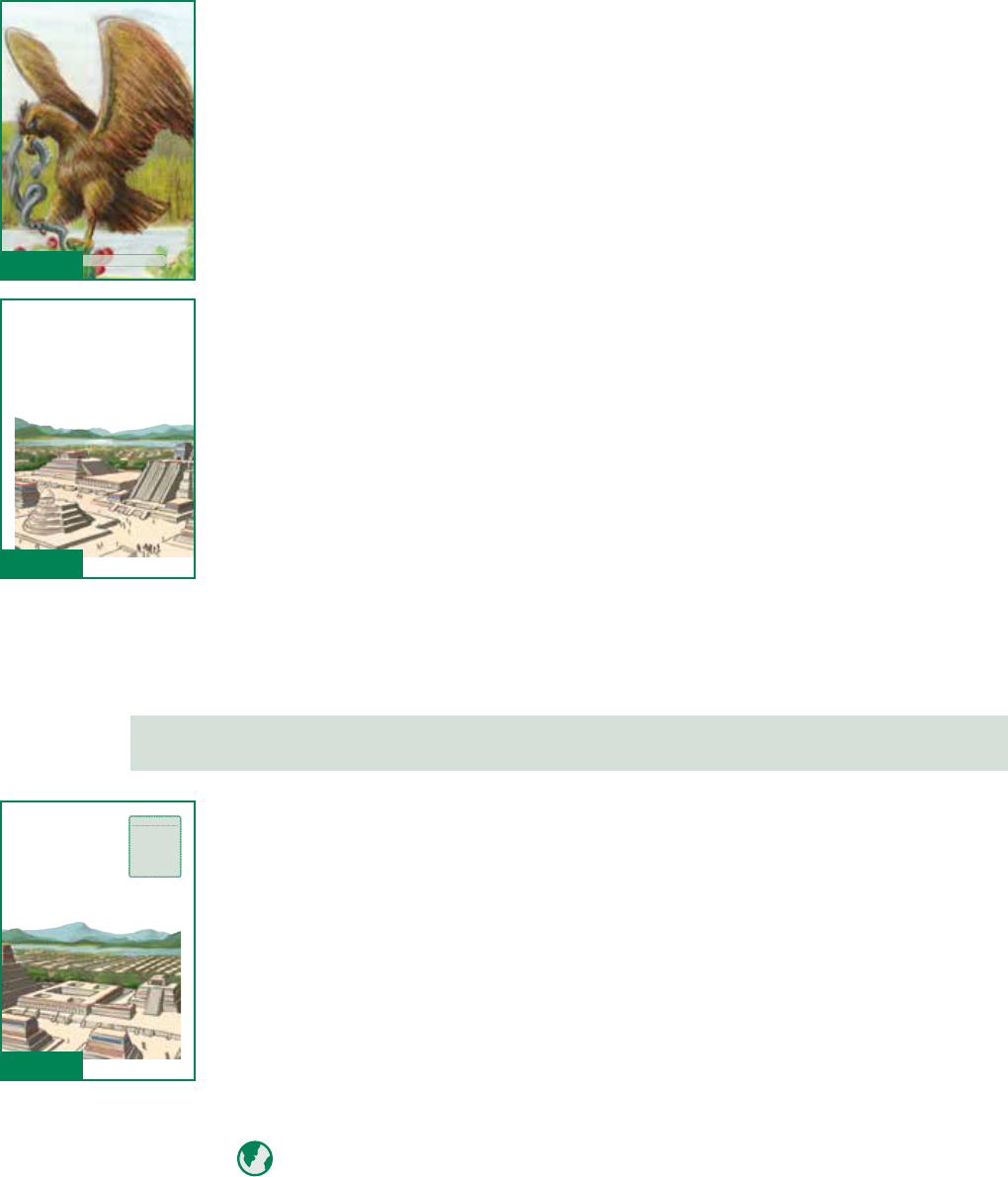
40 GRADE 5 | UNIT 2 | MAYA, AZTEC, AND INCA CIVILIZATIONS
Give students an opportunity to finish reading the section silently.
Have students pull out Modern Map of North America, Central America, and
South America (AP 1.3) and Map of the Maya, Aztec, and Inca Civilizations
(AP 1.5). Have them compare the location of the Aztec civilization to what is
shown on the Modern Map. Then ask the following questions:
LITERALWhere on the modern map would Tenochtitlán be located?
» Students should identify central Mexico, specifically Mexico City, as the
location of Tenochtitlán.
LITERALAccording to the text, when did the Aztec civilization begin its
rise in what is today central Mexico?
» The Aztec civilization began its rise about three hundred years after
the Maya civilization declined.
INFERENTIALWhat does the legend suggest about the life of the Aztec
before the founding of Tenochtitlán?
» The legend suggests that the Aztec lived difficult lives as nomads.
LITERALAccording to the legend, how did the Aztec choose the site on
which they built their city?
» The Aztec received a sign from a god directing them where to build
their city.
“Conquering City-States” and “The Legend of the Five Suns,” Pages 22–25
Scaffold understanding as follows:
Read the title “Conquering City-States” on page 22, and remind students
that they encountered the term city-states when reading about the Maya.
CORE VOCABULARYChoose a volunteer to read the first paragraph
under the heading “Conquering City-States,” which begins on page22,
continuing on to page 23 and the top of page 24.
Discuss the meaning of the words empire and emperor when they are
encountered, and note the similarities between these two words. Explain
that one term refers to a group of states or regions and that the other
refers to the person who leads that organization.
SUPPORTRemind students that they may have learned about other
great empires in history—for example, the Roman Empire. The Roman
Empire was initially based in Rome, but over time it included a vast area
of conquered lands and peoples. Ask students to recall what they have
learned about the challenges of building and holding together such far-
flung empires.
22
The legend goes on to describe how the Aztec finally received
the sign the god had told them about. The eagle appeared on a
swampy island in Lake Texcoco (/tesh*koh*koh/). On that day, the
Aztec’s wandering ended. They settled down and began building
a city. The Aztec people called their new home Tenochtitlán
(/tay*noch*tee*tlahn/), which means “the place of the prickly pear.”
Even today the eagle and serpent are shown on the flag of Mexico.
Conquering City-States
Whether or not the myth is true, we do know that the Aztec
established Tenochtitlán by 1325. By the 1400s, the Aztec
G5_U2_Chap03_SE.indd 22 7/1/16 2:02 PM
Page 22
23
civilization had begun to expand. The
Aztec proved to be fearsome warriors. One
by one they conquered neighboring city-
states and added them to their empire. By
the early 1500s, the Aztec Empire included
four hundred to five hundred city-states
and controlled much of present-day
Mexico. The Aztec emperor ruled more
than five million people. Tenochtitlán alone probably had between
150,000 and 200,000 residents, making it one of the largest cities
in the world at this time. No city in the United States would grow
so large until the 1800s.
The Aztec capital Tenochtitlán was one of the largest cities in the world.
Vocabulary
empire, n. a group of
countries or territories
under the control of
one government or
one ruler
emperor, n. the ruler
of an empire
G5_U2_Chap03_SE.indd 23 7/1/16 2:02 PM
Page 23
21
In legend, the Aztec built their capital on the sp ot where they saw an eagle
perched on a cactus while holding a snake in its beak.
G5_U2_Chap03_SE.indd 21 7/1/16 2:02 PM
Page 21

41CHAPTER 3 | THE AZTEC: EMPIRE BUILDERS
Invite the class to follow along as you read the final section, “The
Legend of Five Suns,” aloud. Before beginning, explain to students
that they are about to read about the Aztec belief in human sacrifice. Ask
students to think about how human sacrifice is viewed today. In modern
society, the idea of human sacrifice is considered horrible. During the time
of the Maya, Aztec, and Inca, human sacrifice was a part of everyday life.
Other cultures around the world also practiced human sacrifice.
After reading the text, ask the following questions:
LITERALHow large was the population of Tenochtitlán at its height?
» Between 150,000 and 200,000 people lived there.
INFERENTIALThe text notes that no city in the United States was as
large as Tenochtitlán, so what does this suggest?
» The Aztec and their city were highly advanced for their time. It would
take centuries for people in the United States to build a city of that size
and scale.
EVALUATIVEWhat are some of the details that support the statement
that the Aztec were fearsome warriors?
» The Aztec eventually conquered hundreds of city-states and ruled
over five million people.
LITERALHow did the conquest of neighboring groups help the Aztec
build wealth?
» Conquered people were required to send valuable goods to the
capital. These varied depending on what valuable items the people
produced.
LITERALIn addition to food and goods, what did conquered people
supply to the Aztec?
» Soldiers captured in battle were used in the Aztec ritual of human
sacrifice.
LITERALWhat did the Aztec believe about the end of the world?
» They believed that the world would end in terrible violence.
EVALUATIVEHow did the Aztec beliefs about the end of the world lead
them to make human sacrifices?
» The Aztec believed that they could put off the coming end of the
world by making sacrifices to the sun god. They believed that human
sacrifices gave the sun god strength to continue the world.
24
The Aztec were well-known warriors. By conquering other
people, they were able to gain wealth. Aztec warriors then forced
conquered peoples to send their gold, silver, jade, and turquoise
to Tenochtitlán. Those who had no valuables could send food,
cloth, or other goods. People who lived by the ocean might also
have to send seashells, fish, or turtles. Farmers might send corn,
beans, peppers, squash, or fruit. Groups with access to specific
environments might have to give animal skins and feathers.
Craft-working communities might send pottery or blankets
toTenochtitlán.
The Legend of the Five Suns
Victorious Aztec warriors sent more than food and precious metals
and stones back to Tenochtitlán. They also sent back soldiers
captured in battle. The captured soldiers sometimes were used in
an important religious ritual of the Aztec people: human sacrifice.
To understand the importance of human sacrifice, we need to take
a closer look at Aztec religion.
According to Aztec beliefs, life was uncertain. The one thing
people could count on was that the world would one day come
to a terrible, violent end. In fact, the Aztec believed that the world
and the sun had been created and destroyed four times in the
past. Under the first sun, a race of giants roamed the world. This
world ended when a jaguar devoured the giants. The world under
the second sun was swept away by a great wind. People under the
G5_U2_Chap03_SE.indd 24 7/1/16 2:02 PM
Page 24
25
third sun died in the fire and ash of volcanoes. Those living under
the fourth sun drowned in floods.
The Aztec of Tenochtitlán believed they were living under the
fifth sun. But they believed that this sun would also someday
die: “There will be earthquakes and hunger, and then our end
shall come,” the priests said. The Aztec people believed these
predictions. They planned their lives in response to them.
So the Aztec awaited their fate. But they did not simply accept it.
They believed that each night, the sun god battled the forces of
darkness. Each morning, the god had to find the strength to make
the sun rise again. The Aztec believed they could help their god by
offering human sacrifices in their temples.
The Aztec preferred to sacrifice someone other than their own
friends and family. Most of their victims were foreign soldiers
captured in war. Aztec priests believed that the heart was the
most important thing to sacrifice. They preferred to offer up the
strong heart of a soldier.
Religious Sacrifice
The Aztec held their sacrifices on top of pyramids not unlike
those built by the Maya. A big drum sounded as attendants led
the victims to the top. The priest killed the victim by removing
his heart. The heart was then burned on an altar. The victim’s
body was then allowed to tumble down the pyramid’s steps. The
process was repeated for each victim.
G5_U2_Chap03_SE.indd 25 7/1/16 2:02 PM
Page 25

42 GRADE 5 | UNIT 2 | MAYA, AZTEC, AND INCA CIVILIZATIONS
“Religious Sacrifice” and “Success at War,” Pages 25–27
Before students read the text, scaffold understanding as follows:
SUPPORTRemind students that a cause and an effect are two related
events. Every event has at least one cause, or reason why it happened.
Every event also has certain consequences, called effects. However,
sometimes events seem related to each other when they’re really not.
Tell students to look for examples of how the Aztec used cause-and-
effect relationships—or what they thought were cause-and-effect
relationships—to support their practice of human sacrifice.
Direct students to read the sections silently to themselves. Then, ask the
following questions:
LITERALHow did the Aztec sacrifice humans?
» Priests killed victims by removing their hearts.
INFERENTIALWhat does the word seemed suggest in the excerpt from
the text, “They [the Aztec] could even point to events that seemed to prove
that the sacrifices worked”?
» The word suggests that what were actually natural events or even
coincidences could mistakenly be viewed as the results of the
sacrifices.
LITERALHow did the Aztec regard their warriors?
» They honored them. Being a soldier was one of the few ways an Aztec
male could change his position in life.
EVALUATIVEHow did basic Aztec beliefs about their society and their
religion help make war such a central part of Aztec life?
» Aztec religion required a steady supply of victims for sacrifice, and war
provided one of the few ways for a person to advance socially. These
two factors helped encourage warfare.
Timeline
• Show students the Chapter 3 Timeline Image Card. Read and discuss the
caption, making particular note of any dates.
• Review and discuss the Big Question: “Why did the Aztec make human
sacrifices?”
• Post the image card on the left side of the Timeline, under the date
referencing the 1300s; refer to the illustration in the Unit 2 Introduction for
further guidance on the placement of each image card to the Timeline.
27
The Aztec were fierce warriors ready to go to battle against their neighbors at a
moment’s notice. This is an Eagle warrior dressed for battle.
G5_U2_Chap03_SE.indd 27 7/1/16 2:02 PM
Page 27
26
The Aztec believed human sacrifices were necessary to keep the
sun rising and moving across the sky. They could even point to
events that seemed to prove that the sacrifices worked. Once,
when a long drought threatened the Aztec corn harvest, priests
offered a number of human sacrifices. A day or so later, rain came.
To the Aztec, this was no coincidence. It was proof that the gifts
of blood had saved the crop. Experiences like this convinced the
Aztec of the power of human sacrifice. As a result, Aztec offerings
to the gods were regular and generous.
Success at War
Priests and soldiers were key elements of Aztec life. Priests used
human sacrifice to please the gods. Aztec soldiers held the empire
together and provided the victims for the sacrifices.
As in many societies until recent times, Aztec people were born
into a certain social class. Most people had relatively little chance
to advance out of it. The army provided one opportunity for brave
men to better themselves. Success in battle was rewarded with
advancement and honor. The Aztec people believed there was no
greater honor than to die inbattle.
No doubt about it—the Aztec were fierce warriors. But their
capabilities in warfare and skill at fighting helped create a rich
empire and a remarkable civilization. Read on to learn more about
the civilization that the Aztec built and their fabulous capital city
of Tenochtitlán.
G5_U2_Chap03_SE.indd 26 7/1/16 2:02 PM
Page 26

43CHAPTER 3 | THE AZTEC: EMPIRE BUILDERS
checK for understAndinG 10 min
Ask students to:
• Write a short answer to the Big Question, “Why did the Aztec make human
sacrifices?”
» Key points students should cite include: The Aztec were strongly
affected by their religious beliefs about influence of the gods in their
world. They believed human sacrifices could possibly delay the violent
end of the world by giving the sun god the strength to continue.
• Choose one of the Core Vocabulary terms (Aztec, nomadic, empire, or
emperor), and write a sentence using the word.
To wrap up the lesson, ask several students to share their responses.
Additional Activities
Aztec Arts (RI.5.7, RI.5.9) 25 min
Materials Needed: Internet access
The following activity introduces students to another side of Aztec life—the
rich tradition of art.
Background for Teachers: Long before the Aztec civilization reached its peak,
native people of Mesoamerica were building a rich tradition of stone sculpture.
For example, the Olmec people, who thrived some 2,500 years before the
Aztec, are famous for their massive stone head sculptures. The Aztec—the last
great pre-Columbian civilization of Mesoamerica—were also highly skilled
carvers of stone.
Aztec Sculpture Slide Show
Invite students to view the slide show of the Metropolitan Museum of Art’s
Aztec stone sculptures. With students, click through the different images in the
museum’s collection and read the description of each item aloud. This primary
unit link will take you to the Core Knowledge web page, where the specific link
to images of the museums’s Aztec stone sculptures may be found:
www.coreknowledge.org/hgca-g5-maya-aztec-inca-activities
Discuss Aztec Art
Ask students to describe the purpose of most of the Aztec sculpture they have
viewed. (Most of the artwork has a clear religious purpose, representing a
specific god or object with religious significance.) Remind students that these

44 GRADE 5 | UNIT 2 | MAYA, AZTEC, AND INCA CIVILIZATIONS
stone sculptures were created with very simple tools. They are also three-
dimensional and involved great effort and skill to make.
Ask students why they think the Aztec devoted so much time and effort to the
creation of these pieces of art. (Answers may vary. The stone representation of
gods and goddesses must have been very important to their life.)
Creating Aztec Art (RI.5.7, RI.5.9) 25 min
Materials Needed: pencils, paper, modeling clay
The Aztec were skilled artisans. Their creations were an important part of
their culture. From the Metropolitan Museum of Art site, print out images of
Aztec sculptures to post around your room. Give students the opportunity to
examine and sketch each image. Using modeling clay, have students create
their own Aztec sculptures. This primary unit link will take you to the Core
Knowledge web page, where the specific link for the Aztec sculpture images
can be found.
www.coreknowledge.org/hgca-g5-maya-aztec-inca-activities

45CHAPTER 4 | TENOCHTITLÁN: CITY OF WONDER
CHAPTER 4
Tenochtitlán:
City of Wonder
The Big Question: What does the description of Tenochtitlán reveal about Aztec
civilization?
Primary Focus Objectives
✓ Describe Tenochtitlán and the surrounding landscape. (RI.5.2)
✓ Identify Moctezuma II and describe features of his reign. (RI.5.2)
✓ Understand the meaning of the following domain-specific vocabulary: causeway, canal, scribe, codex,
pictogram, litter, and reign. (RI.5.4)
What Teachers Need to Know
For more background information about the content taught in this lesson, see:
www.coreknowledge.org/about-tenochtitlan
Materials Needed
• Map of the Maya, Aztec, and Inca Civilizations (AP 1.5)
• Enlarged version of AP 1.5
Core Vocabulary (Student Reader page numbers listed below)
causeway, n. a raised road built over water to connect islands to a mainland (28)
Example: The soldiers marched out of the city on the causeway.
Variation(s): causeways
canal, n. a channel dug by people, used by boats or for irrigation (28)
Example: People used the canals like roads through the city, traveling
bycanoe.
Variation(s): canals
Activity Page
AP 1.5

46 GRADE 5 | UNIT 2 | MAYA, AZTEC, AND INCA CIVILIZATIONS
scribe, n. a person whose job is copying written information (31)
Example: The scribes prepared copies of the codex.
Variation(s): scribes
codex, n. an ancient book with handwritten pages or parts (32)
Example: The archaeologist eagerly studied the codex.
Variation(s): codices
pictogram, n. a picture or drawing that stands for a word or phrase (32)
Example: The pictogram of the snake showed that the tomb belonged to
theking.
Variation(s): pictograms
litter, n. a chair attached to two beams and carried on the shoulders of several
people (34)
Example: The emperor entered the building carried on a litter.
Variation(s): litters
reign, n. a period of time in which a king or queen rules (34)
Example: The empire reached its peak during the reign of the king.
Variation(s): reigns
the core lesson 35 min
Introduce “Tenochtitlán: City of Wonder” 5 min
Prompt students to remember what they learned about the Aztec in Chapter3.
Record student responses on the board or chart paper. Remind students that
they learned that the Aztec were a fierce warrior people. They used human
sacrifice as a part of their religion. Explain to students that in this chapter, they
are going to learn about the Aztec temple at Tenochtitlán. Call attention to
the Big Question, and encourage students to look for ways the description of
Tenochtitlán reveals important information about the Aztec civilization.
Guided Reading Supports for “Tenochtitlán: City of Wonder” 30 min
When you or a student reads aloud, always prompt students to follow along.
By following along, students may acquire a greater understanding of the
content. Remember also to provide classroom discussion opportunities.

47CHAPTER 4 | TENOCHTITLÁN: CITY OF WONDER
“A Lakeside Paradise,” Pages 28–29
Scaffold understanding as follows:
SUPPORT—Ask students to refer to AP 1.5, and remind them that the
location of Tenochtitlán is in the south-central part of what is present-
day Mexico. There is a body of water—Lake Texcoco—on which the city
wasbuilt.
CORE VOCABULARY—Invite a volunteer to read the two paragraphs
on page 28. Note the terms causeways and canals. Explain that both
of these terms relate to the city’s island location and the way residents
traveled in and around the city. Causeways allowed travel on foot, while
canals allowed travel by water.
Discuss the illustration on pages 28 and 29.
Then ask the following questions:
LITERALWhat made the city of Tenochtitlán so unusual to the first
Europeans that visited the city?
» The city was large, and it was built in the middle of a lake. People
traveled around the city in canoes.
INFERENTIALWhy do you think that the first Europeans did not expect
to see a city like Tenochtitlán?
» They may not have believed that people capable of creating such a
great city were living in the Americas.
“City Tour,” “Aztec Home Life,” “Suburbs and Schools,” “The Market,”
and “The Ceremonial Center” Pages 30–34
Scaffold understanding as follows:
Direct students to read the sections “City Tour” and “Aztec Home
Life” to themselves. After students read the text, ask the following
questions:
INFERENTIALWhy do you think the Aztec went to the trouble of
building the gardens described in the text?
» There may not have been a lot of farmland available for the large
population, so the gardens were helpful in growing needed food.
They were highly productive.
29
Tenochtitlán was built on an island on the waters of Lake Texcoco.
It was connected to the mainland by causeways.
G5_U2_Chap04_SE.indd 29 7/1/16 2:03 PM
Page 29
30
City Tour
Imagine that you have
hopped into a canoe
to tour Tenochtitlán
as it was in the early
1500s. First, you see
the “gardens” on raised
beds built on Lake
Texcoco. The Aztec
created these gardens
by digging up mud
from the bottom of the lake and piling it up in shallow areas. Then
they shaped the piles into long narrow gardens. The gardens were
surrounded by water, so they stayed moist. The Aztec also kept
the soil fertile by scooping new mud onto the gardens every year.
The rich soil was perfect for growing corn, squash, and beans.
Aztec Home Life
As you glide toward the center of Tenochtitlán, you see Aztec men
dressed in loincloths and cloaks. Women wear long skirts, blouses,
and ponchos. You also see hundreds of one-room houses with
thatched roofs and mud walls. Inside one, you meet a girl who is
learning to weave from her mother. A few houses away, mothers
and daughters are preparing for a wedding feast. During the
wedding ceremony, the bride’s blouse will be tied to the groom’s
cloak. This tying together is a symbol of the connection between a
husband and wife.
The gardens that surrounded Tenochtitlán appeared to
be floating, but they were really built on the bottom of
the shallow waters of Lake Texcoco.
G5_U2_Chap04_SE.indd 30 7/1/16 2:03 PM
Page 30
Chapter 4
Tenochtitlán: City of
Wonder
A Lakeside Paradise The first
Europeans who came to America
did not expect to find a great
civilization. Imagine how surprised
they must have been when they
came upon the city of Tenochtitlán,
with its towering pyramids and its
population of perhaps two hundred thousand.
Tenochtitlán was more than the heart of
a great civilization. It was unlike anything
the Europeans had ever seen. The city was
built on an island in the middle of a lake.
Three wide causeways connected the city
to the mainland. A network of canals linked
different parts of the city. The Aztec traveled
around their capital in canoes.
28
The Big Question
What does the
description of
Tenochtitlán reveal
about the Aztec
civilization?
Vocabulary
causeway, n. a raised
road built over water
to connect islands to
a mainland
canal, n. a water
channel built by
humans
G5_U2_Chap04_SE.indd 28 7/1/16 2:03 PM
Page 28

48 GRADE 5 | UNIT 2 | MAYA, AZTEC, AND INCA CIVILIZATIONS
CHALLENGECan you think of a part of the United States where
people have used an invention or technology to overcome an unfriendly
environment like the Aztec did?
» Student responses will vary. One example may be the Southwest
region, where the climate is very dry and arid. People living in places
such as Arizona or New Mexico use irrigation and other farming
methods to make sure there is enough water to grow crops and take
care of livestock.
Have students look at the images on pages 31 and 32 and read the
captions. Ask the following question:
INFERENTIALWhat do the images and captions on pages 31 and 32
suggest about the roles of men and women in Aztec society?
» Aztec women and men had specific roles. Women’s roles were
centered on the home while boys were taught military skills.
Scaffold understanding as follows:
CORE VOCABULARYCall attention to the words scribes, codex, and
pictograms located on pages 31 and 32. Discuss the meaning of each
Core Vocabulary word with students. Ask a student volunteer to explain
how these terms are related to one another. (All three have to do with the
production of written works in the Aztec culture.)
Read the section “Suburbs and Schools” aloud. As you read, pause to
discuss the meaning of the term hair-raising found in the second paragraph of
the section on page 31. Explain to students that the term means something
that is frightening or shocking. When you have finished reading the section out
loud, call attention to the title of the section, “Suburbs and Schools.” Explain
to students that a suburb is a place located outside of a major city. Many Aztec
lived in the large city of Tenochtitlán, but many other people lived in the areas
located around the city.
After reading the text, ask the following questions:
LITERALHow were schools for noble children different from schools for
ordinary Aztec children?
» The sons of nobles were trained to be priests or scribes.
LITERALWhat special skills were involved in learning to be a priest?
» Students studied Aztec religion, astronomy, and reading and writing.
EVALUATIVEWhy do you think the Aztec used a social class system
where people were trained for different roles?
» Possible answer: in a large city, it is necessary for people to take on
different roles, including leadership roles.
34
length of a football field! It rises almost ninety feet in the air.
The top steps are stained with the blood of human sacrifices.
Surrounding the Great Temple are several smaller temples. Each
of these is dedicated to a different god.
Not far from these religious buildings stands the palace of the
Aztec emperor. You will have to admire the palace from the
outside: commoners are not allowed to enter. The palace has
hundreds of rooms and more than a thousand servants.
Moctezuma II
Moctezuma II (/mawk*te*soo*mah/)
(sometimes written as Montezuma) was the
Aztec emperor in the early 1500s. In the
court of Moctezuma II, no one was allowed
to look the emperor in the eye. When he
entered the room, even the nobles threw
themselves face down on the ground.
When he left the palace, he was carried in
a fancy litter. When Moctezuma wanted
to walk, nobles laid mats on the ground so he would not dirty his
goldensandals.
Moctezuma was a powerful leader. But during his reign, some
disturbing things were happening. There was a drought. A comet
appeared in the sky. Lightning struck one of the temples in
Tenochtitlán. Fantastic rumors began to spread. Some people said
that a ghostly woman was walking the streets of the capital at night.
She wailed, “My children, we must flee far away from thiscity!”
Vocabulary
litter, n. a chair
attached to two
beams and carried
on the shoulders of
several people
reign, n. a period of
time in which a king
or queen rules
G5_U2_Chap04_SE.indd 34 7/1/16 2:05 PM
Page 34
33
The Ceremonial Center
In the heart of the city is the ceremonial center. Here you find the
largest temple in the city, the Great Temple. This massive pyramid
is almost one hundred yards wide at its base. That’s roughly the
Tenochtitlán had a thriving market where people traded goods from around the empire.
G5_U2_Chap04_SE.indd 33 7/1/16 2:05 PM
Page 33
31
Suburbs and Schools
You also visit an Aztec school. There, boys receive moral
instruction—rules about the right and wrong way to behave.
They also learn military drills. The boys practice with miniature
weapons. They throw spears and carry special wooden clubs
studded with sharp pieces of a natural glass-like rock.
A visit to a school for the sons of Aztec nobles turns out to be a
hair-raising experience. You quickly realize that the teachers in this
school are Aztec priests. You’ve had some tough teachers over the
years. But you’ve never had one who painted his face black, did not
wash his hair for religious reasons, and performed human sacrifices!
The priests train their students to become
priests and scribes. Students study Aztec
religion and astronomy and learn how to
read and write Aztec hieroglyphs. They also
The lives of Aztec women usually revolved around caring for the family.
Vocabulary
scribe, n. a person
whose job is copying
written information
G5_U2_Chap04_SE.indd 31 7/1/16 2:04 PM
Page 31
32
learn how to record information
in a special kind of book called a
codex. This is a long strip of tree
bark that folds up like an accordion.
The pages of the codex are covered
with pictures and pictograms. The
priest explains that the codices
(/koh*duh*seez/) are used to keep
lists of rulers, to record payments
made by conquered people, and to
keep track of religious holidays.
The Market
The next stop on your tour is the central market. Here, people
trade cacao (chocolate) beans and cotton blankets for other items.
The sound of thousands of Aztec people trading creates a ruckus
that can be heard a mile away.
In one corner of the market, a man is
trading rabbits, deer, and small dogs that
are bred for food. Across the way a woman
displays pottery. You notice all sorts of
other goods, including sandals, feathers,
seashells, turkeys, wood, corn, bananas,
pineapples, honeycombs, and fabrics.
One section of the market is set aside for trading enslaved people.
Here you see human beings with wooden collars around their
necks. Noblemen mill around, inspecting them.
Aztec boys were raised from an early
age to be skilled and fearsome warriors.
Vocabulary
codex, n. an ancient
book with handwritten
pages or parts
pictogram, n. a
picture or drawing
that stands for a word
or phrase
G5_U2_Chap04_SE.indd 32 7/1/16 2:04 PM
Page 32

49CHAPTER 4 | TENOCHTITLÁN: CITY OF WONDER
Scaffold understanding as follows:
Have students read the sections “The Market” and “The Ceremonial
Center” independently.
After students read the text, ask the following questions.
INFERENTIALYou have read about the role of enslaved people in Aztec
human sacrifices. What other role of enslaved people is suggested in the
section “The Market”?
» The text suggests that noble families kept enslaved people as
servants.
LITERALTo what purpose is the center of the city dedicated?
» The center of the city is the religious ceremonial center, with many
temples, including the great temple.
INFERENTIALWhat is suggested by the fact that the Aztec emperor’s
palace is located in the city’s ceremonial center?
» The Aztec emperor is not only the leader of the state but also a
religious figure and leader.
“Moctezuma II,” Pages 34–35
CORE VOCABULARYChoose a volunteer to read the text on page34
under the heading “Moctezuma II.” Discuss the meaning of the words
litter and reign. Confirm with students their understanding of these terms
and also the proper pronunciation of the term reign.
After the student reads the text, ask the following questions:
EVALUATIVEWhat details in the first paragraph of the section
“Moctezuma II” support the idea that he was a great and powerful leader?
» Nobody could look Moctezuma in the eye or stand in his presence.
Servants carried him about and made sure his feet never touched the
bare ground.
INFERENTIALBy referring to some “disturbing things” that were
happening during Moctezuma’s reign, what is the text suggesting?
» The suggestion is that perhaps Moctezuma is not as powerful or in
control of things as he seems.
35
The Aztec believed the world might end at any moment.
Moctezuma and his priests worried that the strange events might
be a warning from the gods. They feared that the end of the world
might be near.
As it turned out, a form of doomsday was coming, but it was not
coming from the gods. It was coming from across the Atlantic
Ocean. Spanish soldiers were sailing from Europe in search of
riches and glory. In the final chapter, you will learn what the arrival
of these pale-skinned men meant for the mighty Aztec Empire.
Moctezuma II ruled the Aztec Empire at the heig ht of its great power.
G5_U2_Chap04_SE.indd 35 7/1/16 2:06 PM
Page 35

50 GRADE 5 | UNIT 2 | MAYA, AZTEC, AND INCA CIVILIZATIONS
EVALUATIVEThinking about the Aztec and their beliefs, why might the
disturbing signs that occurred during Moctezuma’s reign have troubled
the people of Tenochtitlán?
» The Aztec believed that their world would end violently and that they
were in an ongoing struggle to persuade the gods to delay this violent
end. The signs might have made people worry that they were not
succeeding in this effort.
checK for understAndinG 10 min
Ask students to:
• Write a short answer to the Big Question, “What does the description of
Tenochtitlán reveal about the Aztec civilization?”
» Key points students should cite include: Tenochtitlán was an enormous
city that had many features that enabled it to serve and support its
large population. It demonstrates the great success and ingenuity
of the Aztec and their great skill at building, organizing, and solving
practical problems.
• Choose one of the Core Vocabulary terms (causeway, canal, scribe, codex,
pictogram, litter, or reign), and write a sentence using the word.
To wrap up the lesson, ask several students to share their responses.
Additional Activities
Summary of the Maya, Aztec, and Inca Civilizations (RI.5.1, RI.5.2, RI.5.3) 15 min
Materials Needed: Extra copies of the Summary of the Maya, Aztec, and Inca
Civilizations (AP 2.1) found on page 94 in the Teacher Resources section.
Have students take out Summary of the Maya, Aztec, and Inca Civilizations
(AP 2.1). Some students may have lost their copies; provide them with an extra
activity page as necessary. Have students complete the Aztec sections of the
graphic organizer. Encourage students to refer to Chapters 3 and 4 of the
Student Reader to help them complete the chart. Remind students that they
will be using this activity page through the duration of Unit 2, so they should
store it in a place where it will not get lost.
Activity Page
AP 2.1

51CHAPTER 4 | TENOCHTITLÁN: CITY OF WONDER
Domain Vocabulary: Chapters 1–4 (RI.5.4) 15 min
Materials Needed: (1) Sufficient copies of Domain Vocabulary: Chapters1–4
(AP 4.1), found in Teacher Resources, page 96; (2) pens and pencils; and
(3)colored pencils or crayons.
Distribute the Domain Vocabulary: Chapters 1–4 activity page (AP 4.1). Allow
students to work through the activity page independently or in pairs or
groups, circling the correct terms to complete the sentences. You may also
assign this page as homework. Have students select one statement from the
activity page to illustrate.
Create a Codex (AP 4.2) (RI.5.4) 15 min
Materials Needed: (1) Sufficient copies of Create a Codex (AP 4.2), found in
Teacher Resources, page 97; (2) pens and pencils; (3) crayons or colored pencils;
and (4) construction paper.
Distribute the Create a Codex (AP 4.2) activity page as well as construction
paper and crayons or colored pencils to students. Read directions with
students aloud, and briefly discuss the hieroglyphs on the activity page. Have
students brainstorm their trip to school each morning and jot down notes on
a separate piece of paper. Instruct students to fold their construction paper
like an accordion so that it has six different panels. This will be the students’
“codex.” Students should then select, draw, and color symbols that relate to
their morning journey to school. Have students swap their codices with at least
one partner to decipher the meaning of the codices.
Activity Page
AP 4.1
Activity Page
AP 4.2

52 GRADE 5 | UNIT 2 | MAYA, AZTEC, AND INCA CIVILIZATIONS
CHAPTER 5
The Inca: Lords of
the Mountains
The Big Question: Why were llamas so important to the Inca?
Primary Focus Objectives
✓ Identify the Inca and describe where they lived. (RI.5.2)
✓ Describe the Sapa Inca and how he maintained absolute rule. (RI.5.2)
✓ Explain how the Inca organized their empire and met the needs of the people. (RI.5.2)
✓ Compare and contrast the Inca and Aztec civilizations. (RI.5.3)
✓ Understand the meaning of the following domain-specific vocabulary: Inca, conquistador, plateau,
clan, alpaca, llama, and census; and of the phrase “geographical diversity.” (RI.5.4)
What Teachers Need to Know
For more background information about the content taught in this lesson, see:
www.coreknowledge.org/about-inca
Materials Needed
• Modern Map of North America, Central America, and South America
(AP1.3) and Map of the Maya, Aztec, and Inca Civilizations (AP 1.5) for
reference
• Enlarged versions of AP 1.3 and AP 1.5 for reference
Core Vocabulary (Student Reader page numbers listed below)
Inca, n. a civilization that thrived from 1438 to 1532 on the western coast of
South America, covering most of modern-day Peru and part of Colombia,
Ecuador, Bolivia, Chile, and Argentina (36)
Example: The Inca built a great civilization that relied on a high degree of
engineering skill.
Variation(s): Incan
Activity Pages
AP 1.3
AP 1.5

53CHAPTER 5 | THE INCA: LORDS OF THE MOUNTAINS
conquistador, n. the Spanish word for conqueror (38)
Example: The conquistadors came to the Americas looking for wealth.
Variation(s): conquistadors
“geographical diversity,” (phrase) the presence of many different kinds of
landforms, waterways, or other geographic features in a region (39)
Example: The huge Inca Empire spanned a wide area and contained a great
deal of geographical diversity.
plateau, n. a large area of high, flat ground (39)
Example: The city rested on a plateau between the mountain ranges.
Variation(s): plateaus
clan, n. a group of families (39)
Example: The clan to which his family belonged was one of several in
thevillage.
Variation(s): clans
alpaca, n. a South American mammal valued for its long wooly coat (40)
Example: They wove warm clothes from the wool of the alpaca.
Variation(s): alpacas
llama, n. a South American mammal valued for its endurance and for its wooly
coat and meat (40)
Example: The Inca depended on the llama to carry large loads over great
distances.
Variation(s): llamas
census, n. a count of the number of people living in a certain area (42)
Example: The Inca official came to the village to carry out a census.
the core lesson 35 min
Introduce “The Inca: Lords of the Mountains” 5 min
Ask students what they remember about the Maya and Aztec civilizations.
(They believed in many gods, they were farmers and warriors, they practiced
human sacrifice, and they solved difficult problems by, for instance, creating a
calendar and building islands for farmland.) Tell students that in this chapter they
will learn about a third early American civilization: the Inca. Call attention to the
Big Question, and encourage students to look for reasons why the llama was so
important to the Inca as they read the chapter.
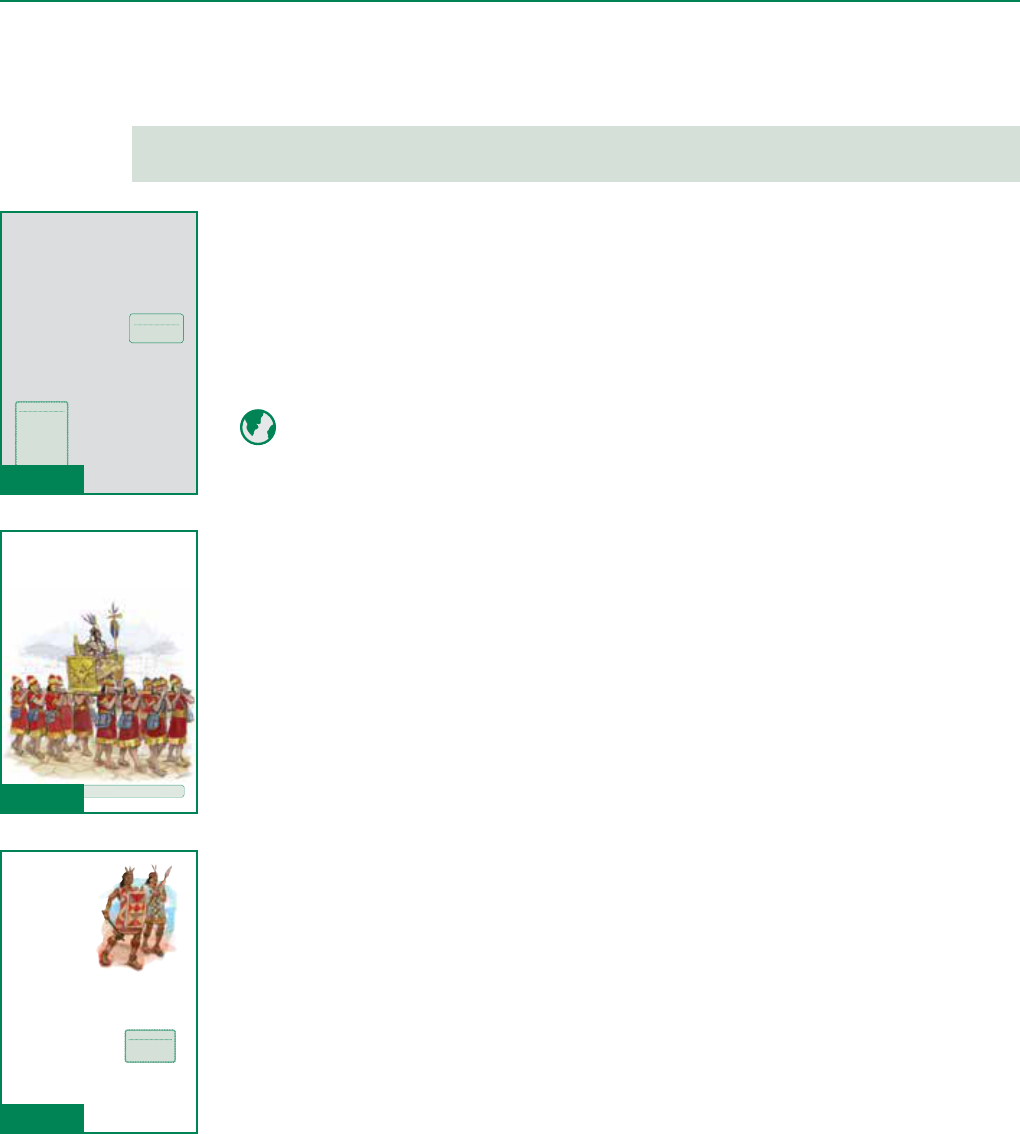
54 GRADE 5 | UNIT 2 | MAYA, AZTEC, AND INCA CIVILIZATIONS
Guided Reading Supports for “The Inca: Lords of the Mountains” 30 min
When you or a student reads aloud, always prompt students to follow along.
By following along, students may acquire a greater understanding of the
content. Remember also to provide classroom discussion opportunities.
“Here Comes the Sun,” Pages 36–38
Scaffold understanding as follows:
CORE VOCABULARY—Call attention to the Vocabulary box for the
term Inca on page 36. Review the definition of this term by reading it
aloud. Remind students that this is the third of the three great civilizations
of the Americas that existed before the Age of Exploration that began in
the 1400s.
SUPPORT—Encourage students to refer to AP 1.3 and AP 1.5 to review the
location and key features of the Inca Empire.
Read the entire section aloud with the class, and discuss the illustration
and caption on page 37. Then ask the following questions:
LITERALThe text describes a scene from a dream. What is happening in
that dream?
» An emperor—the Sapa Inca—is being carried on a litter through the
streets of an Inca village.
LITERALWhy did the Inca bow before the Sapa Inca?
» The Inca regarded the Sapa Inca as the son of a god, Inti.
EVALUATIVEWhat are some similarities between the role of the Sapa
Inca in Inca society and the role of Moctezuma in the life of the Aztec?
» Both were regarded with a combination of fear and awe. Both were
carried on litters among the people, and in both cases ordinary people
were considered unworthy to look directly at them.
CHALLENGEWhat other cultures held their leaders in such high regard?
» Student responses will vary. The Aztec viewed their ruler as part man
and part god.
Chapter 5
The Inca: Lords of
the Mountains
Here Comes the Sun It is the year
1500. You are standing along a road
in South America in a crowd of
people. You seem to be at some kind
of parade. You look down the road and see a gleaming,
golden litter carried on the shoulders of several men.
Inside the litter is a man wearing furs and golden jewelry.
As the litter gets closer, the people around you go down on their
knees and touch their foreheads to the ground. You are the only one
still standing. Suddenly you notice several
people yelling at you. An angry soldier is
running at you with a raised club. You begin
to run. With a start, you wake up and realize
you were having a dream.
It’s a good thing you woke up. The people
in your dream were bowing because the
Sapa Inca, the king of the Inca people, was
approaching.
36
The Big Question
Why were llamas so
important to the Inca?
Vocabulary
Inca, n. a civilization
that thrived from
1438 to 1532 on
the western coast
of South America,
including most of
modern-day Peru and
parts of Colombia,
Ecuador, Bolivia, Chile,
and Argentina
G5_U2_Chap05_SE.indd 36 7/1/16 2:03 PM
Page 36
Inca soldiers helped to conquer a huge
empire in a short period of time.
38
The Inca believed that the Sapa Inca was the
son of Inti, the sun god. No one was allowed
to look at this powerful king—and you
were staring right at him! If you had
not woken up, your dream would
have had a terrifying ending:
you would almost certainly have
been killed by the soldiers for
being so disrespectful to the son
of the sun.
The Empire of the Sun
Who were the Inca? They
were people who built a great
civilization on the western coast of South America. The first Inca
people lived in the area around Cuzco in modern-day Peru. In
the early 1400s, these people began conquering neighboring
lands and extending their empire. By the time the Spanish
conquistadors (/kahn*kees*tuh*dorz/)
arrived in the 1530s, the Inca Empire was the
largest in the Americas—larger even than
the Aztec Empire had been.
The Sapa Inca ruled over more than twelve million people. His
territory stretched for more than two thousand miles along the
Pacific Coast. The empire covered an area so large that most of
modern-day Peru and parts of Colombia, Ecuador, Bolivia, Chile,
and Argentina would lie inside its borders.
Vocabulary
conquistador, n.
the Spanish word for
conqueror
G5_U2_Chap05_SE.indd 38 7/1/16 2:04 PM
Page 38
37
The Sapa Inca was the ruler of the vast Inca Empire, which stretched over two thousand mil es
of the South American coast.
G5_U2_Chap05_SE.indd 37 7/1/16 2:04 PM
Page 37

55CHAPTER 5 | THE INCA: LORDS OF THE MOUNTAINS
“The Empire of the Sun,” Pages 38–39
Scaffold understanding as follows:
CORE VOCABULARYChoose a volunteer to read the first paragraph
of the section “The Empire of the Sun.” Discuss the meaning of the
word conquistador. Explain that this term is a word in the Spanish language;
in English it means “conqueror.” Ask students to identify any similarities
between the Spanish and English words. (For example, both begin with the
letters c–o-n-q-u.)
CORE VOCABULARYAsk another volunteer to read the remaining
two paragraphs that begin at the bottom of page 38 and continue
to the top of page 39. Note the terms “geographical diversity” and
plateau. Explain that “geographical diversity” is a term made up of the
word geographical, which means “having to do with geography,” and
dversity, which means “having many different types.” For the word plateau,
help students properly pronounce the term. Explain it is a French word
meaning“flat.”
SUPPORTCall attention to the first paragraph on page 39 and reread
the sentences, calling particular attention to, “Farther east, the twin ranges
of the snow-capped Andes Mountains rise toward the skies.” Remind
students that the Inca ruled an empire that was very geographically
diverse.
When the students have finished reading, ask the following questions:
LITERALCan you describe the general geographical location of the Inca
Empire?
» It was on the western coast of South America.
LITERALIn what modern-day country did the Inca civilization originate?
» The Inca civilization originated in modern-day Peru.
EVALUATIVEWhat details in the text support the statement that the
Inca Empire was a land of great geographical diversity?
» It was a large empire, stretching over two thousand miles and covering
parts of many modern-day countries. It had a long coastline, arid
plains, huge mountain ranges, a high plateau, and thick forests.
39
This is a region of great geographical
diversity. Arid plains stretch along the
western coastline. This region is so dry that
not even a cactus can grow. Farther east,
the twin ranges of the snow-capped Andes
Mountains rise toward the skies. Between
the ranges lies a high plateau. Land here
is sizzling hot by day and freezing by night.
East of the Andes are thick forests where
heavy rains feed the mighty Amazon River.
All these lands were ruled by the Sapa Inca.
Inca Life
The Inca people were organized into clans, or groups. Every Inca
family was part of a clan, and each clan farmed a piece of land.
Families lived in windowless, one-room stone huts
with thatched roofs. Home, sweet home,
probably didn’t smell so sweet, since families
sometimes burned dried animal waste as
fuel. Parents and children slept together
on animal skins spread on the bare
floor. A few wall pegs were the
only furnishings.
The Inca Empire included a wide range of differe nt geographic regions and features.
Vocabulary
“geographical
diversity,” (phrase),
the presence of
many different
kinds of landforms,
waterways, or other
geographic features
in a region
plateau, n. a raised
area that is generally
flat on top
clan, n. a group of
families
G5_U2_Chap05_SE.indd 39 7/1/16 2:04 PM
Page 39
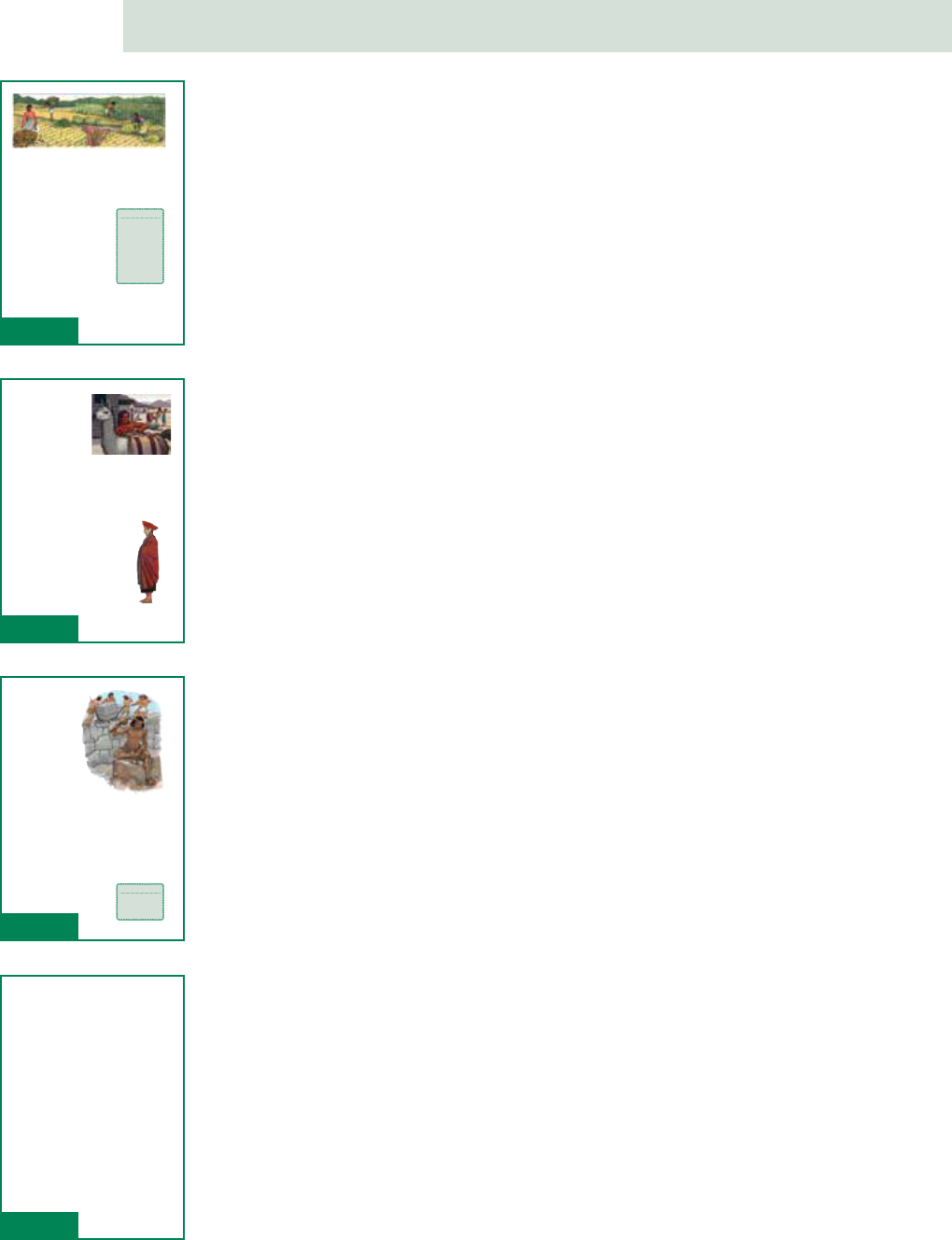
56 GRADE 5 | UNIT 2 | MAYA, AZTEC, AND INCA CIVILIZATIONS
“Inca Life” and “For the Good of the Empire,” Pages 39–43
Scaffold understanding as follows:
CORE VOCABULARYInvite a volunteer to read the first paragraph
under “Inca Life” on page 39. Point out the term clan and explain its
definition. Ask another volunteer to use the word in a sentence, and
correct any misunderstandings of the term’s proper use.
CORE VOCABULARYHave student volunteers take turns reading
the remainder of the section “Inca Life.” Discuss the meaning of the
words alpaca and llama. Explain that these two words describe two similar
animals, both of which are related to the camel. They are both native to
South America and nowhere else.
CORE VOCABULARYHave students read the section “For the Good
of the Empire” independently. Before students begin reading, note the
term census, and review the definition that appears beside it. Explain to
students that the United States carries out a census of its population every
ten years.
After students read the text, ask the following questions:
LITERALWhat was the most common way of earning a living for an Inca
family as described in the text?
» Most Inca were farmers who worked the land of the clan. They lived in
windowless stone huts.
LITERALWhy was the potato the main crop of the Inca?
» It grew well in the high-altitude environment in which many Inca lived
and farmed.
EVALUATIVEWhat features of the llama made it so valuable to the Inca?
» Possible responses: It had great strength and endurance. It was able to
find food anywhere and required little water, making it a useful animal
for moving goods. The llama’s wool was used to make cloth, its waste
was used for fuel, and its meat was a source of food.
EVALUATIVEWhy do you think a good pack animal was so important to
the Inca people?
» Possible answer: they lived in a huge empire, so transporting goods
over long distances was a common challenge.
LITERALHow did the Inca support the Sapa Inca and the rest of the
empire?
» In addition to working for themselves, the Inca had to spend part of
their time working for the Sapa Inca and the empire.
40
Boys followed their fathers’ trades. Girls copied their mothers’.
Most Inca were farmers. They grew corn, squash, tomatoes,
peanuts, cotton, and more than a hundred varieties of potatoes.
The potato was the main crop for the Inca. It grew well even at
high altitudes on the slopes of the Andes Mountains.
Inca farmers also raised livestock. This
included guinea pigs, alpacas, and llamas.
The guinea pigs were raised for food. The
alpacas were a source of wool. The Inca
used llamas for all sorts of things, but
especially as pack animals.
The llama is truly an amazing animal. It is a
smaller cousin of the camel. A llama stands
about four feet high at the shoulder and
weighs about 250 pounds. Like its camel cousin, the llama has
great strength and endurance. Llamas can carry loads up to 125
pounds for fifteen to twenty miles a day. They will eat just about
anything and can go long periods without drinking. Llamas are
also gentle animals. But if they are mistreated or overloaded, they
Inca farmers used ingenious methods to farm in the challenging environment of the
Andes Mountains.
Vocabulary
alpaca, n. a South
American mammal
valued for its long,
woolly coat
llama, n. a South
American mammal
valued for its
endurance and for
its woolly coat and
meat
G5_U2_Chap05_SE.indd 40 7/1/16 2:04 PM
Page 40
41
will let you know it. A llama
may simply sit down and
refuse to move. An unhappy
llama may hiss and spit to
make its point. Llama spit is
not just wet and nasty. It can
include hard pellets of food,
which can cause pain if they
hit you.
The Inca used llamas to transport goods. They also used the
llama’s wool for cloth, its hide for rugs and coats, its waste for fuel
and fertilizer, and its meat for food. When a llama died, the Inca
cut the meat into strips and dried it in the sun. They called these
strips charqui (/chahr*kee/). This is the source of our own word for
dried meat, jerky.
Inca women were skilled weavers. They made
clothing from the cotton they grew and from
the wool of their llamas and alpacas.
For the Good of the Empire
Inca families worked for themselves. In addition,
they were required to spend part of their time
working for the Sapa Inca and the empire.
Farmers raised crops for themselves and also for
the empire. Inca men also had to donate time
by working on construction projects, building
roads, or serving in the military.
The llama is a useful animal that served the
Inca people mainly as a pack animal.
The Inca used cotton
and wool from llamas
and alpacas to make
their clothing.
G5_U2_Chap05_SE.indd 41 7/1/16 2:04 PM
Page 41
42
The Inca people
understood that their labor
was necessary to maintain
the empire and to help
protect them and their
families. As a result, they
worked willingly. The Sapa
Inca and the priests used
only a small part of the
goods produced. The rest
were stored in warehouses
and given to those who
were too old or too sick to
work. When crops failed
and times were hard, food and goods were given to the working
people, too. This system ensured that no one went hungry.
The rule of the Sapa Inca was absolute. Many government
officials traveled throughout the empire to make sure his laws
were obeyed. One of those officials was known as He-Wh o-Sees-
Every thing. He-Who-Sees-Everything was responsible for visiting
Inca villages and making them pay their taxes. Oddly enough, he
also served as a matchmaker.
He-Who-Sees-Everything would arrive in
an Inca village every few years. When he
arrived, he ordered the villagers to gather
so that he could take a census. The more
people in the village, the more the village
had to pay in taxes.
Every Inca subject was required to spend part
of his or her time working for the emperor.
Vocabulary
census, n. a count
of the number of
people living in a
certain area
G5_U2_Chap05_SE.indd 42 7/1/16 2:04 PM
Page 42
43
Once the counting was over, He-Who-Sees-Everything asked
unmarried women over a certain age to step forward. The official
interviewed each young woman. If one was found especially
worthy, she was sent to Cuzco to become one of the Sapa Inca’s
many wives.
Once these chosen few had been selected, He-Who-Sees-
Everything called all the unmarried young men before him. He
proceeded to pair off the young men and women. He could make
dozens of marriages on the spot. No questions were asked. After
all, He-Who-Sees-Everything was a servant of the Sapa Inca. The
marriages he was arranging were for the good of the empire.
The Inca Empire lasted only from the beginning of its expansion
in 1438 to the Spanish conquest in 1532. But it was a century of
towering achievement. The Inca did not just conquer people.
To keep their empire unified, they changed every place they
conquered. Read on to find out how the Inca conquests changed
the face of South America.
G5_U2_Chap05_SE.indd 43 7/1/16 2:04 PM
Page 43

57CHAPTER 5 | THE INCA: LORDS OF THE MOUNTAINS
INFERENTIALHow did the Sapa Inca make sure that his will was carried
out in his empire?
» Government officials, like the He-Who-Sees-Everything, traveled the
empire, making sure people obeyed laws and paid their taxes.
INFERENTIALWhat can you infer about marriages in the Inca society
based on the fact that the He-Who-Sees-Everything arranged many
ofthem?
» Marriage was not a romantic matter. Instead, it was a matter of peace
and good order in the empire.
SUPPORTHow were marriages arranged among the Inca?
» The He-Who-Sees-Everything arranged them on periodic visits to
thevillages.
Timeline
• Show students the Chapter 5 Timeline Image Card. Read and discuss the
caption, making particular note of any dates.
• Review and discuss the Big Question: “Why were llamas so important to
theInca?”
• Post the image card in the middle of the Timeline, under the date
referencing 1300s; refer to the illustration in the Unit 2 Introduction for
further guidance on the placement of each image card to the Timeline.
checK for understAndinG 10 min
Ask students to:
• Write a short answer to the Big Question, “Why were llamas so important to
the Inca?”
» Key points students should cite include: Llamas provided several key
resources to the Inca, including food, clothing, and transportation.
They represented the efficient and effective approach the Inca took to
building a thriving civilization in a harsh environment.
• Choose one of the Core Vocabulary words or the phrase (conquistador,
“geographical diversity,” Inca, plateau, clan, alpaca, llama, and census), and
write a sentence using the word or phrase.
To wrap up the lesson, ask several students to share their responses.

58 GRADE 5 | UNIT 2 | MAYA, AZTEC, AND INCA CIVILIZATIONS
Additional Activities
Achievements of the Inca Empire (RI.5.7, RI.5.9) 45 min
Materials Needed: Internet access
The following activity introduces students to a study of Inca artifacts, enabling
a more detailed look into Inca culture.
Background for Teachers
The Inca were a people of great skill and ingenuity. They were skilled artisans
with a rich tradition of sculpture, pottery, and weaving, and they were
especially noted for their gold and silver creations. Like Maya and Aztec art,
Inca art and artifacts had sacred meaning and served religious purposes.
Unfortunately, a great quantity of Inca art was destroyed by the Spanish. Gold
and silver works were melted down and taken back to Spain.
The Inca were also highly skilled engineers, whose stone structures are
remarkable for their grace and beauty. It is also important to note that so many
of them have survived intact in a region known for earthquakes.
The Inca also applied astronomical and scientific knowledge at a high level.
There is evidence, for instance, that they practiced a form of brain surgery.
For more background information, use this primary unit link to the Core
Knowledge web page, which will take you to Discover Peru, a specific link
about Inca art forms:
www.coreknowledge.org/hgca-g5-maya-aztec-inca-activities
Guide students on an exploration of different forms of Inca art and artifacts
by also using the primary unit link, which will take you to specific links about:
the top ten Inca ruins (National Geographic); silver and gold of the Inca (Latin
American Studies); pottery (Double Bowl, Metropolitan Museum of Art); and
Inca textiles (Latin American Studies).
Discuss Inca Accomplishments
Discuss with students their reaction to what they have just learned about the
artistic and scientific achievements of the Inca.
Ask: Which accomplishments are most impressive to you? Why?
Encourage students to explain the reasons for their opinions. For example,
students who select the Inca building methods might defend that view
by saying that the great structures were built without the aid of modern
equipment and have stood for centuries in a harsh environment.

59CHAPTER 6 | INCA ENGINEERING
CHAPTER 6
Inca Engineering
The Big Question: How did the Inca use their engineering skills to manage and grow
their empire?
Primary Focus Objectives
✓ Explain how Inca engineers overcame challenges presented by the geography of the land. (RI.5.2)
✓ Describe how the Inca kept their empire together without a written language. (RI.5.2)
✓ Understand how the Sapa Inca united his empire. (RI.5.2)
✓ Understand the meaning of the following domain-specific vocabulary: official, engineer, mortar,
suspension bridge, and terrace. (RI.5.4)
What Teachers Need to Know
For more background information about the content taught in this lesson, see:
www.coreknowledge.org/about-machu-picchu
Materials Needed
• Modern Map of North America, Central America, and South America
(AP1.3) and Map of the Maya, Aztec, and Inca Civilizations (AP 1.5) for
reference
• Enlarged versions of AP 1.3 and AP 1.5 for reference
Core Vocabulary (Student Reader page numbers listed below)
official, n. a person who carries out a government duty (45)
Example: The official came to the village to explain the new government rule.
Variation(s): officials
engineer, n. a person who uses science and math to build useful objects or
buildings (46)
Example: The engineer made plans for a new bridge.
Variation(s): engineers, engineering
Activity Pages
AP 1.3
AP 1.5

60 GRADE 5 | UNIT 2 | MAYA, AZTEC, AND INCA CIVILIZATIONS
mortar, n. a material used in building that is soft at first but that then gets
hard and rocklike (47)
Example: The builder used mortar to hold the bricks together.
suspension bridge, n. a type of bridge in which the road or pathway hangs
from ropes or cables that are attached to anchors or towers (47)
Example: The tall towers of the suspension bridge rise high above the
valleyfloor.
Variation(s): suspension bridges
terrace, n. a flat piece of land carved out of the side of a mountain or hill (49)
Example: The farmer’s crops were planted in a terrace on the hillside.
Variation(s): terraces, terraced
the core lesson 35 min
Introduce “Inca Engineering” 5 min
Ask students to think about the Aztec city of Tenochtitlán and how it was built
(an island in the middle of a lake, causeways connecting it to the mainland,
canals connecting parts of the city, and so on). Remind students that the Aztec
did not have modern building tools or materials. Despite this fact, they were
able to erect a large and advanced city for the time. Tell students that in this
lesson they will learn about Inca engineering that is just as amazing—maybe
even more so.
Guided Reading Supports for “Inca Engineering” 30 min
When you or a student reads aloud, always prompt students to follow along.
By following along, students may acquire a greater understanding of the
content. Remember also to provide classroom discussion opportunities.
“The Royal Road,” Pages 44–47
Scaffold understanding as follows:
Invite a volunteer to read pages 44–45 of “The Royal Road” out loud.
CORE VOCABULARY—Call attention to the term officials when it is
encountered in the second paragraph. Note that the word in this sense
is used as a noun. The word official can also be used as an adjective. For
example, an official document is one that carries authority.
SUPPORT—Discuss the illustration on pages 44–45.
Chapter 6
Inca Engineering
The Royal Road It’s one thing to
conquer many lands. It’s another
thing to keep control of what you’ve
conquered. Remember how the
ancient Romans held their empire
together? They built roads all across it.
44
The Big Question
How did the Inca use
their engineering
skills to manage and
grow their empire?
G5_U2_Chap06_SE.indd 44 7/1/16 2:03 PM
Page 44

61CHAPTER 6 | INCA ENGINEERING
CORE VOCABULARY—Choose another volunteer to read the remainder
of this section that begins on page 46 to the end of this section on
page47. Note the term engineers. Ask students if they see another familiar
word embedded in this term (engine). Point out that a person who would
design an engine is an engineer.
CORE VOCABULARY— Call attention to the word mortar. If possible,
illustrate this term by pointing to a wall or building surface that uses
mortar between bricks.
Then ask the following questions:
LITERALWhat key feature did the Inca Empire share with the Roman
Empire?
» Both great empires had a network of roads that linked all parts of
theempire.
INFERENTIALHow did the system of roads benefit the Inca Empire?
» The text implies that, like the Roman road system, the Inca system
helped to promote trade and enabled government officials to quickly
travel throughout the empire. The roads also allowed quick movement
of troops.
LITERALWhy is the Inca road system considered to be such a fine
example of engineering?
» It was built without modern equipment or machinery. The paving
stones were precisely cut so that they fit together well.
CHALLENGEDo you think the text’s comparison of the Inca Royal
Road to a spine with nerves (other roads) branching out from it is a good
comparison? Why or why not?
» Possible answer: The comparison of the road system to a backbone
and nerves is a good one because, like a spine, the roads connected
the “head” of the empire to its distant parts. Like nerves, the roads
allowed messages to travel throughout the “body” and to coordinate
movements and actions.
The roads made it possible for government
officials to travel around the empire. Roads
also encouraged trade. Most importantly,
the roads allowed the army to travel quickly.
This way, they could put down a rebellion or
enforce the emperor’s rule.
The Inca knew nothing of ancient Rome. But they too were great road
builders. Their Royal Road stretched over two thousand miles. It ran
from the northern end of the empire to the southern tip. It was the
longest road in the world until the 1800s.
45
Vocabulary
official, n. a person
who carries out a
government duty
The Inca Empire was linked by a vast network of well-built roads.
G5_U2_Chap06_SE.indd 45 7/1/16 2:04 PM
Page 45
Inca builders cut and assembled stone with great precision to build roads and othe r structures.
46
The Royal Road was twenty-four feet wide in most places.
Although it crossed mountains, valleys, deserts, and swamps, long
stretches were straight as an arrow. Markers
measured distances along the road. Trees
shaded the road. A canal provided water
for travelers. There were even roadside
storehouses where travelers could get food
at the end of the day.
Parts of the Royal Road were made of packed dirt. Other
parts were paved. Inca engineers fitted paving stones
together like pieces of a jigsaw puzzle. Modern builders use
Vocabulary
engineer, n.
someone who uses
science and math to
design useful objects
or buildings
G5_U2_Chap06_SE.indd 46 7/1/16 2:06 PM
Page 46
47
mortar, a cement-like material, to keep
stones together. The Inca did not use any
mortar. Instead, they cut stones so exactly
that they fit together snugly.
The Royal Road shows the great skill of
Inca builders. These builders had no earth-
moving machinery. They did not have
horses or oxen to pull wagons. They did not
even have the wheel. Everything was done
by hand. Yet the Inca were able to build
roads so sturdy, not even heavy rains or
flash floods could destroythem.
The Royal Road was the main Inca road, but there were others.
Atevery valley, east-west roads crossed the Royal Road. The
Royal Road was like the spine. The crossroads were like nerves
branchingout from it. This network of roads linked all parts of the
empire together.
Bridges Built for the Centuries
To build roads through mountains and across streams, the Inca had
to build lots of bridges. Like the roads, these bridges are marvels of
engineering. A bridge built over the Apurimac (/ahp*uh*ree*mahk/)
River in Peru is a fine example. It was built over a steep river gorge
in 1350. It was a suspension bridge, held together by heavy strands
of rope. The ropes were replaced every two years. This amazing
bridge was in service from 1350 until 1890! For more than five
hundred years, the bridge was maintained and used by the Inca.
Vocabulary
mortar, n. a material
used in building that
is soft at first but that
then gets hard and
rocklike
suspension bridge,
n. a type of bridge
in which the road
or pathway hangs
from ropes or cables
that are attached to
anchors or towers
G5_U2_Chap06_SE.indd 47 7/1/16 2:06 PM
Page 47
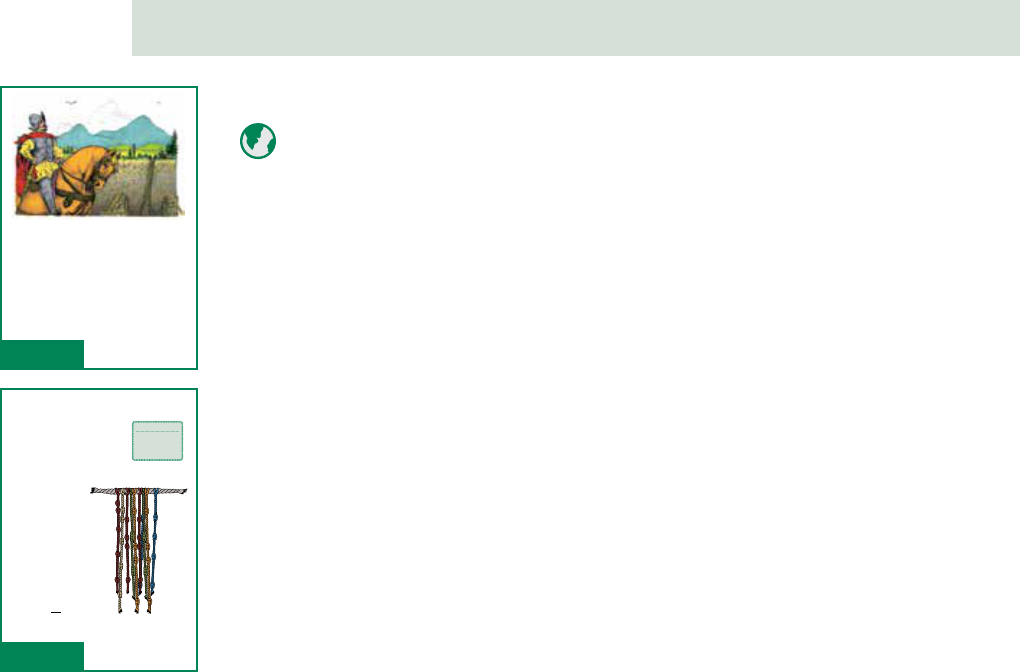
62 GRADE 5 | UNIT 2 | MAYA, AZTEC, AND INCA CIVILIZATIONS
“Bridges Built for the Centuries” and “Mountain Staircases” Pages 47–49
Scaffold understanding as follows:
SUPPORTHave students refer back to AP 1.3 and AP 1.5 to review the
location and key features of the Inca Empire, including the location of the
Andes Mountains.
CORE VOCABULARYChoose a volunteer to read the section
“Bridges Built for the Centuries,” which begins on page 47 and
continues to the top of page 48. Note the term suspension bridge. Call
attention to the word suspension, and explain that to suspend something
is to hang it. In a suspension bridge, therefore, the bridge deck is actually
suspended—hanging—from its supports.
CORE VOCABULARYAsk another volunteer to read the “Mountain
Staircases” section, which begins at the bottom of page 48. Call
attention to the word terraces. Note that this section is entitled “Mountain
Staircases.” Explain that terraces on a hillside are similar to a staircase,
with the terraced fields resembling the treads and the rest of the hillside
resembling the risers.
SUPPORTRemind students that the Inca Empire was very diverse.
Some parts of the empire were very mountainous while others were in
low valleys. The higher you went into the mountains, the more likely there
would be cold temperatures.
After students read the text, ask the following questions:
LITERALHow did the geography of the Inca Empire challenge Inca
builders?
» They had to build roads through mountains and across streams, which
required lots of bridges.
INFERENTIALWhat can you infer from the fact that one of the Inca
bridges remained in use for hundreds of years after it was built?
» This fact implies that the bridge was built to such a high standard that
it remained functional for hundreds of years. It speaks to the skill and
quality of Inca engineering.
LITERALHow did the Inca overcome the challenge of farming on
mountainsides?
» They built terraces into the mountainsides. They also built irrigation
systems for their terraces.
48
It was then used by the Spanish and finally by the people of Peru.
It is one of the greatest achievements of the Inca engineers. It
gained wider fame when it was featured in the classic novel
The Bridge of San Luis Rey, by American writer Thornton Wilder.
Mountain Staircases
The Inca also used their engineering know-how to help them
farm in the Andes. Farming on a mountainside is challenging. The
incline makes every task—plowing, planting, and harvesting—
very difficult. In heavy downpours, water runs downhill and
washes out crops.
The Inca were master bridge builders.
G5_U2_Chap06_SE.indd 48 7/1/16 2:06 PM
Page 48
49
The Inca had to find a way to grow crops on the slopes of the
Andes. Their solution was to cut terraces into the sides of the
mountains. The terraces created level
fields that could be planted and harvested
just like valley fields. The Inca also built
irrigation systems. This allowed them to
bring water to the terraced fields.
Keeping It All Together
The Inca had an advanced
road system, but they had
no written language. How
could they possibly run an
empire of twelve million
people that spanned the
length of a continent
without writing?
The Inca came up with
some clever strategies. For
instance, they invented a
means for counting and
record-keeping using a
quipu (/kee*poo/). A quipu
was a piece of string that
had shorter strings of
various colors dangling
The quipu allowed the Inca to carefully track and keep
records of amounts of troops, food, and other goods
moving through their vast empire.
Vocabulary
terrace, n. a flat
piece of land carved
out of the side of a
mountain or hill
G5_U2_Chap06_SE.indd 49 7/1/16 2:06 PM
Page 49

63CHAPTER 6 | INCA ENGINEERING
“Keeping It All Together,” Pages 49–51
Scaffold understanding as follows:
Have students read the section “Keeping It All Together” to themselves.
After students read the text, ask the following questions:
LITERALHow did the Inca overcome the challenge of a lack of a written
language?
» One solution was the use of a quipu, an object that allowed for record
keeping and sharing of information throughout the empire. They also
used a network of runners to convey messages.
LITERALHow far was a message able to travel each day in the Inca
Empire?
» A message could travel 150 miles in a day.
EVALUATIVEExplain how the roads and communication systems of the
Inca helped keep the empire united and under control.
» Possible answer: Because all parts of the empire were at most just
a few days from news, instruction, or actual government force, the
government was able to maintain strict control over all parts of the
empire. Problems and conflicts were less likely to grow and develop.
“City in the Clouds” and “Expanding the Empire,” Pages 51–53
Scaffold understanding as follows:
Have students read through both sections to themselves. When they
finish, ask the following questions:
LITERALWhere is Machu Picchu located?
» It is seven thousand feet above sea level, in a high valley between
two peaks in the Andes. It’s located about fifty miles northwest
ofCuzco.
LITERALAccording to the text, what is one purpose that the city of
Machu Picchu served in the Inca Empire?
» It was a vacation spot for emperors.
50
from it. By tying knots in a certain pattern on a quipu, an official
could record how many warriors were headed for a village or how
much corn was in a storehouse.
The Inca also used messengers trained to run short distances
to carry news. Since the Inca had no written language, these
messengers did not carry a written note. Instead, a runner
memorized his message and sprinted to a station, a mile or
so away. There, the next runner would be waiting. Without
slowing the pace, the second messenger ran alongside the first
messenger to hear the message. Then the second messenger
continued on.
Fast Inca runners were able to move messages quickly over the full length of the empire.
G5_U2_Chap06_SE.indd 50 7/1/16 2:06 PM
Page 50
51
The system was fast! A message could travel 150 miles in a day.
This meant news could travel all the way from Quito (/kee*toh/)
to Cuzco in a little over a week. In the 1860s, the famous pony
express riders of the American West were only able to cover about
two hundred miles a day—and they rode on horseback!
City in the Clouds
Another marvel of Inca engineering is the famous city of Machu
Picchu (/mah*choo/peek*choo/). Machu Picchu is a mountain
fortress seven thousand feet above sea level, located about fifty
miles northwest of Cuzco. It sits in a high valley, between two
peaks of the Andes.
Today, visitors can stand in the center of Machu Picchu. From
there, they can see the ruins of an open plaza, a temple, and
a place where archaeologists discovered Inca skeletons. The
surrounding hillside is terraced for farming.
Archaeologists estimate that Machu Picchu was built in the
mid-1400s. For years it was a vacation spot for Inca emperors.
Today it is the leading tourist attraction in Peru.
Machu Picchu is not an easy place to visit. Tourists now take a
railroad partway up the mountain. Then they follow a steep,
twisting road to the top. Energetic hikers can walk on an old Inca
trail that climbs up the steep slopes of the Andes.
G5_U2_Chap06_SE.indd 51 7/1/16 2:06 PM
Page 51
52
Expanding the Empire
Like the Aztec, the Inca built their empire by conquering other
people. They also sacrificed human beings for religious purposes.
However, human sacrifice seems to have been less widespread
in the Inca Empire. The Inca focused more on turning conquered
people into loyal subjects.
When conquered people were cooperative, the Sapa Inca made
few changes. Inca architects and managers went to new regions.
Their job was to oversee the building of roads and temples. The
Inca taught their language to the local people. They also asked
The ruins of Machu Picchu rest high in the Andes Mountains.
G5_U2_Chap06_SE.indd 52 7/1/16 2:06 PM
Page 52

64 GRADE 5 | UNIT 2 | MAYA, AZTEC, AND INCA CIVILIZATIONS
INFERENTIALWhat can you infer about the fate of neighboring people
conquered and captured by the Inca?
» They were not used extensively as human sacrifices. Instead,
theywere taken into the empire and made into loyal subjects,
whenpossible.
LITERALWhat methods were used to help newly conquered people
adapt, adjust, and become loyal Inca subjects?
» They were connected to the rest of the empire with roads and
introduced to the Inca language and religion. Their own native religion
was not eliminated and in some cases was incorporated into the Inca
religion.
LITERALHow did the Sapa Inca treat conquered people who were not
cooperative?
» He focused on the troublemakers, removing them to places where
they were surrounded by loyal Inca.
checK for understAndinG 10 min
Ask students to:
• Write a short answer to the Big Question, “How did the Inca use their
engineering skills to manage and grow their empire?”
» Key points students should cite include: They built a network of roads
and bridges that enabled quick transportation and communication
throughout the empire. They found ways to grow food, such as
making terraces on mountainsides and developing irrigation systems.
• Choose one of the Core Vocabulary terms (official, engineer, mortar,
suspension bridge, or terrace), and write a sentence using the word.
To wrap up the lesson, ask several students to share their responses.
Additional Activities
Summary of the Maya, Aztec, and Inca Civilizations (RI.5.1, RI.5.2, RI.5.3) 30 min
Materials Needed: Extra copies of the Summary of the Maya, Aztec, and Inca
Civilizations (AP 2.1) found on page 94 in the Teacher Resources section.
53
them to worship the sun god Inti. The worship of local gods was
allowed. Sometimes those gods were even made a part of the
Inca religion.
If conquered people were uncooperative, the Sapa Inca moved
swiftly. He shipped troublemakers from their homes to villages.
There, they were surrounded by local Inca citizens. He also
shipped loyal Inca citizens to live among the conquered people.
In this way, the Sapa Inca was able to quickly build a large and
unified empire. This empire would endure until the Spanish
conquistadors made their fateful appearance.
G5_U2_Chap06_SE.indd 53 7/1/16 2:06 PM
Page 53
Activity Page
AP 2.1

65CHAPTER 6 | INCA ENGINEERING
Have students take out their Summary of the Maya, Aztec, and Inca Civilizations
(AP 2.1). Some students may have lost their copies; provide themwith an
extra activity page as necessary. Have students complete the Incasections of
the graphic organizer. Encourage students to refer to Chapters5 and 6 of the
Student Reader to help them complete the chart. After the chart is completed,
lead students in a discussion about the Maya, Aztec, and Inca. Ask students
to explain in what ways the three civilizations are similar to and different from
oneanother.
Virtual Field Trip to Machu Picchu (RI.5.7, RI.5.9) 45 min
Materials Needed: Internet access
The following activity is aimed at extending student understanding of and
appreciation for Inca engineering accomplishments.
Background for Teachers: The Inca civilization is famed for its engineering
and building techniques. Inca structures were built of stone, carefully cut and
fitted so that they held together without mortar. Some of these structures have
stood for centuries, withstanding the elements and seismic activity.
One of the most outstanding examples of Inca skill is seen in the ruins
of Machu Picchu. This site, high in the Andes, reveals a great deal about
Incaculture.
Background information about Machu Picchu may be found by using this
primary unit link to the Core Knowledge web page, where specfic links to
UNESCO and National Geographic sites may be found:
www.coreknowledge.org/hgca-g5-maya-aztec-inca-activities
Explore Machu Picchu
Review with students the MachuPicchu360.org map of the layout of
Machu Picchu, found by using the primary unit link. Help students gain an
appreciation for the setting and scale of Machu Picchu by clicking on areas of
the map to view Machu Picchu in panoramic format.
Note to Teachers: The top and bottom of the website feature site sponsors,
including a beer company. Make sure to limit display of the website to just the
map and not the portion below.
Accompany students to the UNESCO and National Geographic websites to see
a number of photographs of Machu Picchu.
66 GRADE 5 | UNIT 2 | MAYA, AZTEC, AND INCA CIVILIZATIONS
Discuss the Virtual Tour of Machu Picchu
Review with students what they have seen and learned about Machu Picchu.
Ask: How does Machu Picchu reveal the many environmental challenges that
faced the Inca? (The mountain environment must have been very difficult to reach,
to build in, and to raise food in.)
Ask: In what ways do the ruins of Machu Picchu reveal the great skill and
ingenuity of the Inca? (The ruins demonstrate the great skill of Inca builders in
cutting and fitting stone together to build long-lasting structures. The terraces
that supported crops and livestock show the way the Inca managed to support
themselves in an inhospitable setting. Also, there is evidence of their understanding
of the stars and sun based on the placement of key buildings.)

67CHAPTER 7 | THE END OF TWO EMPIRES
CHAPTER 7
The End of Two Empires
The Big Question: What were the factors that contributed to the end of the Aztec
and Inca Empires?
Primary Focus Objectives
✓ Describe the Aztec and Inca reactions to the Spanish conquistadors’ arrival in Mexico and South
America. (RI.5.2)
✓ Identify Hernán Cortés and Francisco Pizarro as Spanish conquistadors who led invasions in Mexico
and South America. (RI.5.2)
✓ Explain why the Spanish were rapidly able to conquer the Aztec and Inca Empires. (RI.5.2)
✓ Understand the meaning of the following domain-specific vocabulary: expedition, smallpox,
immunity, and epidemic; and of the phrase “religious ceremony.” (RI.5.4)
What Teachers Need to Know
For more background information about the content taught in this lesson, see:
www.coreknowledge.org/about-spanish-conquerors
Materials Needed
• World Map (AP 1.1); Modern Map of North America, Central America, and
South America (AP 1.3); and Map of Maya, Aztec, and Inca Civilizations
(AP1.5) f
• Enlarged versions of AP 1.1, AP 1.3, and AP 1.5 for reference
Core Vocabulary (Student Reader page numbers listed below)
expedition, n. a special journey taken by a group that has a clear purpose or
goal (56)
Example: The soldiers’ expedition was successful.
Variation(s): expeditions
Activity Pages
AP 1.1
AP 1.3
AP 1.5

68 GRADE 5 | UNIT 2 | MAYA, AZTEC, AND INCA CIVILIZATIONS
“religious ceremony,” (phrase) a special gathering or event that has a
religious purpose or theme (58)
Example: The two people were married in a religious ceremony.
Variation(s): religious ceremonies
smallpox, n. a serious disease that spreads from person to person and causes
a fever and rash (58)
Example: Many people died of a disease called smallpox.
immunity, n. a body’s ability to remain free of illness even after being exposed
to the cause of the illness (58)
Example: The disease spread quickly because nobody had immunity to it.
epidemic, n. a situation in which a disease spreads to many people in an area
or region (59)
Example: As a result of the epidemic, nearly half the students were absent
from school.
Variation(s): epidemics
the core lesson 35 min
Introduce “The End of Two Empires” 5 min
Remind students that in 1492, the Spanish king and queen paid for Christopher
Columbus’s trip that led to his encounter with the Americas, including the
islands in the Caribbean. Explain that, after Columbus, many explorers from
Spain and other European countries also set out on voyages to the Americas.
Tell students that in this chapter they will learn about two groups of Spanish
explorers, who encountered the Aztec and the Inca. Call attention to the Big
Question, and encourage students to look for factors that led to the end of the
Aztec and Inca civilizations as they read.
Guided Reading Supports for “The End of Two Empires” 30 min
When you or a student reads aloud, always prompt students to follow along. By
following along, students may acquire a greater understanding of the content.
Remember also to provide classroom discussion opportunities.
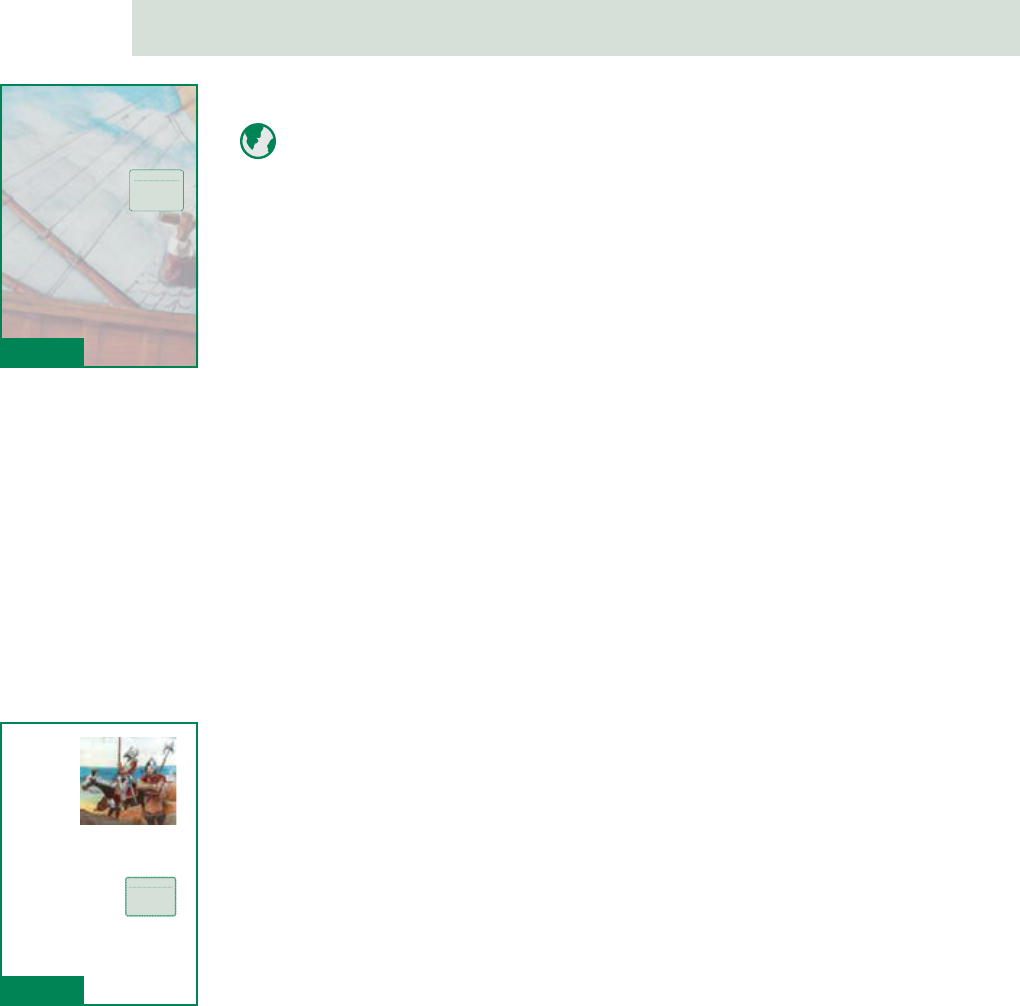
69CHAPTER 7 | THE END OF TWO EMPIRES
“The Question” and “The Answer,” Pages 54–56
Scaffold understanding as follows:
SUPPORT—Review with students the World Map (AP 1.1), Modern Map
of North America, Central America, and South America (AP 1.3), and
Map of the Maya, Aztec, and Inca Civilizations (AP 1.5). Help students
recognize that Spain is a country in Europe, which is separated from
the Americas by thousands of miles and the Atlantic Ocean. In the early
1500s, the people living in the Aztec and Inca Empires did not know that
Europe or Spain existed or that people lived there. The Spanish had only
recently become aware of the existence of the land and people of the
Americas.
Invite a volunteer to read “The Question” on page 54.
Ask students to independently read “The Answer,” beginning on page 54
and continuing to page 56.
After students read the text, ask the following questions:
LITERAL—How did Moctezuma II learn about the arrival of the Spanish in
his territory?
» A traveler carried a report about what he had seen on the coast,
including details about strange things and people.
INFERENTIAL—What can you infer from the strange description the
traveler gave Moctezuma II about what he had seen?
» The Aztec had never seen any human beings so different from
themselves, and they had never imagined things like the Spanish
ships, weapons, and horses. They had no words for these things.
LITERAL—What made Moctezuma think that the newcomers to his land
might be gods?
» They did not look like the Aztec people, and there had been strange
and troubling signs in recent times.
LITERAL—What did Moctezuma do in response to the arrival of strangers
in his land?
» He sent them gifts and tried to welcome them.
Chapter 7
The End of Two Empires
The Question An Aztec poet once
stood atop the Great Temple and
boasted of the greatness of the
Aztec capital, Tenochtitlán. He asked,
“Who could conquer Tenochtitlán?
Who could shake the foundation of
the heavens?” You are about to learn the chilling answer
to those questions.
The Answer
In 1519 Aztec emperor Moctezuma II ruled a mighty empire. One day
a messenger arrived in Tenochtitlán. He had walked all the way from
the Gulf of Mexico with shocking news. “My lord,” the exhausted man
told Moctezuma, “it was a mountain, and it floated on the water.”
What was the traveler talking about? The emperor’s men journeyed
to the coast to find out for themselves. They returned with tales of
white men with thick beards. Like the first messenger, they saw a
“floating mountain.” They also saw other wonders, including “magic
sticks” that belched smoke and “enormous dogs” with flat ears and
long tongues.
54
The Big Question
What were the factors
that contributed to
the end of the Aztec
and Inca empires?
G5_U2_Chap07_SE.indd 54 7/1/16 2:01 PM
Page 54
Horses were another strange sight for the Aztec peopl e.
56
The “floating mountain”
was actually a Spanish
ship. The “magic sticks”
were cannons, and
the “giant dogs” were
horses. The Aztec had
never seen horses or
cannons, and they knew
nothing of sailing ships
or Spaniards. They could
only guess who these
strange beings might be.
Moctezuma remembered the troubling events of recent years.
He guessed that the strangers might be gods come down to
earth. To please them, the emperor sent
golden robes and other gifts. When the
Aztec messengers reached the coast, they
presented these gifts to the leader of the
Spanish expedition, Hernán Cortés
(/er*nahn/kor*tez/).
Hernán Cortés
Cortés was a Spanish explorer. He had taken part in the conquest
of Cuba a few years earlier. In 1519 he set sail from Cuba for
Central America. Like other conquistadors, he hoped to spread
the Catholic religion. He also hoped to get rich. Moctezuma’s
gifts caught Cortés’s attention. He found a native woman, whom
the Spanish called Marina, to serve as his translator and guide.
Vocabulary
expedition, n. a
special journey taken
by a group that has a
clear purpose or goal
G5_U2_Chap07_SE.indd 56 7/1/16 2:02 PM
Page 56

70 GRADE 5 | UNIT 2 | MAYA, AZTEC, AND INCA CIVILIZATIONS
“Hernán Cortés” and “Cortés the Conqueror,” Pages 56–59
Scaffold understanding as follows:
Read aloud the “Hernán Cortés” section beginning on page 56.
Ask a volunteer to read the first two paragraphs of the “Cortés the
Conqueror” section beginning on page 57. Call attention to the phrase
“religious ceremony” on page 58. Ask students if they know the meaning of the
two words that make up this term.
CORE VOCABULARY—Ask another volunteer to read the final
paragraphs on pages 58 and page 59. Note the terms smallpox,
immunities, and epidemic. Invite students to explain how these three terms
are related. (The Aztec did not have immunity to European diseases, one of
which was smallpox. As a result, epidemics occurred, killing many Aztec.)
After students read the text, ask the following questions:
INFERENTIAL—What do you think the text means when it says that the
gifts that Moctezuma sent to Cortés caught Cortés’s attention?
» The gifts made Cortés aware that there were wealthy people living
nearby who could help him fulfill his goal of becoming rich.
LITERAL—What did Cortés encounter as he traveled west toward
Tenochtitlán?
» He encountered many conquered people who had been treated
harshly by the Aztec and who wanted revenge on their conquerors.
LITERAL—What happened when the Spanish first arrived in Tenochtitlán?
» They were welcomed as guests.
EVALUATIVE—Do you think the Spaniards were correct to distrust the
Aztec? Why or why not?
» Possible answer: It is true that Moctezuma had tried to stop the
Spanish from entering the city and that the welcome given to the
Spaniards may not have been sincere. The Spaniards had some basis
for worrying that the Aztec would not put up with them for long.
LITERAL—What did the Spaniards do after they fled Tenochtitlán?
» They rebuilt their army using unhappy subjects of the Aztec Empire.
LITERAL—What factors helped enable the final Spanish conquest of the
Aztec capital?
» The population was weakened by hunger and the effects of disease.
The Spanish army was bolstered by many native fighters and by
superior weapons.
57
Then he set off with his men
toward the Aztec capital.
As he journeyed west, Cortés
marched through areas the
Aztec had conquered. The
people in these areas had
been forced to pay tribute
to the Aztec. They had also
watched their young men
dragged off to Tenochtitlán to
be offered as sacrifices. Many
of the conquered people
Cortés met hoped the
newcomers would help them
get revenge on the Aztec.
Cortés the Conqueror
Moctezuma learned that Cortés was getting support from old
enemies. He tried to talk Cortés out of coming to Tenochtitlán and
even sent magicians to cast spells on the Spaniards. But Cortés
and his men marched on. Moctezuma at last accepted that he
could not stop the Spaniards. So he decided to welcome them as
honored guests.
For a while, all was peaceful in Tenochtitlán. The Spaniards,
however, grew nervous. They knew they were greatly
outnumbered and that even their superior weapons could not
keep them safe. They took Moctezuma hostage. In addition, they
Hernán Cortés came to the Americas with
the goals of conquest and wealth.
G5_U2_Chap07_SE.indd 57 7/1/16 2:02 PM
Page 57
58
demanded that the
emperor order the Aztec
to stop sacrificing to
their gods. Moctezuma
refused. A few weeks
later, fighting broke
out. The Spanish grew
fearful that the Aztec
priests were plotting
against them. The
Spaniards attacked
and killed hundreds
of priests during a
religious ceremony.
The Aztec responded by trying to wipe
out the Spanish. Many men were killed
on both sides. Among the victims was
Moctezuma himself. The Spaniards then
fled Tenochtitlán.
The Spaniards rebuilt their army by
enlisting more of the Aztec’s old enemies.
In 1521, Cortés and his allies surrounded
the capital. With no supplies coming into
Tenochtitlán, city residents began to starve.
An outbreak of smallpox also swept
through the city. This disease was carried
by the conquistadors. The Aztec had no
immunities against European diseases.
After failing to stop Cortés from coming to
Tenochtitlán, Moctezuma welcomed him as a guest.
Vocabulary
"religious ceremony,"
(phrase), a special
gathering or event
that has a religious
purpose or theme
smallpox, n. a
serious disease that
spreads from person
to person and causes
a fever and rash
immunity, n. a
body’s ability to
remain free of illness
even after being
exposed to the cause
of the illness
G5_U2_Chap07_SE.indd 58 7/1/16 2:02 PM
Page 58
59
As a result, the diseases hit very hard and
spread quickly. Warriors, commoners, and
nobles alike died in the epidemic.
In May of 1521, Cortés organized a final
bloody attack. Spanish forces, armed with
guns and cannons and joined by thousands
of native allies, advanced along the causeways. The Aztec fought
bravely but were overwhelmed by their attackers. Meanwhile, the
smallpox epidemic left thousands dead or dying in the streets.
Others were too sick to fight. Tenochtitlán fell in August of 1521.
The once-great city lay in ruins, and the mighty empire of the
Aztec was defeated.
The End for the Inca
A few years later, a similar series of events unfolded in South
America. One day, a messenger dropped to the ground before the
Sapa Inca. He delivered startling news.
“A house!” he exclaimed. “It drifts on the sea along the coast!”
He went on to speak of bearded ones with white skin. They were
masters of lightning and thunder!
The Sapa Inca felt fear. There had been frightening signs in recent
times. Violent earthquakes had split the ground. The sea had
tossed gigantic waves ashore.
Not long after, the bearded ones disappeared in their “sea house.”
But they left something behind—deadly diseases the natives had
never had before. Those along the coast became sick first. Later,
Vocabulary
epidemic, n. a
situation in which a
disease spreads to
many people in an
area or region
G5_U2_Chap07_SE.indd 59 7/1/16 2:02 PM
Page 59
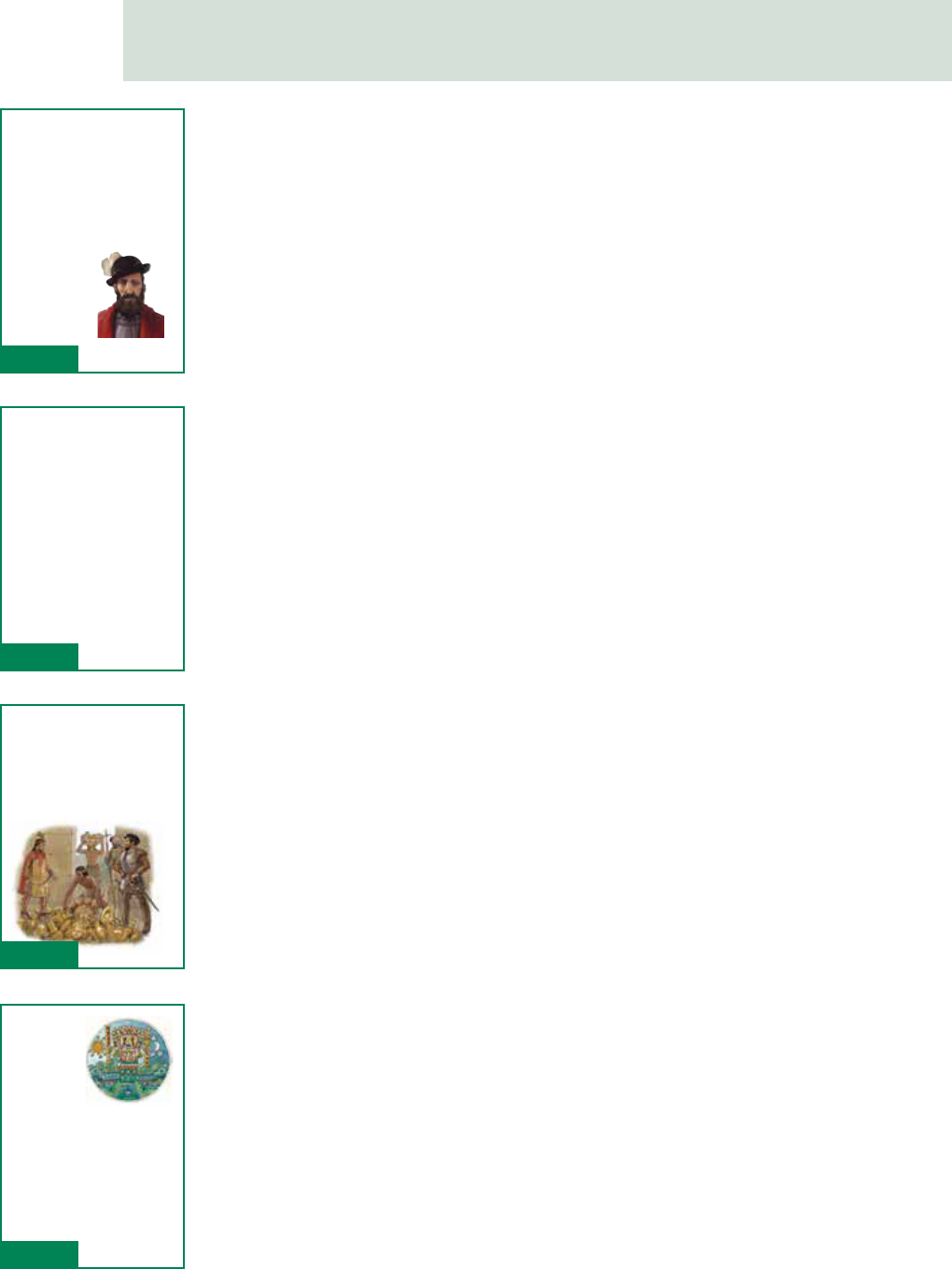
71CHAPTER 7 | THE END OF TWO EMPIRES
“The End for the Inca,” “Francisco Pizarro,” and “A Deadly Bargain,”
Pages 59–63
Scaffold understanding as follows:
Read the section “The End for the Inca” out loud. After reading the text,
ask the following questions:
LITERAL—How were the experiences of the Aztec and Inca with Spanish
explorers similar?
» The Sapa Inca heard a report from a messenger about a strange
bearded people in a huge “floating house” that appeared off the
coast. He felt fear because he connected the Spanish arrival with
strange signs seen in his empire in recent times.
LITERAL—What did the strange Spanish visitors leave behind that
affected the Inca?
» The Spanish brought diseases that had a deadly impact on the Inca.
Scaffold understanding as follows:
Have students read the sections “Francisco Pizarro” and “A Deadly
Bargain” to themselves. After students read the text, ask the following
questions:
LITERAL—What lured Pizarro to the empire of the Inca?
» He had heard rumors of an empire of even greater wealth than the
Aztec Empire. This rumor was confirmed when he came upon an Inca
temple decorated in gold and silver.
INFERENTIAL—What lesson might the Sapa Inca have taken from the
experience of the Aztec if he had had knowledge of what occurred
tothem?
» He might have understood that even a small army of invaders can
topple a mighty empire.
EVALUATIVE—Do you think Pizarro treated the Sapa Inca honorably
when he arranged a meeting at Cajamarca?
» Possible answer: Pizarro tricked the Inca by calling on them as
friends and by hiding his armed forces. Then, he killed thousands of
unarmedInca.
60
travelers carried the diseases inland. The Inca people had no
natural ability to fight off the European germs. They became very
ill and died by the thousands.
When the Sapa Inca died, two of his sons claimed the throne.
This led to a civil war. The fighting was as bloody as any the
Inca people had ever waged. When the battles were over, the
son named Atahualpa (/ah*tah*wahl*pah/) had won. Atahualpa
would not rest easy on his throne, however. Before long, another
message arrived from the coast. The bearded ones had returned!
Francisco Pizarro
The bearded strangers were Spanish conquistadors led by
Francisco Pizarro. Pizarro had heard rumors of an empire in South
America that was even richer than the Aztec Empire. In 1527,
Pizarro led a group of about 160
men to find this empire. When
Pizarro found Inca temples
decorated with gold and silver, he
figured he had found what he was
looking for.
The Spaniards marched toward
Cuzco. They traveled along the
very roads that the Inca had built
to unite their empire. Meanwhile,
speedy Inca messengers told
Atahualpa that the Spaniards were
coming. The Sapa Inca did not
Francisco Pizarro hoped to find even
greater riches in South America than
Cortés found in Tenochtitlán.
G5_U2_Chap07_SE.indd 60 7/1/16 2:02 PM
Page 60
61
take the Spaniards seriously, however. The signs from a few years
earlier had been forgotten during the civil war. Also, the Inca had
no contact with the Aztec. As a result, they had no way of knowing
what had happened to their neighbors to the north. Besides, what
could the mighty Sapa Inca, all-powerful son of the sun, have to
fear from a small band of men?
When the Spaniards approached Atahualpa’s camp near the town
of Cajamarca (/kah*huh*mahr*kuh/), a meeting was arranged.
Atahualpa agreed to meet Pizarro in the town square. It was
here that Pizarro set an ambush. His soldiers hid inside buildings
surrounding the square. Though well-armed, the Spaniards waited
nervously. They knew they were greatly outnumbered.
“They approach!” Pizarro’s lookout shouted. As Pizarro had
requested, Atahualpa came as a friend. The Sapa Inca had left his
warriors outside the city. He was marching into Cajamarca with
six thousand unarmed nobles and attendants.
When the Sapa Inca reached the main square, a startling figure
stepped from a doorway. A Spanish priest, dressed in a white
robe and black hood, walked toward the Sapa Inca’s group.
Spanish laws forbade Pizarro from attacking without warning.
Before using force, he had to ask the enemies to surrender and
become Christians peacefully. So the priest urged Atahualpa to
accept Christianity. The priest offered a Catholic prayer book to
Atahualpa. The insulted ruler knocked the book to the ground.
This was the moment the Spaniards were waiting for. Pizarro had
given the required warning. Now, he gave the signal for attack. The
assault on the unarmed Inca was not a battle. It was a massacre!
G5_U2_Chap07_SE.indd 61 7/1/16 2:02 PM
Page 61
62
Cannons fired. Steel swords slashed. Spaniards on horses charged
around, cutting down the unarmed Inca. Less than an hour later,
Atahualpa was a prisoner, and thousands of Inca people lay dead.
A Deadly Bargain
Atahualpa offered to pay a ransom for his release. The Sapa Inca
placed his hand high on the wall of his prison room. “I will fill
the room to this height with gold,” he told Pizarro. “This I give in
exchange for my freedom.”
The Sapa Inca’s orders went out. His subjects stripped temples of
their gold. They emptied storehouses and gathered up gold that
Atahualpa paid a tremendous ransom in hopes of gaining his freedom from his Spanish captors .
G5_U2_Chap07_SE.indd 62 7/1/16 2:02 PM
Page 62
63
would be worth tens of
millions of dollars today.
Once the Inca paid this
fantastic ransom, Pizarro
broke his promise. He
charged Atahualpa with
plotting against the
Spaniards and had
him executed.
The Sapa Inca’s death
was the beginning ofthe
end for the Inca Empire.
The Inca were highly
successful in battle. But they had been weakened by civil war,
ravaged by deadly diseases, and upset by the loss of their
leader. They were in no condition to oppose the Spaniards. By
June of 1534, Pizarro had conquered Cuzco and Quito. A few years
later, the Spanish conquest of the region was mostly complete.
In twenty years, the Spaniards had destroyed two mighty
empires and set up a new empire of their own. The conquerors
congratulated themselves for stopping human sacrifice and
bringing Christianity to the Americas. However, their greed for
gold and thirst for power also led to the destruction of two of the
most amazing civilizations in history. The changes they had begun
would lead to the deaths of millions of people.
Viracocha was the Inca god of creation. The Inca had
their own deep religious beliefs and did not want to
give them up.
G5_U2_Chap07_SE.indd 63 7/1/16 2:03 PM
Page 63

72 GRADE 5 | UNIT 2 | MAYA, AZTEC, AND INCA CIVILIZATIONS
LITERAL—What did Pizarro do after he collected the ransom offered for
Atahualpa?
» Pizarro ordered the Sapa Inca to be murdered.
INFERENTIAL—What can you infer about the state of the Inca Empire by
its quick collapse following the death of Atahualpa?
» Possible answer: The Inca had had their spirit crushed by the impact of
disease and the death of their leader. The empire quickly fell as a result
of the Spanish attacks.
Timeline
• Show students the Chapter 7 Timeline Image Cards. Read and discuss the
captions, making particular note of any dates.
• Review and discuss the Big Question: “What were the factors that
contributed to the end of the Aztec and Inca Empires?”
• Post the image cards on the right side of the Timeline, under the dates
referencing the 1400s and 1500s; refer to the illustration in the Unit 2
Introduction for further guidance on the placement of each image card
tothe Timeline.
checK for understAndinG 10 min
Ask students to:
• Write a short answer to the Big Question, “What were the factors that
contributed to the end of the Aztec and Inca Empires?”
» Key points students should cite include: The arrival of the Spanish
placed a strain on both empires. The Spanish were able to defeat
both the Aztec and Inca, in part, because they had weapons and
technology that the Aztec and Inca did not have. The Aztec and
Inca were also greatly weakened by disease, which the Spanish
unintentionally introduced to the Americas. The Aztec were made
vulnerable by their harsh treatment of conquered people.
• Choose one of the Core Vocabulary words or the phrase (expedition,
“religious ceremony,” smallpox, immunity, or epidemic), and write a sentence
using the word or phrase.
To wrap up the lesson, ask several students to share their responses.

73CHAPTER 7 | THE END OF TWO EMPIRES
Additional Activities
Domain Vocabulary: Chapters 5–7 (RI.5.4) 15 min
Materials Needed: (1) Sufficient copies of the Domain Vocabulary:
Chapters 5–7 (AP 7.1), (2) pens and pencils for all students.
Distribute Domain Vocabulary: Chapters 5–7 (AP 7.1) found on pages 98 and
99 of the Teacher Resources section. Ask students to use the words in the
word box to complete the statements and then to use the number clues to
find the mystery word. Allow students to work through the activity pages
independently, or arrange students in pairs or groups.
Cortés’s Letter to Charles V (RL.5.2, RI.5.8) 45 min
Materials Needed: (1) Sufficient copies of “Cortés’s Letter to Charles V” (NFE 1),
found in Teacher Resources, pages 101–102.
The following activity is aimed at helping students appreciate the cultural
conflict and interaction that occurred when the Spanish conquistadors arrived
in the Americas, looking to achieve wealth and spread the Catholic religion
among populations they considered to be godless barbarians.
Background for Teachers
This activity focuses on a primary source document from Hernán Cortés to his
king, Charles V. Cortés was among a number of enthusiastic Spaniards who came
to the Americas in the aftermath of Christopher Columbus’s encounter with the
native people of the Americas in 1492. Columbus’s experience motivated other
explorers to set sail with the prospect of wealth and glory. To learn more about
Columbus’s impact on the Americas and about Cortés, use this primary unit link
to the Core Knowledge web page, where a specific link to an article about Cortés
in the Encyclopaedia Britannica may be found:
www.coreknowledge.org/hgca-g5-maya-aztec-inca-activities
Distribute copies of “Cortés’s Letter to Charles V” to students. Read through the
document together as a class, helping students with some of the challenging
vocabulary. For example, you can help students understand that:
• situated (paragraph 1) means “located”
• league (paragraph 1) is a unit of measure that equals about 3.5 miles
• edifice (paragraph 3) means “building”
• habitations (paragraph 3) means “places where people live”
• domestic (paragraph 5) means “having to do with the home”
Activity Page
AP 7.1

74 GRADE 5 | UNIT 2 | MAYA, AZTEC, AND INCA CIVILIZATIONS
• appointments (paragraph 5) means “furnishings”
• prostrated (paragraph 6) means “lay flat on the ground”
After students have finished reading the excerpt, briefly discuss the story as a
class, using the following questions as a guide:
1. What seems to be Cortés’s purpose in writing to his king?
» He seems to be writing to describe the most interesting aspects of
Tenochtitlán for the king.
2. Do you think Cortés is impressed with Tenochtitlán? Why or why not?
» In general, Cortés seems very impressed with Tenochtitlán.
3. Cortés seems to admire many parts of the city. What are some examples of
features he highlights and praises?
» Possible answers: Cortés praises the vitality of the marketplace, the
construction of the buildings, the ingenious water system, and the fine
quality of the houses.
4. What does Cortés imply about the wealth of Moctezuma?
» Cortés implies that Moctezuma is very wealthy and lives in great splendor.
5. What does this letter tell you about the attitude of the Spanish
conquistadors toward the Aztec?
» Students should recognize that the letter shows that the Spanish were
impressed by what they found in Tenochtitlán. The Spanish described
the city as “grand” and made reference to the relative size of the city
compared to ones in Spain, as well as referring to the “grandeur” of its
buildings.
History of the Conquest of Peru (RL.5.2, RI.5.8) 45 min
Materials Needed: (1) Sufficient copies of History of the Conquest of Peru
(NFE 2) found in Teacher Resources, pages 103–105.
The following activity is aimed at helping students appreciate the
military culture of the Inca civilization, including the advanced system
they had developed to mobilize, transport, and care for troops who went
to battle.
Background for Teachers
This activity focuses on a primary source document written in the year 1800 by
William H. Prescott. Prescott’s book focuses on Pizarro’s conquest of the Inca. The
excerpt selected for students to read, however, focuses on Inca military practices.
75CHAPTER 7 | THE END OF TWO EMPIRES
Go to the Encyclopaedia Britannica websites to learn more about Francisco
Pizarro and William H. Prescott. The primary unit link will take you to the Core
Knowledge web page, where the specific links for this information may be found:
www.coreknowledge.org/hgca-g5-maya-aztec-inca-activities
Distribute the History of the Conquest of Peru nonfiction excerpt to students. Read
through the document together as a class, helping students with some of the
challenging vocabulary. For example, you can help students understand that:
• probable (paragraph 1) means “likely to happen”
• contemporaries (paragraph 1) means “people who are about the same age
living at the same time”
• subaltern (paragraph 1) means “low in status”
• casque (paragraph 2) means “helmet”
• sufficed (paragraph 3) means “to be enough”
• magazines (paragraph 4) means “places to store supplies”
• traverse (paragraph 4) means “to go across”
• burghers (paragraph 4) means “wealthy people” (this is a German word)
• prevail (paragraph 5) means “to win or succeed”
• confederated (paragraph 5) means “in an alliance”
• maxim (paragraph 6) means “a short saying”
• benevolence (paragraph 6) means “kindness”
• prudence (paragraph 6) means “caution”
• protracted (paragraph 7) means “long-lasting”
• obstinate (paragraph 7) means “stubborn”
• annals (paragraph 7) means “historical records”
• sanguinary (paragraph 7) means “causing bloodshed”
After students have finished reading the excerpt, briefly discuss the excerpt as
a class, using the following questions as a guide:
1. What was the role of the military in Inca culture?
» People from all levels of society fought in the military. They trained
extensively and were ready to fight at a moment’s notice.
2. How did the weapons and dress of Inca soldiers reflect their rank in society?
» People of lower ranks wore much simpler armor and carried simpler
weapons. People of higher ranks in society adorned their weapons with
gold and silver. They also decorated their armor with things like feathers.
76 GRADE 5 | UNIT 2 | MAYA, AZTEC, AND INCA CIVILIZATIONS
3. What factors made it easier for the Inca to call together the army and march
to war? What does this tell you about the Inca civilization?
» The Inca used their complex system of roads and bridges to move
people from place to place. They also made sure that the soldiers
would have places to stay and places where they would be fed. This
shows that the Inca were well prepared for conflict.
4. The excerpt says about the Sapa Inca, “[H]e allowed his troops to commit
no unnecessary outrage on person or property.” What does this statement
tell you about the Inca?
» The Sapa Inca, even though his people were at war, did not want
them to cause any damage that did not absolutely have to happen to
win. This shows that the Inca were a benevolent people, even to their
enemies. It also reflects the fact that the Inca wanted to include the
people they conquered in their empire.
5. Why do you think the Inca took care of their soldiers by providing food and
shelter and letting them return home if they had been gone for too long?
» The Inca knew it was important to take care of your soldiers. If the
soldiers are unhappy or unhealthy, they’re less willing and able to fight
for the empire.

77TEACHER RESOURCES
UNIT 2
Teacher Resources
Unit Assessment: Maya, Aztec, and Inca Civilizations 78
Performance Task: Maya, Aztec, and Inca Civilizations 83
• Performance Task Scoring Rubric 85
• Performance Task Activity: Maya, Aztec, and Inca Civilizations 86
• Maya, Aztec, and Inca Civilizations Performance Task Notes Table 87
Activity Pages
• AP 1.1 World Map 88
• AP 1.2 World Geography 89
• AP 1.3 Modern Map of North America, Central America,
and South America 90
• AP 1.4 Geography of the Americas 91
• AP 1.5 Map of the Maya, Aztec, and Inca Civilizations 92
• AP 1.6 Geography of the Maya, Aztec, and Inca Civilizations 93
• AP 2.1 Summary of the Maya, Aztec, and Inca Civilizations 94
• AP 4.1 Domain Vocabulary: Chapters 1–4 96
• AP 4.2 Create a Codex 97
• AP 7.1 Domain Vocabulary: Chapters 5–7 98
Answer Key: Maya, Aztec, and Inca Civilizations 100
Nonction Excerpts
• Cortés’s Second Letter to Charles V (primary source document, NFE 1) 101
• History of the Conquest of Peru (excerpts from the book
by William Hickling Prescott, NFE 2) 103

78 GRADE 5 | UNIT 2 | MAYA, AZTEC, AND INCA CIVILIZATIONS
Name Date
Unit Assessment: Maya, Aztec, and Inca Civilizations
Circle the letter of the best answer for each question.
1. Where was the Maya civilization located?
a) in present-day Argentina
b) in present-day Brazil
c) in and around the Yucatán Peninsula
d) in and around the Andes Mountains
2. What structures would an archaeologist most likely find among the ruins of a Maya city?
a) canals
b) suspension bridges
c) causeways
d) ball courts
3. The Maya had advanced scientific knowledge, but they did not develop
a) telescopes.
b) a system of numbers.
c) an accurate calendar.
d) a system of writing.
4. Which were the tallest and most important buildings in Maya cities?
a) pyramids
b) storehouses for food
c) observatories to study the stars
d) ball courts
5. Where did the Aztec build the capital of their civilization?
a) in Cuzco in present-day Peru
b) in Tenochtitlán in present-day Mexico
c) on an island in the Caribbean
d) in the rainforests of the Yucatán Peninsula
6. Which word best describes the Aztec before they built their empire?
a) sailors
b) farmers
c) wanderers
d) scientists
79TEACHER RESOURCES
7. The Aztec were best known as
a) great road builders.
b) fierce warriors.
c) talented musicians.
d) kindly rulers.
8. Which of the following was not found in both the Maya and Aztec civilizations?
a) the practice of human sacrifice
b) a number of independent city-states
c) impressive cities with grand buildings
d) life built around religion
9. Who was the Aztec ruler in 1519?
a) Hernán Cortés
b) Moctezuma II
c) Atahualpa
d) Francisco Pizarro
10. Which of the following best describes the Aztec government?
a) an empire united under a single ruler
b) a collection of city-states, each with its own ruler
c) tribal groups with no central government
d) a democracy with a president elected by the commoners
11. What was unusual about the Aztec capital Tenochtitlán?
a) It was surrounded by dense rainforest.
b) It had a network of expertly built stone roads.
c) It was built on an island.
d) It was built high in the mountains.
12. What was one reason the Aztec waged war so often?
a) They were always under attack from their neighbors.
b) They needed prisoners for human sacrifices.
c) They believed the gods enjoyed seeing humans fight.
d) They needed more land for growing crops.
13. What region did the Inca rule?
a) central Mesoamerica
b) east coast of Central America
c) Gulf coast of South America
d) Pacific coast of South America
80 GRADE 5 | UNIT 2 | MAYA, AZTEC, AND INCA CIVILIZATIONS
14. Which mountain range runs through the middle of the Inca Empire?
a) Atlas
b) Andes
c) Rockies
d) Himalayas
15. Who was the Sapa Inca?
a) sole ruler of the Inca Empire
b) Inca god of the sun
c) Inca high priest in charge of sacrifices
d) wife of the Inca emperor
16. The He-Who-Sees-Everything was
a) the main Inca god.
b) an Inca tax collector and matchmaker.
c) the Sapa Inca.
d) a priest who lived on top of Machu Picchu.
17. What animal played a central role in the life and culture of the Inca?
a) camel
b) llama
c) horse
d) eagle
18. For what purpose did the Inca use quipu?
a) to cross a river
b) to cure an illness
c) to kill an enemy
d) to record information
19. How were the Inca able to farm on mountainsides?
a) They used alpacas to plow for them.
b) They cut terraces into the land.
c) They planted crops with long roots.
d) They built the Royal Road.
20. What do Cuzco, Machu Picchu, and Quito have in common?
a) They were European diseases.
b) They were Inca gods.
c) They were Inca comunities.
d) They were Inca rulers.
81TEACHER RESOURCES
21. Inca stonework was especially impressive because
a) the Inca had no way to cut stone.
b) there were few flat stones in the Andes.
c) the Inca did not use mortar.
d) earthquakes often knocked down Inca buildings.
22. Which pair of adjectives best describes the way the Aztec and Inca first greeted the Spanish?
a) threatening and violent
b) curious and friendly
c) bored and uninterested
d) bold and angry
23. Who led the Spanish invasion of the Aztec Empire?
a) Francisco Pizarro
b) Christopher Columbus
c) Hernán Cortés
d) Huayna Capac
24. What did Moctezuma and Atahualpa have in common?
a) They were Spanish conquerors.
b) They were emperors taken hostage by the Spanish invaders.
c) They were cities destroyed by the Spanish.
d) They were languages spoken by the Inca and Aztec.
25. Which of the following is not a reason that the Spaniards were able to quickly conquer the Aztec
and Inca empires?
a) Epidemics weakened the native people.
b) Native populations were not fully united behind native rulers.
c) The Spanish had better weapons and military technology.
d) The Spanish forces outnumbered the native forces.

82 GRADE 5 | UNIT 2 | MAYA, AZTEC, AND INCA CIVILIZATIONS
Match each term to its definition.
Terms Definitions
26. empire a) moving around often in search of food
27. engineer b) to give or to kill something for a religious purpose
28. nomadic c) a city that is an independent political state with its own ruling
government
29. temple d) a period of time in which a king or queen rules
30. hieroglyph e) a building with religious use or meaning
31. sacrifice f) a body’s ability to remain free of illness even after being
exposed to the cause of the illness
32. city-state g) a group of countries or territories under the control of
one ruler
33. immunity h) a special journey taken by a group that has a clear purpose
or goal
34. expedition i) someone who uses science and math to design useful objects
or buildings
35. reign j) a picture or symbol representing an idea, an object, a syllable,
or a sound

83TEACHER RESOURCES
Performance Task: Maya, Aztec, and Inca Civilizations
Teacher Directions: The Spaniards who came to the Americas and eventually conquered the Aztec
and Inca empires expressed admiration for the wealth and achievements of the civilizations they
encountered.
Ask students to write a brief essay about the achievements of the Maya, Aztec, and Inca civilizations.
Encourage students to use their Student Readers to take notes and organize their thoughts about the
great achievements of the Maya, Aztec, and Inca on the table provided.
A sample table, completed with possible notes, is provided below to serve as a reference for teachers,
should some prompting or scaffolding be needed to help students get started. Individual students
are not expected to provide a comparable finished table. Their goal is to provide four to six specific
examples or arguments about the great achievements of the Maya, Aztec, and Inca civilizations to use
as the basis of their essay.
Achievements Maya Aztec Inca
Science,
Mathematical, and
Engineering Skill
(Including
Inventions and
Architecture)
• Had a highly
accurate calendar
• Had detailed
knowledge of
stars
• Math system
had a zero
and allowed
for complex
calculations
• Built enormous
temples and
pyramids
• Built the city of
Tenochtitlán on
an island in a lake
with complex
of canals and
causeways
• Created floating
gardens to
help feed huge
population
• Built a network
of roads, bridges,
and cities with
expert stonework
• Created terraced
farms on
mountainsides
Writing and Record
Keeping
• Hieroglyphic
writing system
with more than
eight hundred
symbols
• Had a writing
system featuring
pictograms
• Kept records in
codices
• Used quipu to
keep records

84 GRADE 5 | UNIT 2 | MAYA, AZTEC, AND INCA CIVILIZATIONS
Rulers/Government • Created large
city-states
• Created a
huge city and
conquered a large
empire
• Created efficient
administration to
oversee a huge
empire, with
central control of
a population of
twelve million
Cultural Features
(Including Myths
and Religious
Practice)
• Played sacred ball
game
• Recorded beliefs
in Popol Vuh
• Had complex
religious beliefs
featuring human
sacrifice
• Had complex
religious beliefs
featuring human
sacrifice
• Skilled weavers,
used cotton and
wool from alpacas
and llamas
• Had complex
religious beliefs
featuring human
sacrifice

85TEACHER RESOURCES
Performance Task Scoring Rubric
Note: Students should be evaluated on the basis of their written responses, using the rubric.
Students should not be evaluated on the completion of the evidence table, which is intended to be a
support for students as they first think about their written responses.
Above Average Response is accurate and detailed and demonstrates strong background
knowledge of the Maya, Aztec, and Inca civilizations. Student writing includes
at least five examples of impressive achievements, including at least one
from each of the three major civilizations of the Americas. Student writing
uses linking words and phrases to connect ideas, demonstrating strong
understanding of the subject discussed. A few minor errors may be present.
Average Response is mostly accurate and somewhat detailed and demonstrates
background knowledge of the Maya, Aztec, and Inca civilizations. Student
writing includes at least four examples of impressive achievements, including
at least one from each of the three major civilizations of the Americas. Student
writing uses some linking words or phrases to connect ideas. Some minor
errors may be present.
Adequate Response is mostly accurate and demonstrates some background knowledge
of the Maya, Aztec, and Inca civilizations, but the response lacks detail. The
essay gives several facts about the achievements of the great civilizations of
the Americas but does not give examples from each. Student writing may
exhibit issues with organization, focus, and/or control of standard English
grammar.
Inadequate Response is incomplete and demonstrates minimal background knowledge
of content discussed in the unit. Student writing may exhibit major issues with
organization, focus, and/or control of standard English grammar.

86 GRADE 5 | UNIT 2 | MAYA, AZTEC, AND INCA CIVILIZATIONS
Name Date
Performance Task Activity: Maya, Aztec, and Inca Civilizations
The Spaniards who came to the Americas and eventually conquered the Aztec and Inca empires
expressed admiration for the wealth and achievements of the civilizations they encountered. Write an
essay that describes the great achievements of the three civilizations of the Americas—the Maya, Aztec,
and Inca. In your writing, cite at least five different achievements, at least one from each civilization.
Use the table on the next page to take notes and organize your thoughts. You may look back at the
chapters in Maya, Aztec, and Inca Civilizations.

87TEACHER RESOURCES
Name Date
Maya, Aztec, and Inca Civilizations Performance Task Notes Table
Use the table below to help organize your thoughts about the achievements of the Maya, Aztec, and
Inca civilizations. You do not need to complete the entire table to write your response, but you should
try to list five different achievements, at least one from each of the three civilizations.
Achievements Maya Aztec Inca
Science,
Mathematical,
and Engineering
Skill (Including
Inventions and
Architecture)
• Had a highly
accurate calendar
• Created floating
gardens to
help feed huge
population
• Created terraced
farms on
mountainsides
Writing and Record
Keeping
Rulers/Government
Cultural Features
(including Myths
and Religious
Practice)
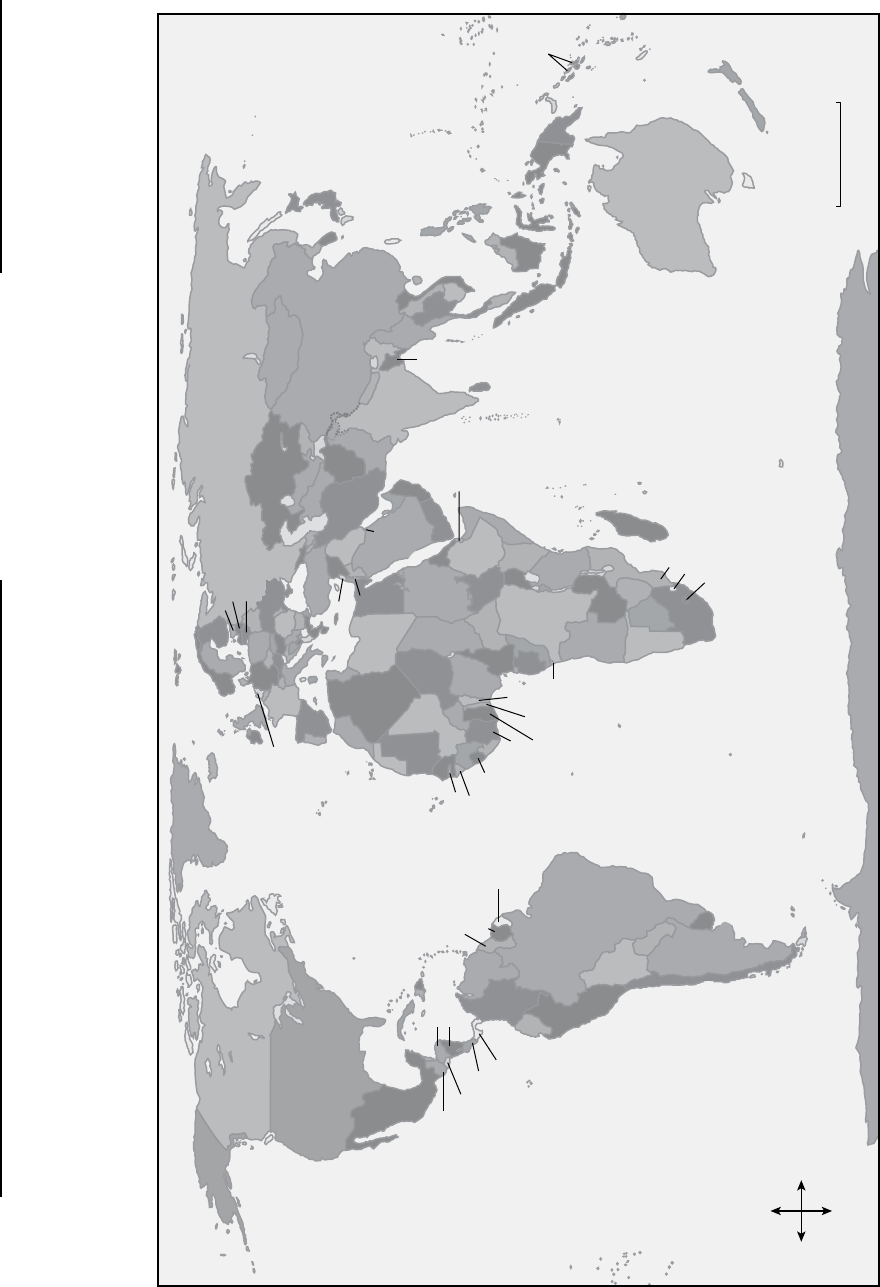
88 GRADE 5 | UNIT 2 | MAYA, AZTEC, AND INCA CIVILIZATIONS
Activity Page 1.1 Use with Chapter 1
World Map
ARCTIC OCEAN
ARCTIC OCEAN
ATLANTIC
OCEAN
ATLANTIC
OCEAN
INDIAN
OCEAN
PACIFIC
OCEAN
PACIFIC
OCEAN
ANTARCTICA
CANADA
MEXICO
CUBA
ICELAND
IRELAND
PORTUGAL
SPAIN
MOROCCO
ALGERIA
LIBYA
MAURITANIA
MALI
NIGER
CHAD
CEN.
AFRICAN
REP.
SOUTH
SUDAN
ETHIOPIA
SOMAILA
DJIBOUTI
SUDAN
YEMEN
KUWAIT
U.A.E
OMAN
IRAN
KAZAKHSTAN
UZBEKISTAN
TURKMENISTAN
AFGHANISTAN
PAKISTAN
TAJIKISTAN
KYRGYZSTAN
CHINA
MONGOLIA
NORTH
KOREA
JAPAN
RUSSIA
SOUTH
KOREA
TAIWAN
PHILIPPINS
SOLOMON
ISLANDS
PAPUA
NEW GUINEA
FUI
NEW
ZELAND
BHUTAN
NEPAL
INDIA
SRI
LANKA
MYANMAR
LAOS
THAILAND
CAMBODIA
VIETNAM
MALAYSIA
INDONESIA
TIMOR-LESTE
BANGLADESH
TURKEY
EGYPT
JORDAN
IRAQ
SYRIA
LEBANON
TUNISIA
ITALY
FRANCE
NETH.
DENMARK
POLAND
GERMANY
HUNGRY
UKRAINE
ROMANIA
BULGARIA
GEORGIA
UNITED KINGDOM
GREECE
SAUDI
ARABIA
SENEGAL
WESTERN SAHARA
NORWAY
SWEDEN
FINLAND
ESTONIA
LATVIA
BELARUS
Svalbard
(Norway)
BELIZE
GUYANA
VENEZUELA
COLOMBIA
ECUADOR
PERU
BOLIVIA
PARAGUAY
URUGUAY
ARGENTINA
HONDURAS
UNITED STATES
GREENLAND
BRAZIL
Alaska
(U.S.)
NORTH
AMERICA
World Map
SOUTH
AMERICA
AFRICA
ASIA
EUROPE
AUSTRALIA
GAMBIA
SIERRA LEONE
LIBERIA
COTE D’IVOIRE
GHANA
GUINEA
BURKINA
FASO
NIGERIA
BENIN
CAMEROON
GABON
CONGO
ANGOLA
NAMIBIA
BOTSWANA
ZIMBABWE
ZAMBIA
MALAWI
MADAGASCAR
TANZANIA
KENYA
DEM.REP.OF
THE CONGO
UGANDA
MOZAMBIQUE
LESOTHO
SOUTH
AFRICA
TOGO
N
S
E
W
GUATEMALA
CHILE
COSTA RICA
PANAMA
EL SALVADOR
NICARAGUA
SURINAME
French
Guiana
(Fr.)
LITHUANIA
ISRAEL
GUINEA-BISSAU
SWAZILAND
ERITERA
0 2000 miles
Name Date

89TEACHER RESOURCES
Name Date
Activity Page 1.2: World Geography Use with Chapter 1
1. What body of water separates the Americas from Europe and Africa?
2. About how many miles by sea are the Americas from Spain?
3. What body of water separates the Americas from Asia and Australia?
4. Which continent is Spain a part of?
5. Which continent is Peru a part of?
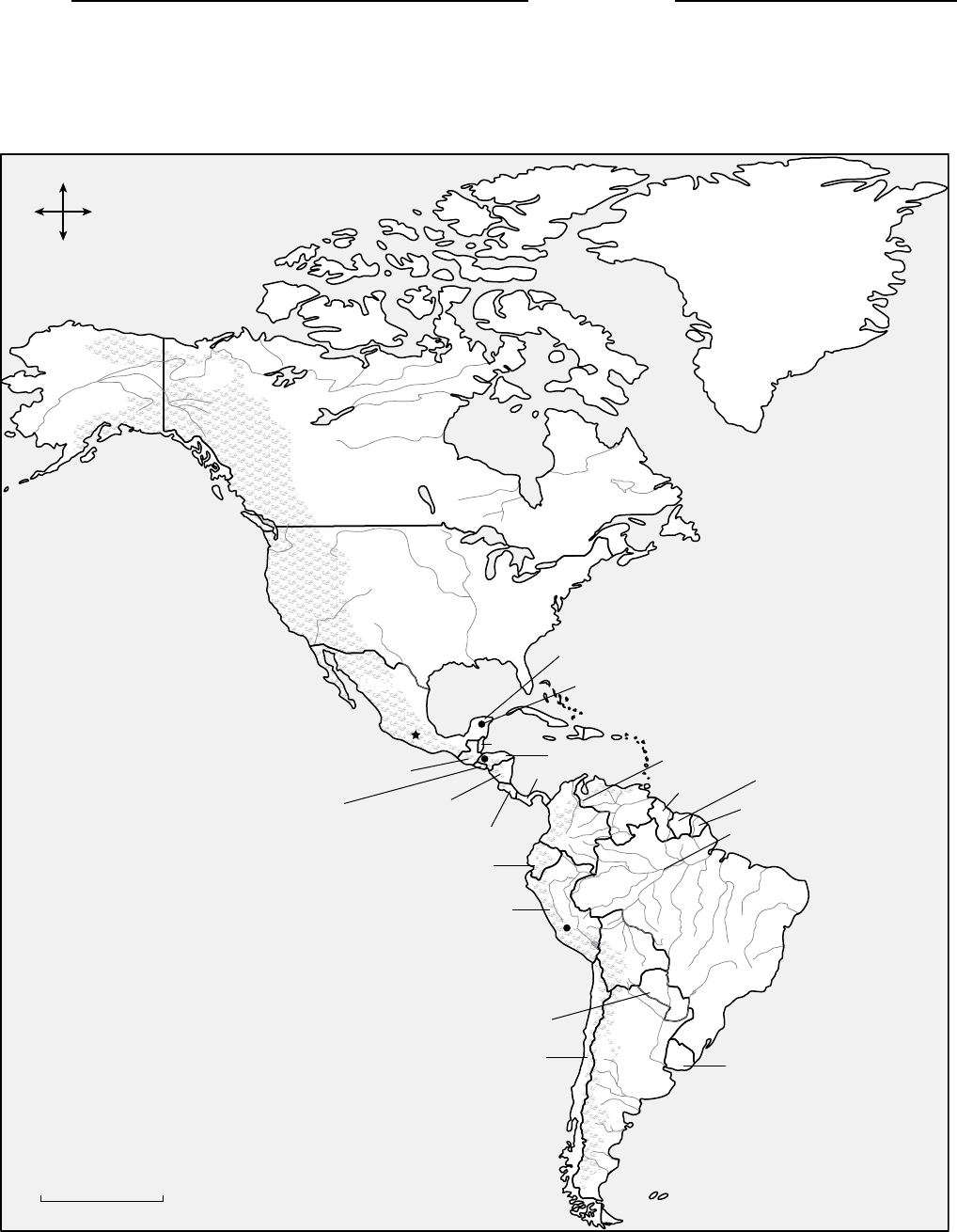
90 GRADE 5 | UNIT 2 | MAYA, AZTEC, AND INCA CIVILIZATIONS
Name Date
Activity Page 1.3: Modern Map of North America, Use with Chapter 1
Central America, and South America
0 2000 miles
ATLANTIC
OCEAN
PACIFIC
OCEAN
Mexico
CENTRAL AMERICA
SOUTH AMERICA
Mexico City
City of Copán
Yucatán Peninsula
Guatemala
Andes Mountains
Chile
Uruguay
Paraguay
El Salvador
Nicaragua
Costa Rica
Belize
Honduras
Venezuela
French Guiana
Suriname
Panama
Colombia
Peru
Amazon River
Cuzco
Chichén Itzá
Bolivia
Argentina
Brazil
Guyana
Gulf of
Mexico
Caribbean Sea
NORTH
AMERICA
United States
N
S
E
W
Ecuador
Modern Map of the Americas

91TEACHER RESOURCES
Name Date
Activity Page 1.4: Geography of the Americas Use with Chapter 1
1. In which country is the largest part of the Yucatán Peninsula found?
2. On which continent are the Andes Mountains located?
3. What major river is located in South America?
4. Name one country in North America.
5. Name three countries in South America.
6. Name the countries in South America that the Andes Mountains pass through.
7. What ocean borders the west coast of South America?
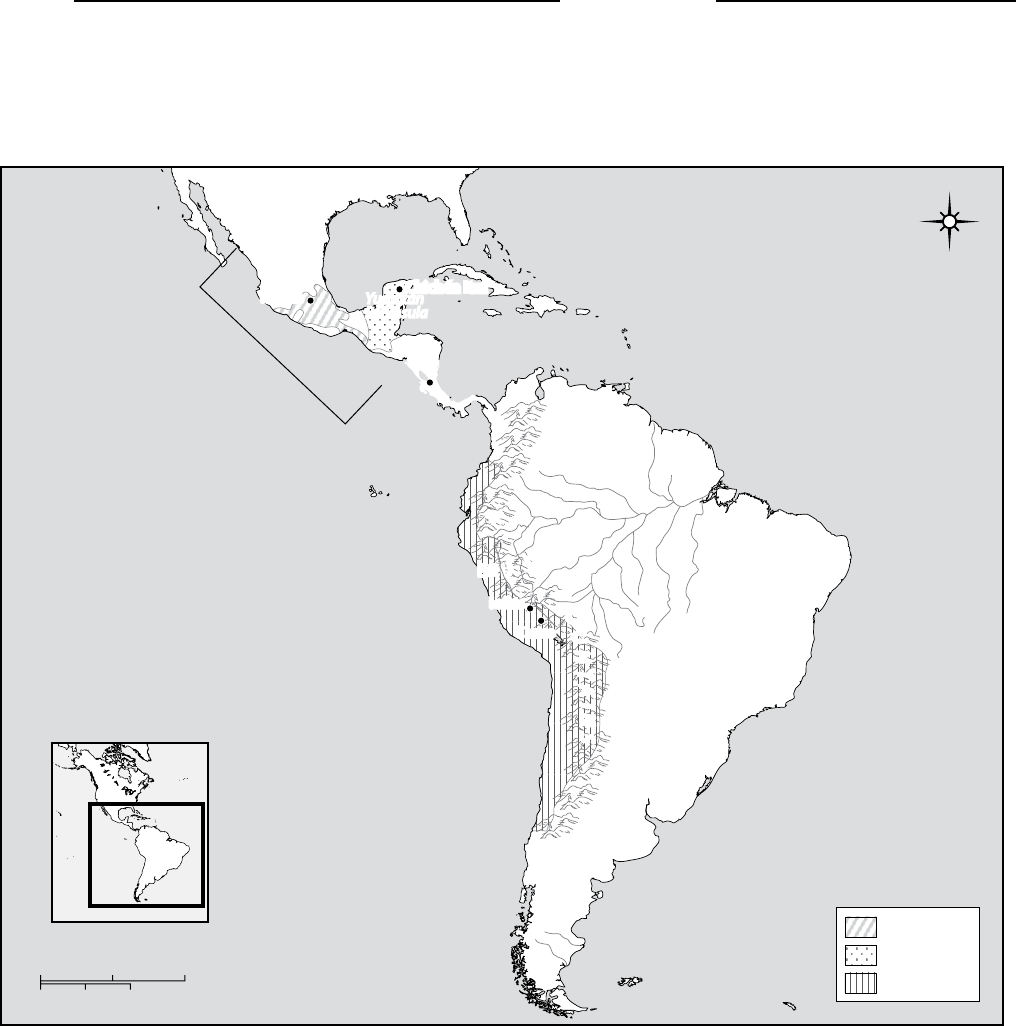
92 GRADE 5 | UNIT 2 | MAYA, AZTEC, AND INCA CIVILIZATIONS
Name Date
Activity Page 1.5: Map of the Maya, Aztec, and Use with Chapter 1
Inca Civilizations
ERU
Cuzco
icchu
htitlán
A
N
D
E
S
M
O
U
N
T
A
I
N
S
A
S
O
U
N
T
A
I
N
S
Yucantán
Peninsula
Yucantán
Peninsula
Gulf of
Mexico
Cuzco
Machu Picchu
Tenochtitlán
Chichén Itzá
Historical region
of Mesoamerica
MEXICO
Aztec Empire
Maya Empire
Inca Empire
0
0 500 1,000 kilometers
1,000 miles500
SOUTH
AMERICA
NORTH
AMERICA
CENTRAL
AMERICA
Copán
ATLANTIC
OCEAN
Amazon
River
PACIFIC OCEAN
W
E
N
S
N
D
E
M
PERU
Map of the Maya, Aztec, and Inca Civilizations

93TEACHER RESOURCES
Name Date
Activity Page 1.6: Geography of the Maya, Aztec, and Use with Chapter 1
Inca Civilizations
1. Which civilizations were located in present-day Mexico and Central America?
2. Which civilization was located in South America?
3. Use the distance scale to estimate the geographic size of the Maya civilization.

94 GRADE 5 | UNIT 2 | MAYA, AZTEC, AND INCA CIVILIZATIONS
Name Date
Activity Page 2.1: Summary of the Maya, Aztec, Use with Chapters 2, 4, and 6
and Inca Civilizations
Fill in the table below with information about each civilization.
Civilizations of the Maya, Aztec, and Inca
Master 18b Grade 5: History & Geography
Copyright ©Core Knowledge Foundation
Name Date
Purpose: To identify major features of Maya, Aztec, and Inca civilizations
Civilization Maya Aztec Inca
Location
Dates of
Existence
Architecture
Religion
Inventions/
Developments
Cultural
Elements
CK_BLM_GR54UPANNOS 2/17/06 11:10 AM Page 24

95TEACHER RESOURCES
Fill in the table below with information about each civilization.
Civilizations of the Maya, Aztec, and Inca
(continued)
Name Date
Civilization Maya Aztec Inca
Language/
Writing
Rulers/
Government
Master 18c Grade 5: History & Geography
Copyright ©Core Knowledge Foundation
Purpose: To identify major features of Maya, Aztec, and Inca civilizations
CK_BLM_GR54UPANNOS 2/17/06 11:10 AM Page 25
Name Date
Activity Page 2.1 (continued)
Fill in the table below with information about each civilization.
Civilizations of the Maya, Aztec, and Inca
(continued)
Name Date
Civilization Maya Aztec Inca
Language/
Writing
Rulers/
Government
Master 18c Grade 5: History & Geography
Copyright ©Core Knowledge Foundation
Purpose: To identify major features of Maya, Aztec, and Inca civilizations
CK_BLM_GR54UPANNOS 2/17/06 11:10 AM Page 25

96 GRADE 5 | UNIT 2 | MAYA, AZTEC, AND INCA CIVILIZATIONS
Name Date
Activity Page 4.1: Domain Vocabulary: Chapters 1–4
Circle the correct term from the options presented to complete each sentence.
Example: The Maya were known for building great structures.
wood stone brick
1. An Aztec was a kind of book made out of folded bark.
codex pictogram scribe
2. The civilization rose in the rainforests of the Yucatán Peninsula.
Aztec Maya nomadic
3. Losers of a Maya pok-ta-pok game might be used as a human .
initiation ceremony sacrifice priest
4. The Maya calendar included a(n) that fell every four years.
leap year equinox codex
5. The Aztec capital was an island connected by to the mainland.
litters canals causeways
6. The Maya civilization was made up of a number of different that often fought
each other.
city-states empires emperors
7. Through the work of , we have learned a lot about the ancient world of
Mesoamerica.
architecture astronomy archaeologists
8. Tenochtitlán was known for its Great Temple, a that rose ninety feet into
theair.
pyramid hieroglyph civilization
9. During the of Moctezuma, Tenochtitlán reached its height of glory.
civilization reign Mesoamerica
10. Maya were responsible for writing down important events in the empire.
scribes hieroglyphs emperors
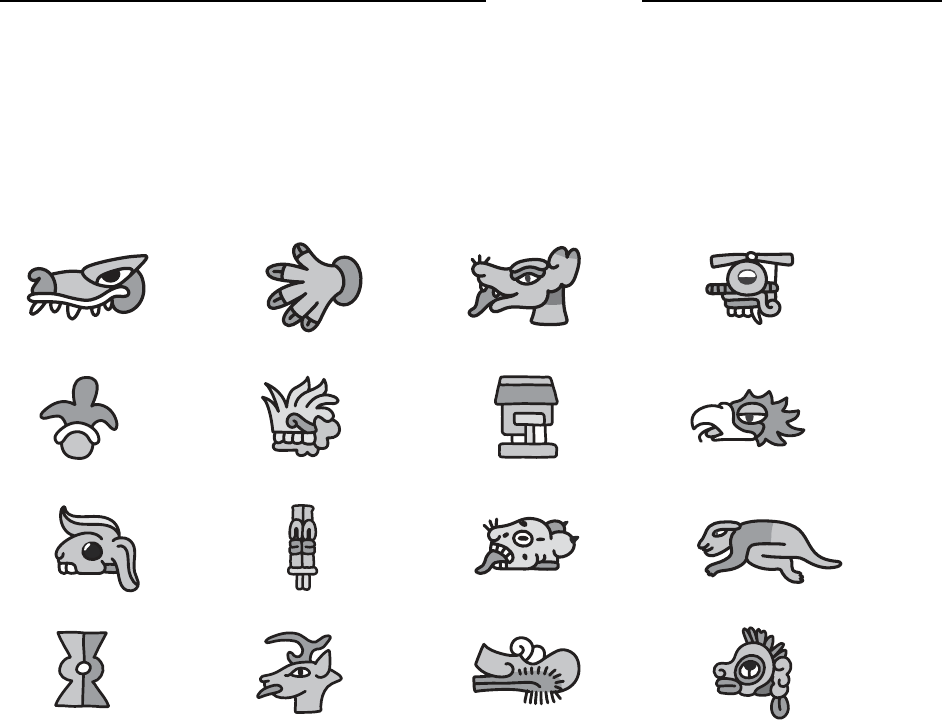
97TEACHER RESOURCES
Name Date
Activity Page 4.2: Create a Codex
Directions
1. Think about the way you travel to school every day. Visualize what the roads are
like and what you see out the window along the way. Write your thoughts down on
a piece of notebook paper.
2. Fold a piece of construction paper six times in an accordion st
yle to make a book.
3. Think of a symbol that represents each idea or object related to your journey to
school. Use a pencil to draw these symbols on each page of the codex. Draw
them in the order in which they occurred during your journey.
4. Color in each symbol.
5. Switch codices with a partner. Try to guess the story that your partner is telling
through the symbols. Let your partner know if he or she is correct.
Create a Codex
Master 17 Grade 5: History & Geography
Copyright ©Core Knowledge Foundation
Name Date
Purpose: To appreciate the objective of the Aztec writing system by using it to write a migration story
Observe the pictures below. They are symbols from the Aztec writing system. These
symbols represent words. A codex, with many symbols, can tell a story.
crocodile water dog rain
flower grass house eagle
rabbit reed jaguar lizard
motion deer wind monkey
CK_BLM_GR54UPANNOS 2/17/06 11:10 AM Page 22

98 GRADE 5 | UNIT 2 | MAYA, AZTEC, AND INCA CIVILIZATIONS
Name Date
Activity Page 7.1: Domain Vocabulary: Chapters 5–7
Use the words to complete each statement. Then, use the number clues to solve the mystery
word.
llama engineers pictograms suspension bridge mortar
smallpox plateau religious ceremony alpaca census
immunity epidemics conquistadors expedition litter
Inca terraces clans geographical diversity ocial
1. The pages of the Aztec codex were covered with
1 2 3 4 5 6 7 8 9 10
.
2. The
11 12 13 14 15 16 17 18 19 20 21 22 23 24 25 26
that crossed the Apurimac River in
Peru got a new set of ropes every two years.
3. The Inca depended on the
27 28 29 30 31 32
for wool and the
33 34 35 36 37
as a
pack animal.
4. In order to set taxes for a village, the Inca first took a
38 39 40 41 42 43
to count how many
people lived there.
5. The world of the Inca included great
44 45 46 47 48 49 50 51 52 53 54 55
56 57 58 59 60 61 62 63 64
, including coastlines, arid plans, and high mountains.
6. Because they had no
65 66 67 68 69 70 71 72
against European diseases, the Aztec suffered
terrible
73 74 75 76 77 78 79 80 81
of diseases such as
82 83 84 85 86 87 88 89
.
7. The Inca were skilled
90 91 92 93 94 95 96 97 98
who were expert at construction.
8. Inca workers cut and fit stones together very carefully and did not use any
99 100 101 102 103 104
.
9. The Inca
105 106 107 108 109 110 111 112
traveled throughout the empire to make sure people
obeyed the laws.

99TEACHER RESOURCES
10. Hernán Cortés led the
113 114 115 116 117 118 119 120 121 122 123 124 125
on
an
126 127 128 129 130 131 132 133 134 135
to the Aztec capital.
11. Human sacrifice was a kind of
136 137 138 139 140 141 142 143 144 145 146 147 148 149 150 151 152
.
12. Wherever he went, the Sapa Inca was carried on a
153 154 155 156 157 158
.
13. The
159 160 161 162
carved
163 164 165 166 167 168 169 170
into the mountainsides to help them farm
the rugged land.
14. Among the land ruled by the Sapa Inca was the broad
171 172 173 174 175 176 177
between the twin
ranges of the Andes Mountains.
15. All Inca people belonged to
178 179 180 181 182
that included several other families.
Mystery Word: We know about the great ancient civilizations of Mesoamerica and South America in
part because of the work of these type of experts.
8 22 38 51 84 90 100 112 123 140 154 170 174 182
Name Date
Activity Page 7.1 (continued)

100 GRADE 5 | UNIT 2 | MAYA, AZTEC, AND INCA CIVILIZATIONS
Answer Key: Maya, Aztec, and Inca Civilizations
Unit Assessment
1. c 2. d. 3. a 4. a 5. b 6. c 7. b 8. b 9. b 10. a 11. c
12. b 13. d 14. b 15. a 16. b 17. b 18. d 19. b 20. c
21. c 22. b 23. c 24. b 25. d 26. g 27. i 28. a 29. e
30. j 31. b 32. c 33. f 34. h 35. d
Activity Pages
World Geography (AP 1.2)
1. the Atlantic Ocean
2. about 4,000 miles at the shortest point
3. the Pacific Ocean
4. Europe
5. South America
Geography of the Americas (AP 1.4)
1. Mexico
2. South America
3. Amazon River
4. Mexico, United States, Canada
5. Brazil, Colombia, Argentina, Peru, Venezuela, Chile,
Ecuador, Bolivia, Paraguay, Uruguay, Guyana,
Suriname, French Guiana
6. Venezuela, Colombia, Ecuador, Peru, Bolivia, Chile,
Argentina
7. Pacific Ocean
Geography of the Maya, Aztec, and Inca
Civilizations (AP 1.6)
1. Maya and Aztec
2. Inca
3. approximately 250 miles wide and 500 miles long
Domain Vocabulary: Chapters 1–4 (AP 4.1)
1. codex
2. Maya
3. sacrifice
4. leap year
5. causeways
6. city-states
7. archaeologists
8. pyramid
9. reign
10. scribes
Domain Vocabulary: Chapters 5–7 (AP 7.1)
1. pictograms
2. suspension bridge
3. alpaca, llama
4. census
5. geographical diversity
6. immunity, epidemics, smallpox
7. engineers
8. mortar
9. official
10. conquistadors, expedition
11. religious ceremony
12. litter
13. Inca, terraces
14. plateau
15. clans
Mystery word: archaeologists

101TEACHER RESOURCES
Nonction Excerpts
Nonction Excerpt 1: Cortes’s Letter to Charles V
In 1520, Hernán Cortés wrote a letter to the king of Spain, Charles V. In this letter, Cortés
describes Tenochtitlán.
This great city of Tenochtitlán is situated in a lake, and from the main land to the
denser parts of it, by whichever route one chooses to enter, the distance is two
leagues. There are four avenues or entrances to the city, all of which are formed
by artificial causeways, two spears’ length in width. The city is as large as Seville
or Cordova; its streets, I speak of the principal ones, are very wide and straight;
some of these, and all the inferior ones, are half land and half water, and are
navigated by canoes. All the streets at intervals have openings, through which the
water flows, crossing from one street to another; and at these openings, some of
which are very wide, there are also very wide bridges. . . . This city has many public
squares, in which are situated the markets and other places for buying and selling.
There is one square . . . where are daily assembled more than sixty thousand souls,
engaged in buying and selling; and where are found all kinds of merchandise that
the world affords. . . .
Every kind of merchandise is sold in a particular street or quarter assigned to it
exclusively, and thus the best order is preserved. They sell everything by number
or measure; at least so far we have not observed them to sell anything by weight.
There is a building in the great square that is used as an audience house, where
ten or twelve persons, who are magistrates, sit and decide all controversies that
arise in the market, and order delinquents to be punished. . . .
This great city contains a large number of temples, or houses, for their idols, very
handsome edifices, which are situated in the different districts and the suburbs; in
the principal ones religious persons of each particular sect are constantly residing,
for whose use, besides the houses containing the idols, there are other convenient
habitations. . . . Among these temples there is one which far surpasses all the rest,
whose grandeur of architectural details no human tongue is able to describe; for
within its precincts, surrounded by a lofty wall, there is room enough for a town
of five hundred families. Around the interior of the enclosure there are handsome
edifices, containing large halls and corridors, in which the religious persons
attached to the temple reside. There are fully forty towers, whichare lofty and well
built, the largest of which has fifty steps leading to its main body, and is higher
than the tower of the principal tower of the church at Seville. . . . All these towers
102 GRADE 5 | UNIT 2 | MAYA, AZTEC, AND INCA CIVILIZATIONS
are the burial places of the nobles, and every chapel in them is dedicated to a
particular idol, to which they pay their devotions. . . .
This noble city contains many fine and magnificent houses; which may be
accounted for from the fact, that all the nobility of the country, who are the vassals
of Moctezuma, have houses in the city, in which they reside a certain part of the
year; and besides, there are numerous wealthy citizens who also possess fine
houses. All these persons, in addition to the large and spacious apartments for
ordinary purposes, have others, both upper and lower, that contain conservatories
of flowers. Along one of these causeways that lead into the city are laid two pipes,
constructed of masonry, each of which is two paces in width, and about five feet in
height. An abundant supply of excellent water, forming a volume equal in bulk to
the human body, is conveyed by one of these pipes, and distributed about thecity,
where it is used by the inhabitants for drink and other purposes. The other pipe,
in the meantime, is kept empty until the former requires to be cleansed, when
the water is let into it and continues to be used till the cleaning is finished. . . .
Reservoirs resembling canals are constructed on the bridges, through which the
fresh water is conveyed. These reservoirs are of the breadth of the body of an ox,
and of the same length as the bridges. . . .
In regard to the domestic appointments of Moctezuma, . . . I know not where to
begin. . . . He was served in the following manner: Every day as soon as it was light,
six hundred nobles and men of rank were in attendance at the palace, who either
sat, or walked about the halls and galleries, and passed their time in conversation,
but without entering the apartment where his person was. . . . The meals were
served in a large hall, in which Moctezuma was accustomed to eat, and the dishes
quite filled the room, which was covered with mats and kept clean. . . .
Both at the beginning and end of every meal, they furnished water for the hands;
and the napkins used on these occasions were never used a second time; this
was the case also with the plates and dishes, which were not brought again; but
new ones in place of them. . . . He is also dressed every day in four different suits,
entirely new, which he never wears a second time. . . . Whenever Moctezuma
appeared in public, which is seldom the case, all those who accompanied him, or
whom he accidentally met in the streets, turned away without looking towards
him, and others prostrated themselves until he had passed. . . .
103TEACHER RESOURCES
Nonction Excerpt 2: History of the Conquest of Peru
(excerpts from the book by William Hickling Prescott)
It seems probable that every Peruvian, who had reached a certain age, might
be called to bear arms. But the rotation of military service, and the regular drills,
which took place twice or thrice in a month, of the inhabitants of every village,
raised the soldiers generally above the rank of a raw militia. The Peruvian army,
at first inconsiderable, came, with the increase of population, in the latter days
of the empire, to be very large, so that their monarchs could bring into the field,
as contemporaries assure us, a force amounting to two hundred thousand men.
They showed the same skill and respect for order in their military organization,
as in other things. The troops were divided into bodies corresponding with our
battalions and companies, led by officers, that rose, in regular gradation, from the
lowest subaltern to the Inca noble, who was entrusted with the general command.
Their arms consisted of the usual weapons employed by nations, whether civilized
or uncivilized, before the invention of powder: bows and arrows, lances, darts, a
short kind of sword, a battle-axe or partisan, and slings, with which they were very
expert. Their spears and arrows were tipped with copper, or, more commonly, with
bone, and the weapons of the Inca lords were frequently mounted with gold or
silver. Their heads were protected by casques made either of wood or of the skins
of wild animals, and sometimes richly decorated with metal and with precious
stones, surmounted by the brilliant plumage of the tropical birds. These, of course,
were the ornaments only of the higher orders. The great mass of the soldiery
were dressed in the peculiar costume of their provinces, and their heads were
wreathed with a sort of turban or roll of different-colored cloths, that produced a
gay and animating effect. Their defensive armor consisted of a shield or buckler,
and a close tunic of quilted cotton, in the same manner as with the Mexicans.
Each company had its particular banner, and the imperial standard, high above all,
displayed the glittering device of the rainbow,—the armorial ensign of the Incas,
intimating their claims as children of the skies.
By means of the thorough system of communication established in the country,
a short time sufficed to draw the levies together from the most distant quarters.
The army was put under the direction of some experienced chief, of the blood
royal, or, more frequently, headed by the Inca in person. The march was rapidly
performed, and with little fatigue to the soldier; for, all along the great routes,
quarters were provided for him, at regular distances, where he could find ample
accommodations. The country is still covered with the remains of military works,
104 GRADE 5 | UNIT 2 | MAYA, AZTEC, AND INCA CIVILIZATIONS
constructed of porphyry or granite, which tradition assures us were designed to
lodge the Inca and his army.
At regular intervals, also, magazines were established, filled with grain, weapons,
and the different munitions of war, with which the army was supplied on its
march. It was the especial care of the government to see that these magazines,
which were furnished from the stores of the Incas, were always well filled. When
the Spaniards invaded the country, they supported their own armies for a long
time on the provisions found in them. The Peruvian soldier was forbidden to
commit any trespass on the property of the inhabitants whose territory lay in the
line of march. Any violation of this order was punished with death. The soldier
was clothed and fed by the industry of the people, and the Incas rightly resolved
that he should not repay this by violence. Far from being a tax on the labors of the
husbandman, or even a burden on his hospitality, the imperial armies traversed
the country, from one extremity to the other, with as little inconvenience to the
inhabitants, as would be created by a procession of peaceful burghers, or a muster
of holiday soldiers for a review.
From the moment war was proclaimed, the Peruvian monarch used all possible
expedition in assembling his forces, that he might anticipate the movements of
his enemies, and prevent a combination with their allies. It was, however, from the
neglect of such a principle of combination, that the several nations of the country,
who might have prevailed by confederated strength, fell one after another
under the imperial yoke. Yet, once in the field, the Inca did not usually show any
disposition to push his advantages to the utmost, and urge his foe to extremity.
In every stage of the war, he was open to propositions for peace; and although he
sought to reduce his enemies by carrying off their harvests and distressing them
by famine, he allowed his troops to commit no unnecessary outrage on person or
property.
“We must spare our enemies,” one of the Peruvian princes is quoted as saying,
“or it will be our loss, since they and all that belongs to them must soon be ours.”
It was a wise maxim, and, like most other wise maxims, founded equally on
benevolence and prudence. The Incas adopted the policy claimed for the Romans
by their countryman, who tells us that they gained more by clemency to the
vanquished than by their victories.
In the same considerate spirit, they were most careful to provide for the security
and comfort of their own troops; and, when a war was long protracted, or
the climate proved unhealthy, they took care to relieve their men by frequent
105TEACHER RESOURCES
reinforcements, allowing the earlier recruits to return to their homes. But while
thus economical of life, both in their own followers and in the enemy, they did
not shrink from sterner measures when provoked by the ferocious or obstinate
character of the resistance; and the Peruvian annals contain more than one of
those sanguinary pages which cannot be pondered at the present day without
a shudder. It should be added, that the beneficent policy, which I have been
delineating as characteristic of the Incas, did not belong to all; and that there
was more than one of the royal line who displayed a full measure of the bold and
unscrupulous spirit of the vulgar conqueror.

Series Editor-In-Chief
E. D. Hirsch, Jr.
President
Linda Bevilacqua
Foundation Staff Members
Will Ashby
Elizabeth Bland
Kathleen Chapman
Christina Erland
Rosie McCormick
Scott Ritchie
Richard Talbot
Sherman Thompson
Subject Matter Expert
Gary Feinman
Illustration and Photo Credits
Adam Gustavson: Cover B, 9a, 21, 33, 42, 48a, 48b, 56, 70, 71
Avi Katz: Cover D, 9d, 9f, 9g, 23, 48, 54a, 54b, 56, 70, 71
Catherine Stoci: 71
Dustin Mackay: 9e, 9h, 56, 61, 63
El Castillo, equinox in Chichen Itza, Mayan, Post Classic period (600–900 AD)/
Chichen Itza, Yucatan, Mexico/Jean-Pierre Courau/Bridgeman Images: 32
Jacob Wyatt: 9i
Mayan pictograms representing the months of the year (ink), French School, 20th
c/Musee de l’Homme, Paris, France/Bridgeman Images: 32
Oliver Dominguez: 20, 34
Robert Marshall: 55, 56, 60–61, 62
Scott Hammond: Cover A, Cover C, i, iii, 9b, 9c, 21, 31–32, 35, 39–40, 40, 47a,
47b, 48, 49, 69
Tyler Pack: 69
View of the Hieroglyphic Stairway, Late Classic Period (600–900 AD) c.760 AD/
Copan, Honduras, Central America/Jean-Pierre Courau/Bridgeman Images: 21
Westend61/Superstock: 63
Within this publication, the Core Knowledge Foundation has provided hyperlinks to independently owned and operated sites whose content we have determined to be of
possible interest to you. At the time of publication, all links were valid and operational and the content accessed by the links provided additional information that supported
the Core Knowledge curricular content and/or lessons. Please note that we do not monitor the links or the content on such sites on an ongoing basis and both may be
constantly changing. We have no control over the links, the content or the policies, information-gathering or otherwise, of such linked sites.
By accessing these third-party sites and the content provided therein, you acknowledge and agree that the Core Knowledge Foundation makes no claims, promises, or
guarantees about the accuracy, completeness, or adequacy of the content of such third-party websites, and expressly disclaims liability for errors and omissions in the either
the links themselves, or the contents of such sites.
If you experience any difficulties when attempting to access one of the linked resources found within these materials, please contact the Core Knowledge Foundation:
Core Knowledge Foundation
801 E. High St.
Charlottesville, VA 22902
Email: coreknow@coreknowledge.org

Maya, Aztec, and Inca Civilizations is available for download at: http://coreknowledge.org/g5-hgca
For information on purchasing print and e-book editions of Maya, Aztec, and Inca Civilizations,
contact the Core Knowledge Foundation at 1-800-238-3233 or customerser[email protected]
Grade 5 – Core Knowledge Curriculum Series
TM
History • Geography • Civics • Arts
1. World Lakes
2. Maya, Aztec, and Inca Civilizations
3. The Age of Exploration
4. The Renaissance
5. The Reformation
6. England in the Golden Age
7. Early Russia
8. Feudal Japan
9. The Geography of the United States
10. Westward Expansion Before the Civil War
11. The Civil War
12. Westward Expansion After the Civil War
13. Native Americans: Cultures and Conflicts
EDITED BY E. D. HIRSCH, JR.
ISBN: 978-1-68380-027-9
